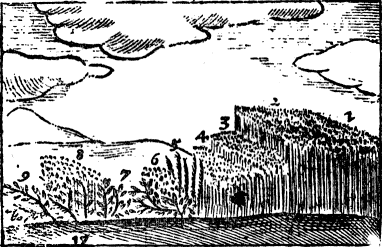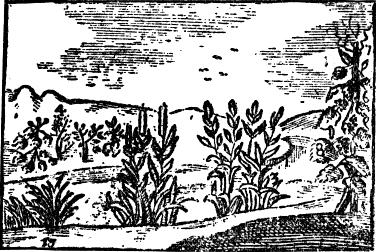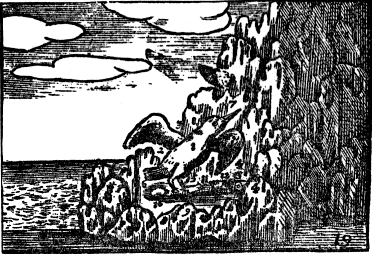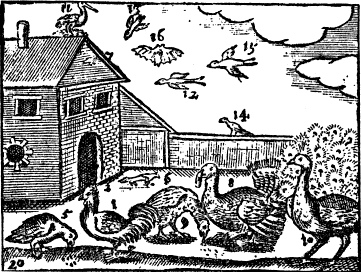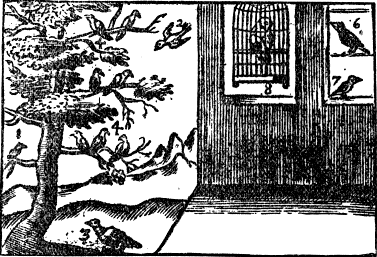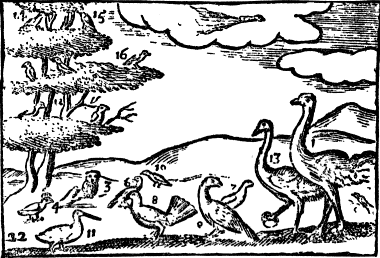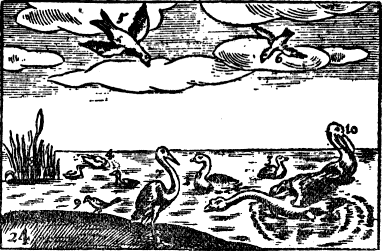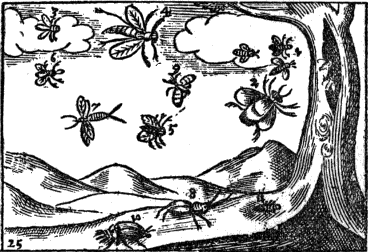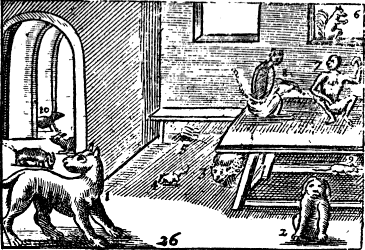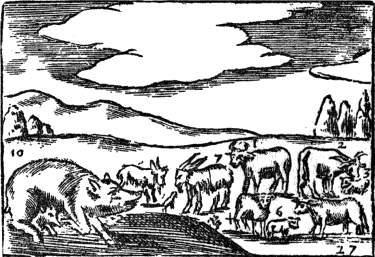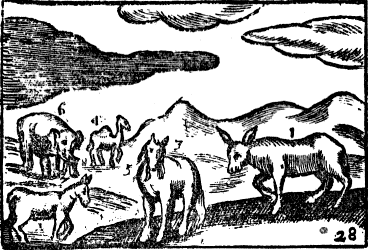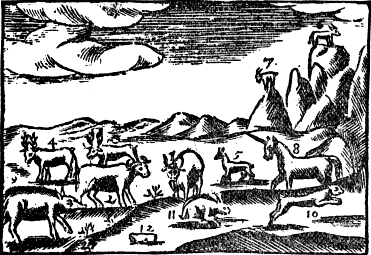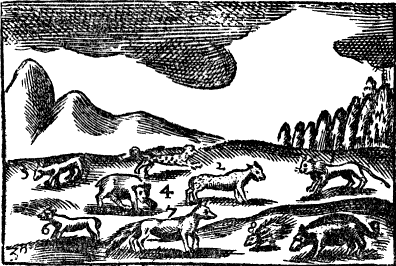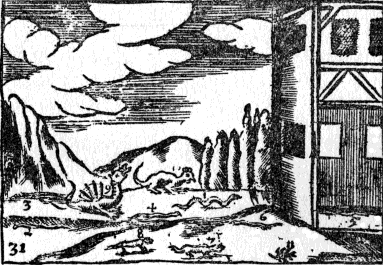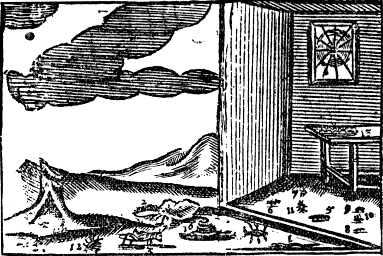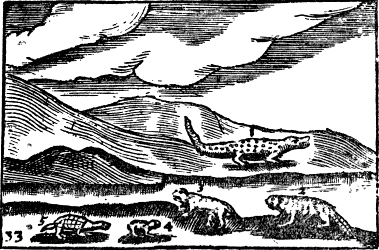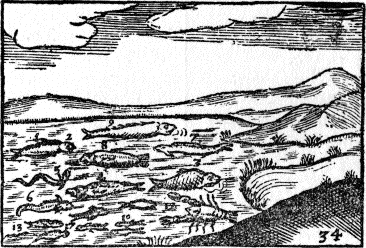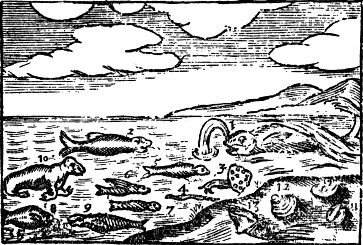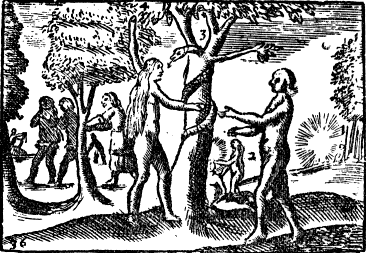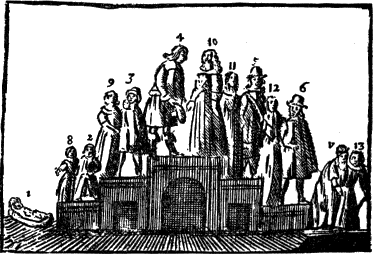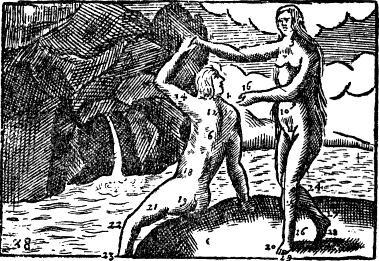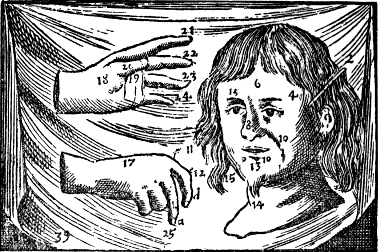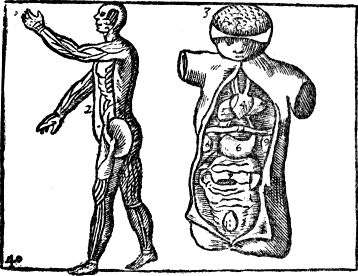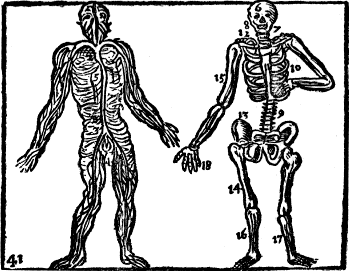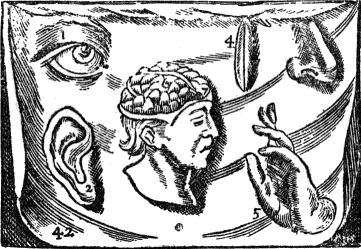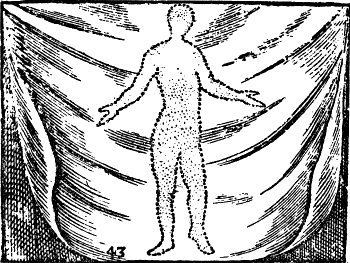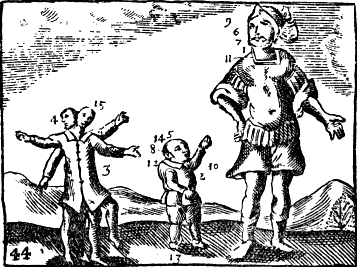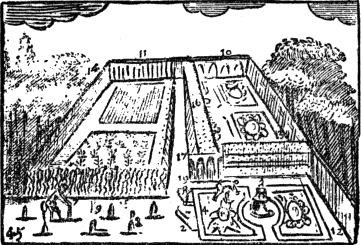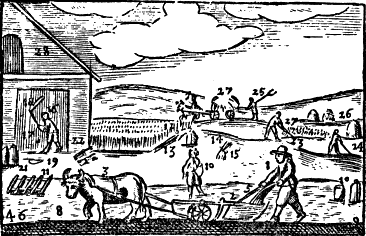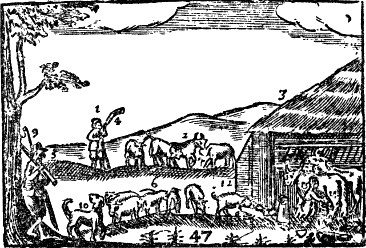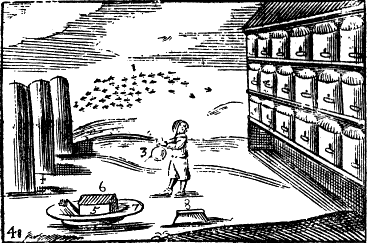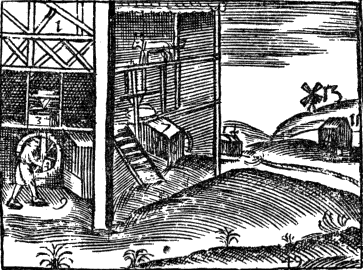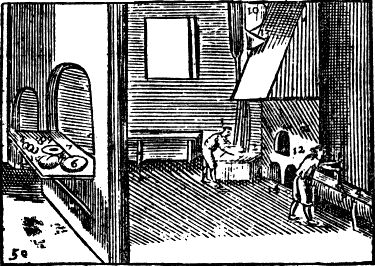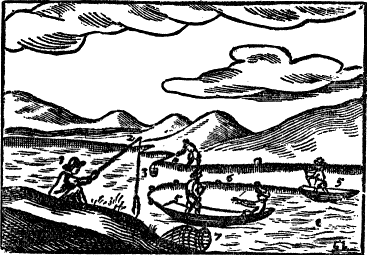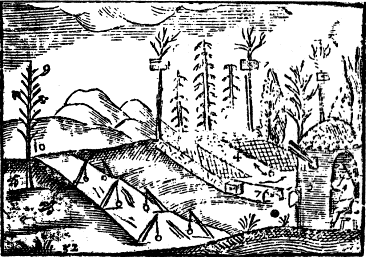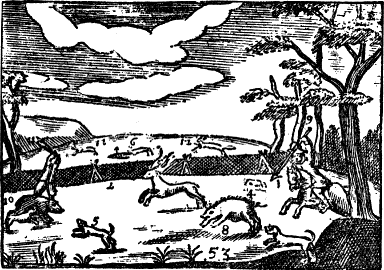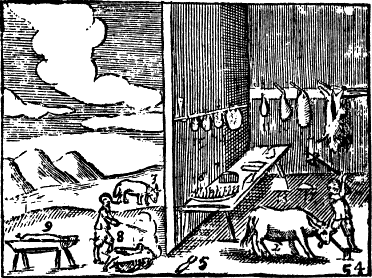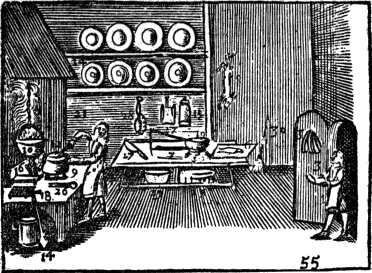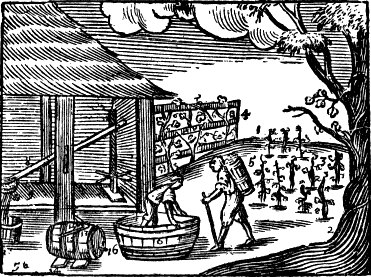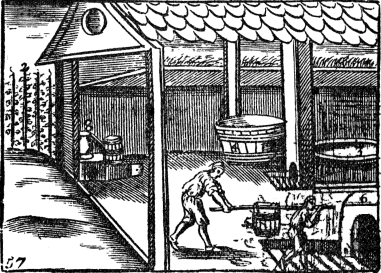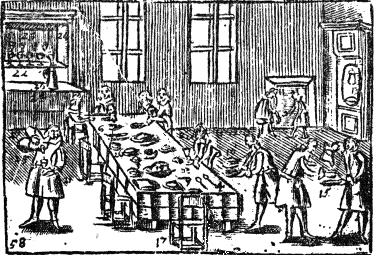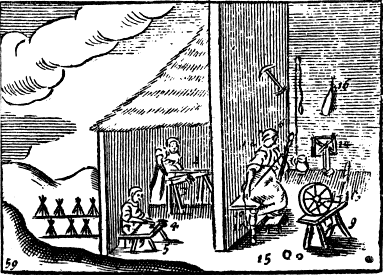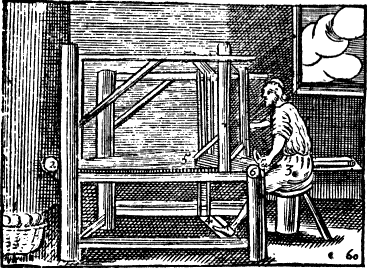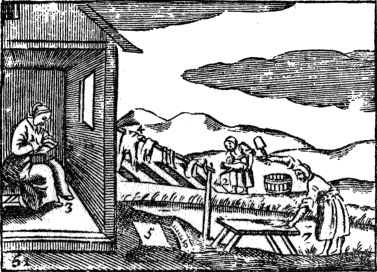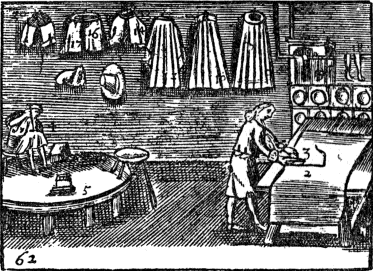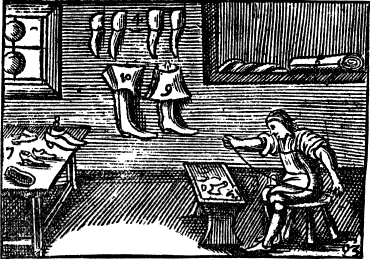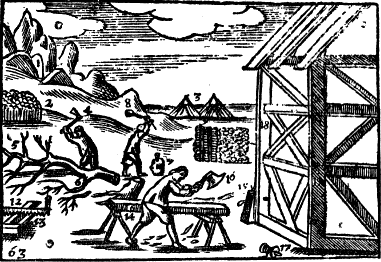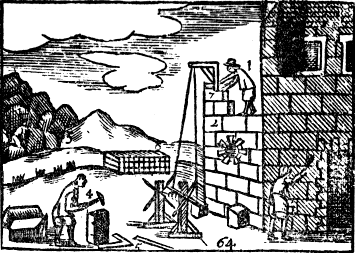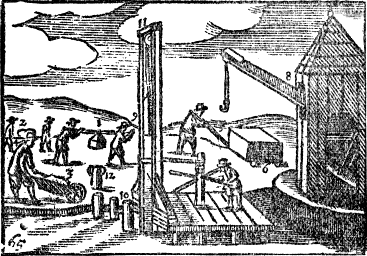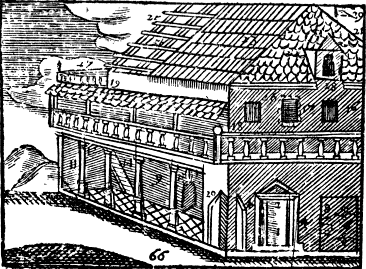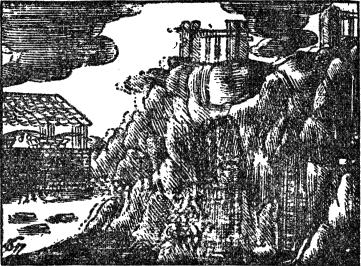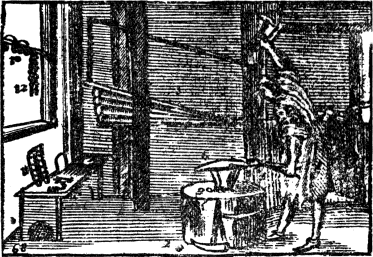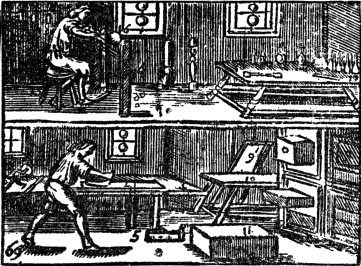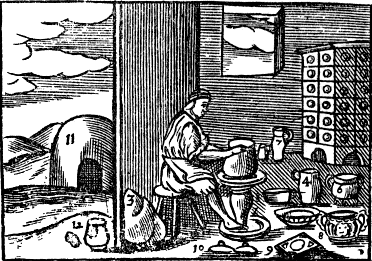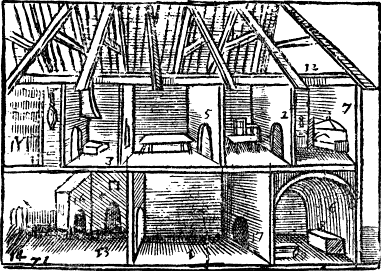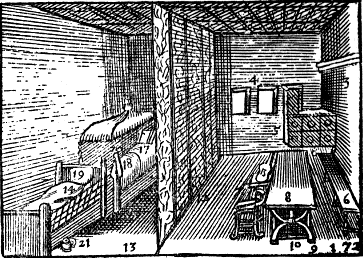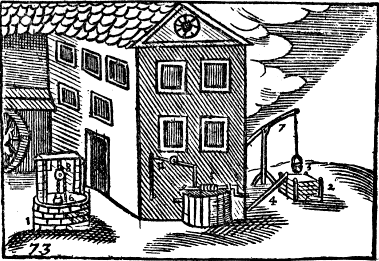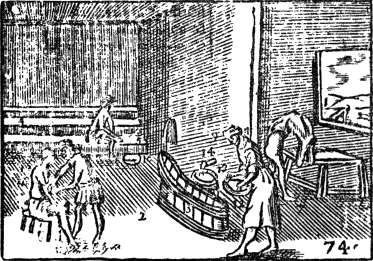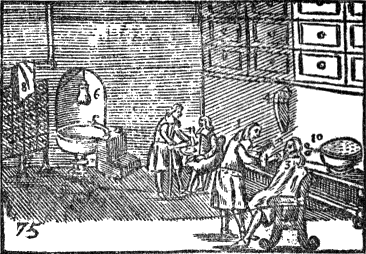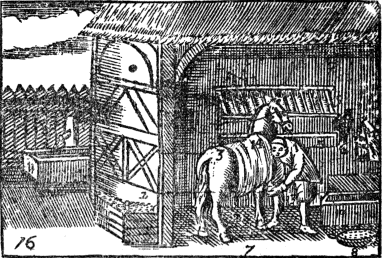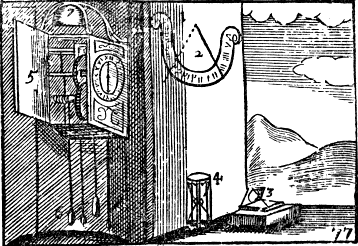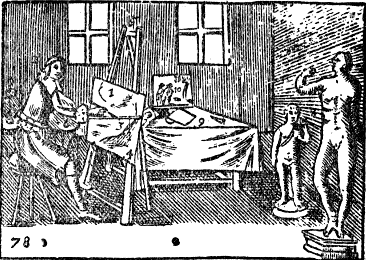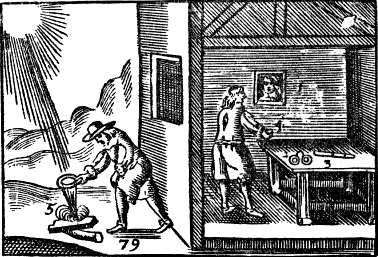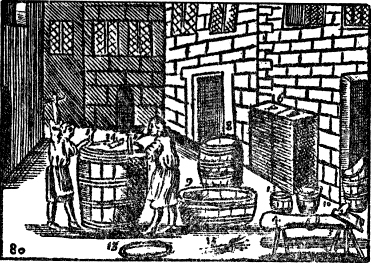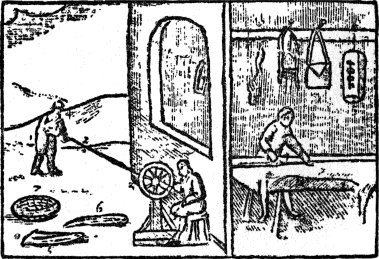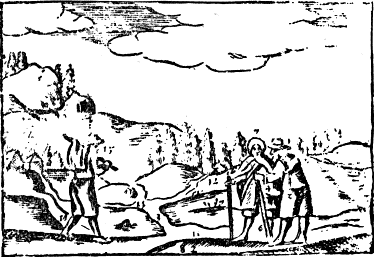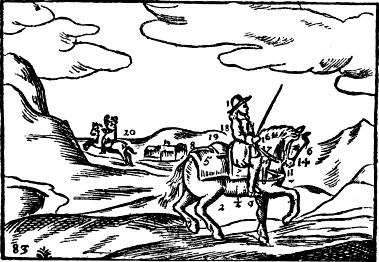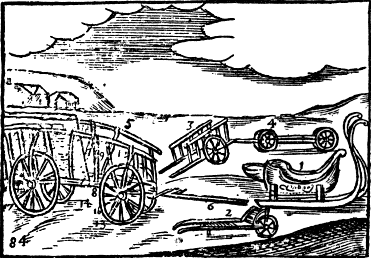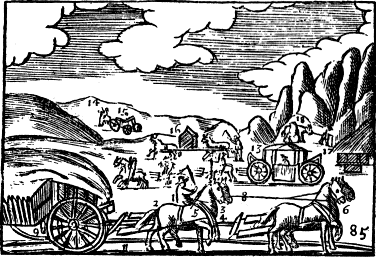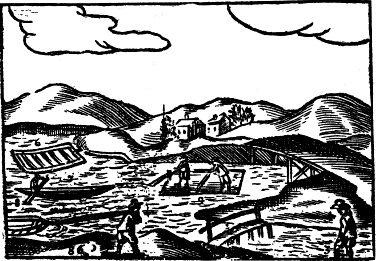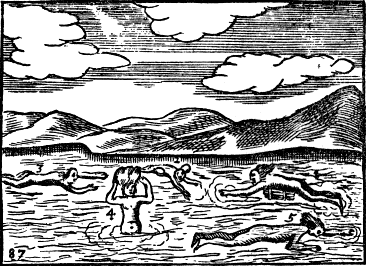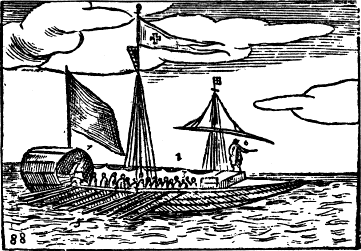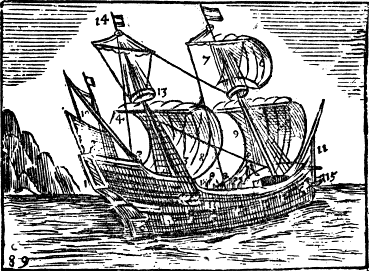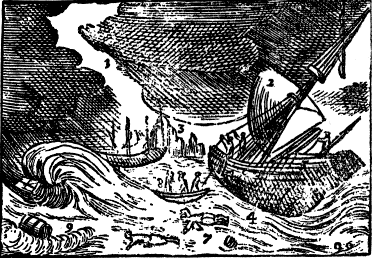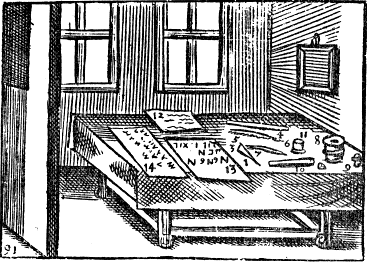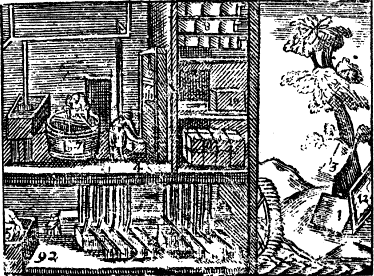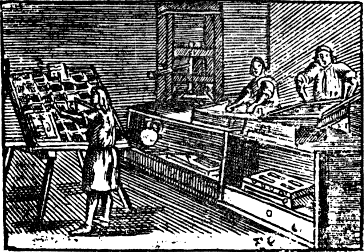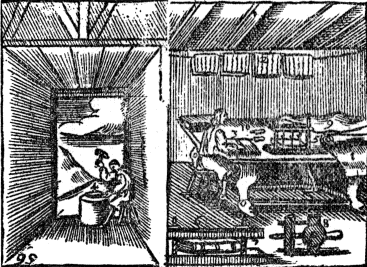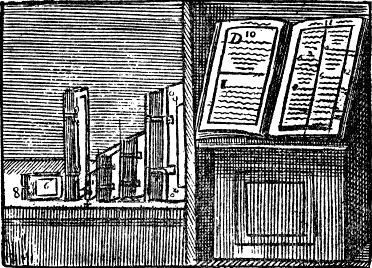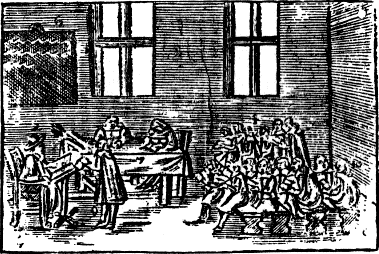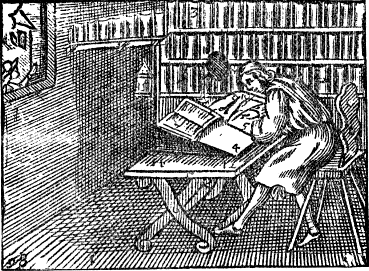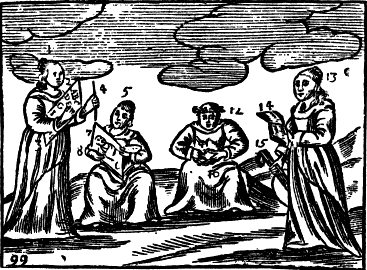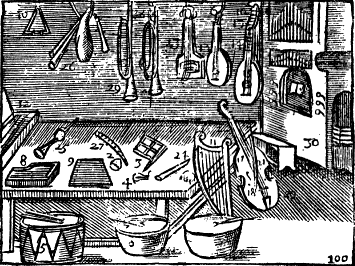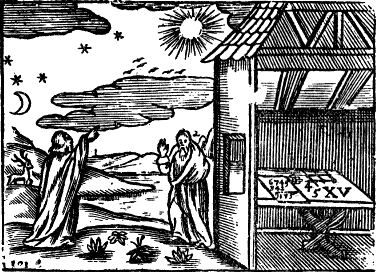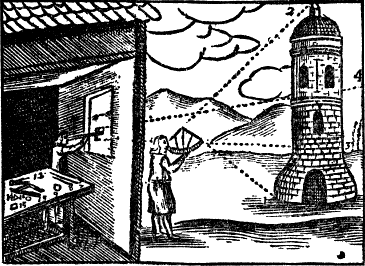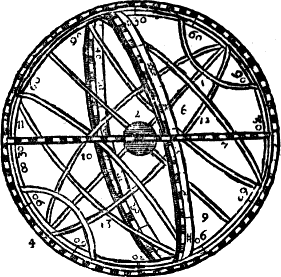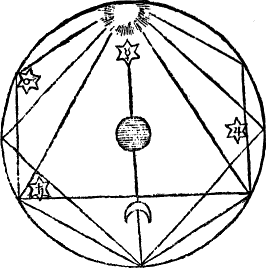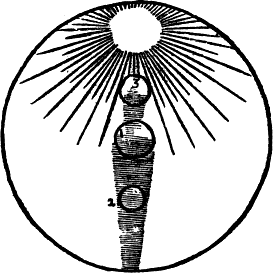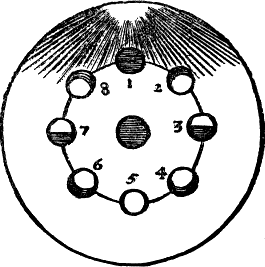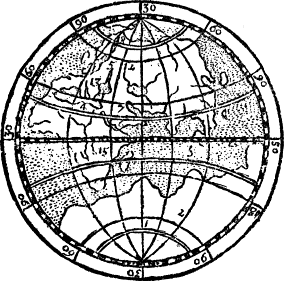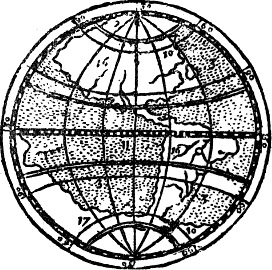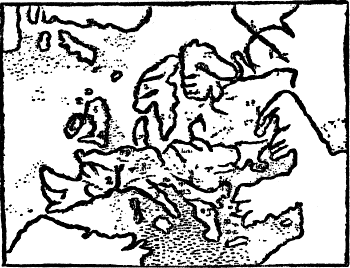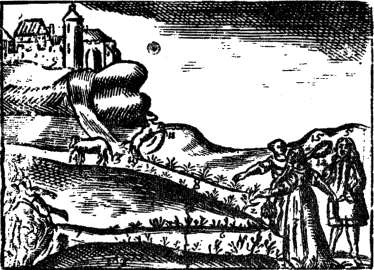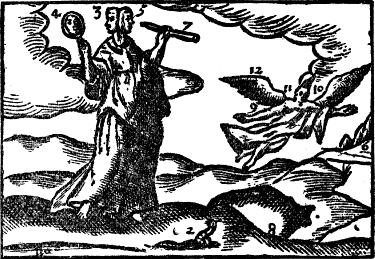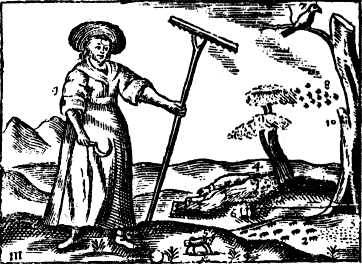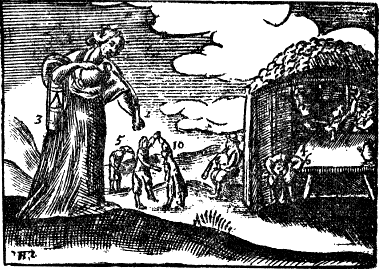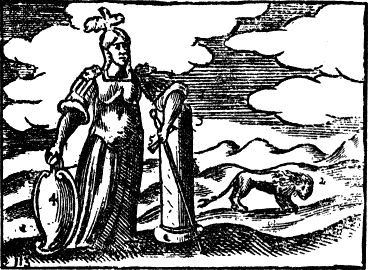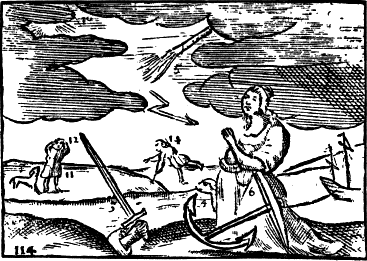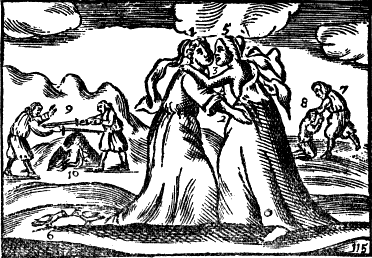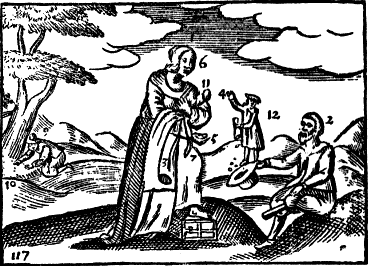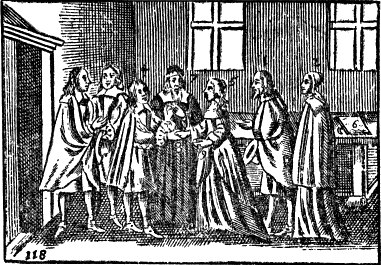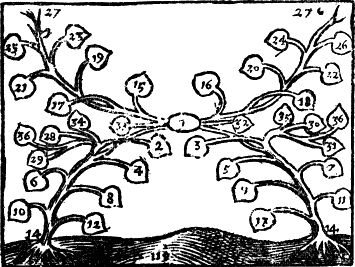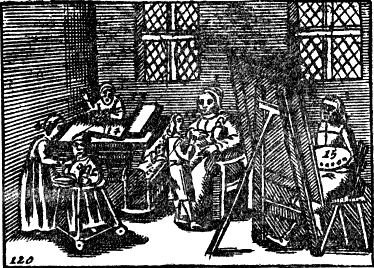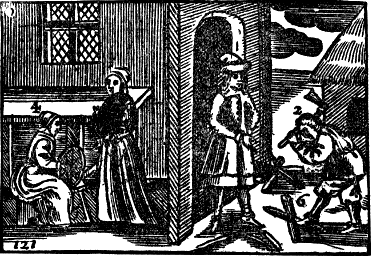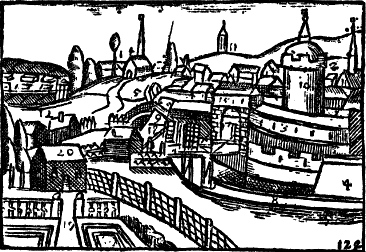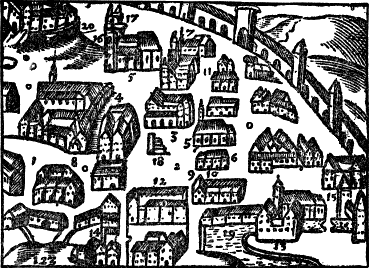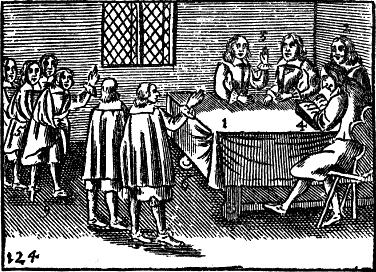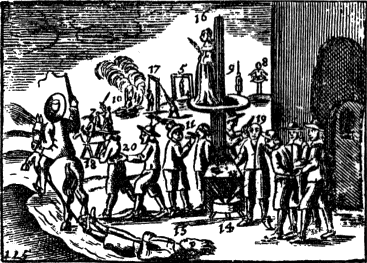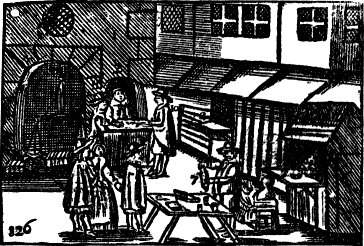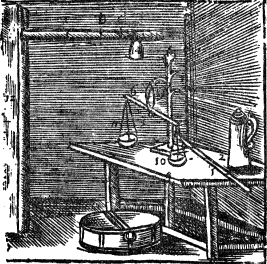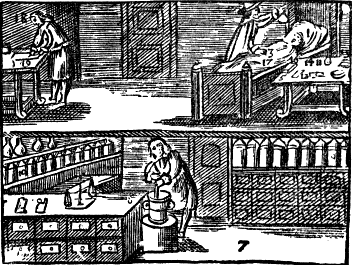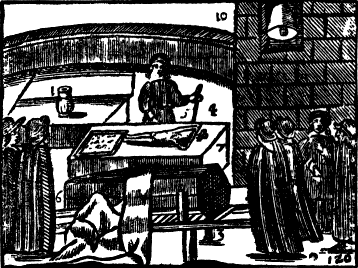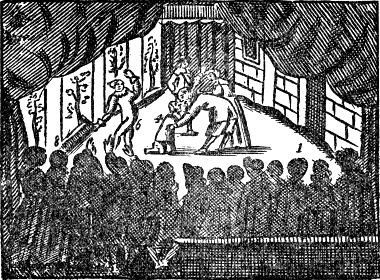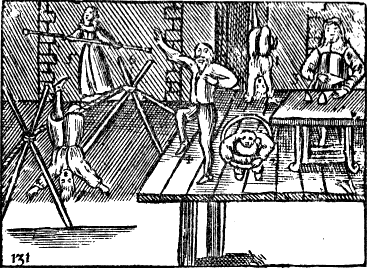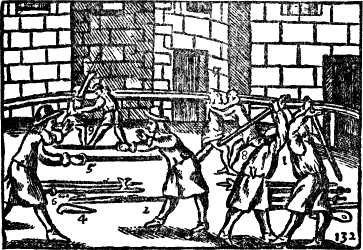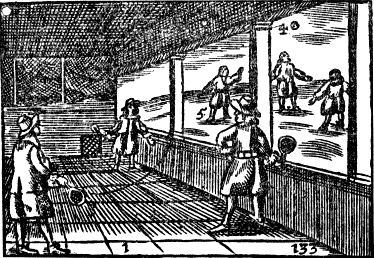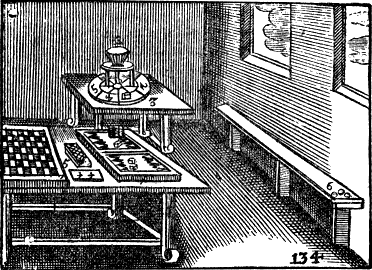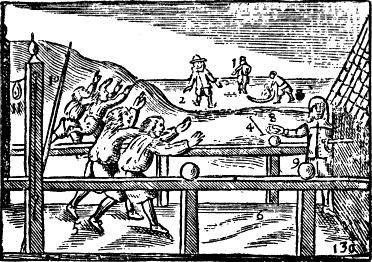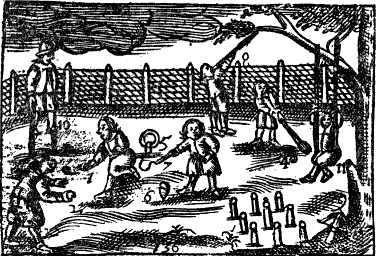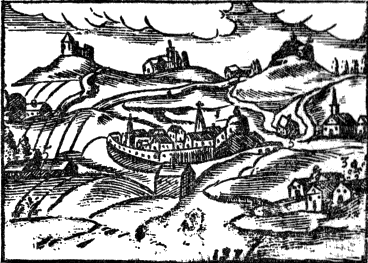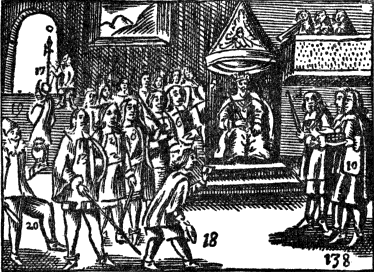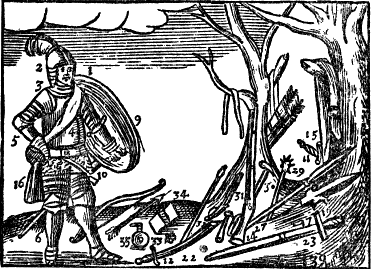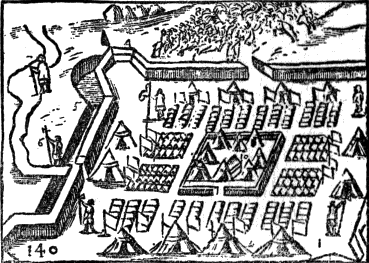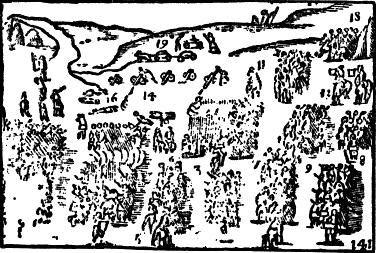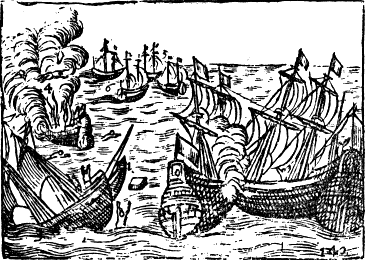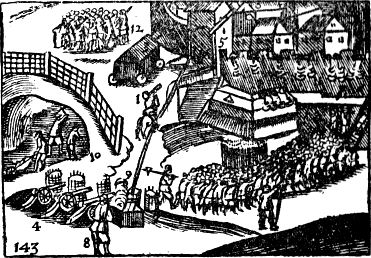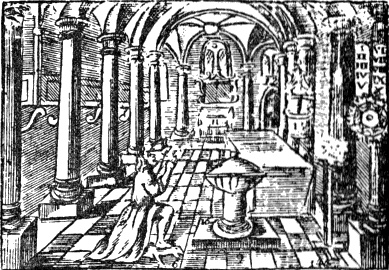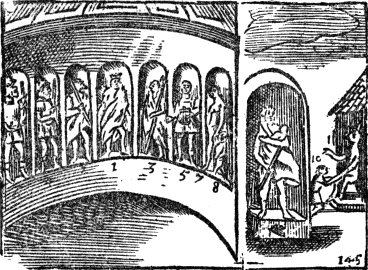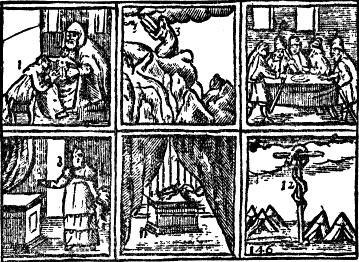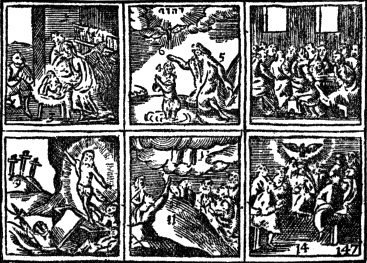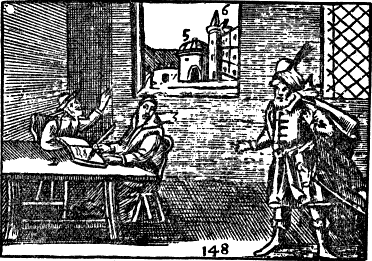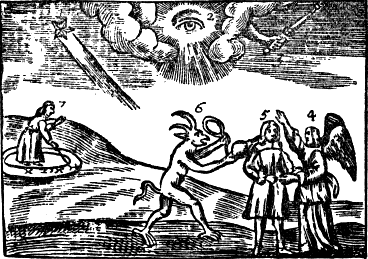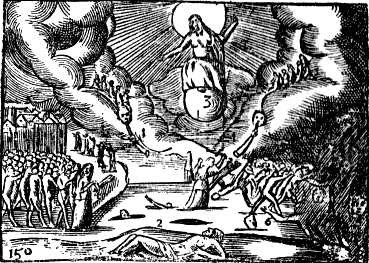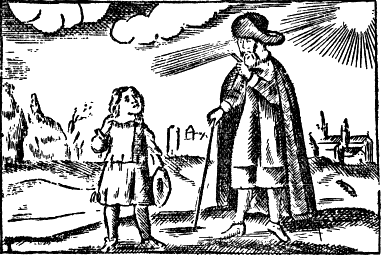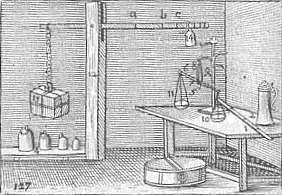Orbis Sensualium Pictus,
A World of Things Obvious to the
Senses drawn in Pictures.
| The Master and the Boy. | Magister & Puer. |
|---|---|
| M. Come, Boy, learn to be wise. | M. Veni, Puer, disce sapere. |
| P. What doth this mean, to be wise? | P. Quid hoc est, Sapere? |
| M. To understand rightly, 2 to do rightly, and to speak out rightly all that are necessary. |
M. Intelligere recte, agere recte, et eloqui recte omnia necessaria. |
| P. Who will teach me this? | P. Quis docebit me hoc? |
| M. I, by God’s help. | M. Ego, cum DEO. |
| P. How? | P. Quomodo? |
| M. I will guide thee thorow all. | M. Ducam te per omnia. |
| I will shew thee all. | Ostendam tibi omnia. |
| I will name thee all. | Nominabo tibi omnia. |
| P. See, here I am; lead me in the name of God. |
P. En, adsum; duc me in nomine DEI. |
| M. Before all things, thou oughtest to learn the plain sounds, of which man’s speech consisteth; which living creatures know how to make, and thy Tongue knoweth how to imitate, and thy hand can picture out. |
M. Ante omnia, debes discere simplices Sonos ex quibus Sermo humanus constat; quos Animalia sciunt formare, & tua Lingua scit imitari, & tua Manus potest pingere. |
| Afterwards we will go into the World, and we will view all things. |
Postea ibimus Mundum, & spectabimus omnia. |
| Here thou hast a lively and Vocal Alphabet. |
Hic habes vivum et vocale Alphabetum. |

|
Cornix cornicatur,
à à The Crow crieth. |
A a |

|
Agnus balat,
b è è è The Lamb blaiteth. |
B b |

|
Cicàda stridet,
cì cì The Grasshopper chirpeth. |
C c |

|
Upupa dicit,
du du The Whooppoo saith. |
D d |

|
Infans ejulat,
è è è The Infant crieth. |
E e |

|
Ventus flat,
fi fi The Wind bloweth. |
F f |

|
Anser gingrit,
ga ga The Goose gagleth. |
G g |

|
Os halat,
hà’h hà’h The Mouth breatheth. |
H h |

|
Mus mintrit,
ì ì ì The Mouse chirpeth. |
I i |

|
Anas tetrinnit,
kha, kha The Duck quaketh. |
K k |

|
Lupus ululat,
lu ulu The Wolf howleth. |
L |

|
Ursus murmurat,
mum mum The Bear grumbleth. |
M m |
4

|
Felis clamat,
nau nau The Cat crieth. |
N n |

|
Auriga clamat,
ò ò ò The Carter crieth. |
O o |

|
Pullus pipit,
pi pi The Chicken peepeth. |
P p |

|
Cúculus cuculat,
kuk ku The cuckow singeth. |
Q q |

|
Canis ringitur,
err The dog grinneth. |
R r |

|
Serpens sibilat,
si The Serpent hisseth. |
S s |

|
Graculus clamat,
tac tac The Jay crieth. |
T t |

|
Bubo ululat,
ù ù The Owl hooteth. |
U u |

|
Lepus vagit,
va The Hare squeaketh. |
W w |

|
Rana coaxat,
coax The Frog croaketh. |
X x |

|
Asinus rudit,
y y y The Asse brayeth. |
Y y |

|
Tabanus dicit,
ds ds The Breeze or Horse-flie saith. |
Z z |
| God is of himself from everlasting to everlasting. |
Deus est ex seipso, ab æterno in æternum. |
| A most perfect and a most blessed Being. |
Perfectissimum & beatissimum Ens. |
| In his Essence Spiritual, and One. |
Essentiâ Spiritualis & unus. |
| In his Personality, Three. | Hypostasi Trinus. |
| In his Will, Holy, Just, Merciful and True. |
Voluntate, Sanctus, Justus, Clemens, Verax. |
| In his Power very great. | Potentiâ maximus. |
| In his Goodness, very good. | Bonitate Optimus. |
| In his Wisdom, unmeasurable. | Sapientiâ, immensus. |
| A Light inaccessible; and yet all in all. |
Lux inaccessa; & tamen omnia in omnibus. |
| Every where, and no where. | Ubique & nullibi. |
| 6
The chiefest Good, and the only and inexhausted Fountain of all good things. |
Summum Bonum, et solus et inexhaustus Fons omnium Bonorum. |
| As the Creator, so the Governour and Preserver of all things, which we call the World. |
Ut Creator, ita Gubernator et Conservator omnium rerum, quas vocamus Mundum. |
| The Heaven, 1. hath Fire, and Stars. |
Cœlum, 1. habet Ignem & Stellas. |
| The Clouds, 2. hang in the Air. |
Nubes, 2. pendent in Aere. |
| Birds, 3. fly under the Clouds. |
Aves, 3. volant sub nubibus. |
| Fishes, 4. swim in the Water. |
Pisces, 4. natant in Aqua. |
| The Earth hath Hills, 5. Woods, 6. Fields, 7. Beasts, 8. and Men, 9. |
Terra habet Montes, 5. Sylvas, 6. Campos, 7. Animalia, 8. Homines, 9. |
| 7
Thus the greatest Bodies of the World, the four Elements, are full of their own Inhabitants. |
Ita maxima Corpora Mundi, quatuor Elementa, sunt plena Habitatoribus suis. |
| The Heaven, 1. is wheeled about, and encompasseth the Earth, 2. standing in the middle. |
Cœlum, 1. rotatur, & ambit Terram, 2. stantem in medio. |
| The Sun, 3. wheresoever it is, shineth perpetually, howsoever dark Clouds, 4. may take it from us; and causeth by his Rays, 5. Light, and the Light, Day. |
Sol, 3. ubi ubi est, fulget perpetuo, ut ut densa Nubila, 4. eripiant eum a nobis; facitque suis Radiis, 5. Lucem, Lux Diem. |
| On the other side, over against it, is Darkness, 6. and thence Night. |
Ex opposito, sunt Tenebræ, 6. inde Nox. |
| 8
In the Night shineth the Moon, 7. and the Stars, 8. glister and twinkle. |
Nocte splendet Luna, 7. & Stellæ, 8. micant, scintillant. |
| In the Evening, 9. is Twilight: |
Vesperi, 9. est Crepusculum: |
| In the Morning, 10. the breaking, and dawning of the Day. |
Manè Aurora, 10. & Diluculum. |
| The Fire gloweth, burneth and consumeth to ashes. |
Ignis ardet, urit, cremat. |
| A spark of it struck out of a Flint (or Firestone), 2. by means of a Steel, 1. and taken by Tynder in a Tynder-box, 3. lighteth a Match, 4. and after that a Candle, 5. 9 or stick, 6. and causeth a flame, 7. or blaze, 8. which catcheth hold of the Houses. |
Scintilla ejus elisa e Silice, (Pyrite) 2. Ope Chalybis, 1. et excepta a Fomite in Suscitabulo, 3. accendit Sulphuratum, 4. et inde Candelam, 5. vel Lignum, 6. et excitat Flammam, 7. vel Incendium, 8. quod corripit Ædificia. |
| Smoak, 9. ascendeth therefrom, which, sticking to the Chimney, 10. turneth into Soot. |
Fumus, 9. ascendit inde, qui, adhærans Camino, 10. abit in Fuliginem. |
| Of a Fire-brand, (or burning stick) is made a Brand, 11. (or quenched stick). |
Ex Torre, (ligno ardente,) fit Titio, 11. (lignum extinctum.) |
| Of a hot Coal (red hot piece of a Fire-brand) is made a Coal, 12. (or a dead Cinder). |
Ex Pruna, (candente particulâ Torris,) fit Carbo, 12. (Particula mortua.) |
| That which remaineth, is at last Ashes, 13. and Embers (or hot Ashes). |
Quod remanet, tandem est Cinis, 13. & Favilla (ardens Cinis.) |
| A cool Air, 1. breatheth gently. |
Aura, 1. spirat leniter. |
| The Wind, 2. bloweth strongly. |
Ventus, 2. flat valide. |
| A Storm, 3. throweth down Trees. |
Procella, 3. sternit Arbores. |
| A Whirl-wind, 4. turneth it self in a round compass. |
Turbo, 4. agit se in gyrum. |
| A Wind under Ground, 5. causeth an Earthquake. |
Ventus subterraneus, 5. excitat Terræ motum. |
| An Earthquake causeth gapings of the Earth, (and falls of Houses.) 6. |
Terræ motus facit Labes (& ruinas.) 6. |
| The Water springeth out of a Fountain, 1. floweth downwards in a Brook, 2. runneth in a Beck, 3. standeth in a Pond, 4. glideth in a Stream, 5. is whirled about in a Whirl-pit, 6. and causeth Fens, 7. |
Aqua scatet è Fonte, 1. defluit in Torrente, 2. manat in Rivo, 3. stat in Stagno, 4. fluit in Flumine, 5. gyratur in Vortice, 6. & facit Paludes, 7. |
| The River hath Banks, 8. | Flumen habet Ripas. |
| The Sea maketh Shores, 9. Bays, 10. Capes, 11. Islands, 12. Almost Islands, 13. Necks of Land, 14. Straights, 15. and hath in it Rocks, 16. |
Mare facit Littora, 9. Sìnus, 10. Promontoria, 11. Insulas, 12. Peninsulas, 13. Isthmos, 14. Freta, 15. & habet Scopulos, 16. |
| A Vapour, 1. ascendeth from the Water. |
Vapor, 1. ascendit ex Aquâ. |
| From it a Cloud, 2. is made, and a white Mist, 3. near the Earth. |
Inde Nubes, 2. fit, et Nebula, 3. prope terram. |
| Rain, 4. and a small Shower distilleth out of a Cloud, drop by drop. |
Pluvia, 4. et Imber, stillat e Nube, guttatim. |
| Which being frozen, is Hail, 5. half frozen is Snow, 6. being warm is Mel-dew. |
Quæ gelata, Grando, 5. semigelata, Nix, 6. calefacta, Rubigo est. |
| In a rainy Cloud, set over against the Sun the Rainbow, 7. appeareth. |
In nube pluviosâ, oppositâ soli Iris, 7. apparet. |
| A drop falling into the water maketh a Bubble, 8. many Bubbles make froth, 9. |
Gutta incidens in aquam, facit Bullam, 8. multæ Bullæ faciunt spumam, 9. |
| Frozen Water is called Ice, 10. Dew congealed, 13 is called a white Frost. |
Aqua congelata Glacies, 10. Ros congelatus, dicitur Pruina. |
| Thunder is made of a brimstone-like vapour, which breaking out of a Cloud, with Lightning, 11. thundereth and striketh with lightning. |
Tonitru fit ex Vapore sulphureo, quod erumpens è Nube cum Fulgure, 11. tonat & fulminat. |
| In the Earth are high Mountains, 1. Deep Vallies, 2. Hills rising, 3. Hollow Caves, 4. Plain Fields, 5. Shady Woods, 6. |
In Terra sunt Alti Montes, 1. Profundæ valles, 2. Elevati Colles, 3. cavæ Speluncæ, 4. Plani campi, 5. Opacæ Sylvæ, 6. |
| A meadow, 1. yieldeth grass with Flowers and Herbs, which being cut down, are made Hay, 2. |
Pratum, 1. fert Gramina, cum Floribus & Herbis quæ defecta fiunt Fænum, 2. |
| A Field, 3. yieldeth Corn, and Pot-herbs, 4. |
Arvum, 3. fert Fruges, & Olera, 4. |
| Mushrooms, 5. Straw-berries, 6. Myrtle-trees, &c. come up in Woods. |
Fungi, 5. Fraga, 6. Myrtilli, &c. Proveniunt in Sylvis. |
| Metals, Stones, and Minerals grow under the earth. |
Metalla, Lapides, Mineralia, nascuntur sub terra. |
| Lead, 1. is soft, and heavy. |
Plumbum, 1. est molle & grave. |
| Iron, 2. is hard, and Steel, 3. harder. |
Ferrum, 2. est durum, & Calybs, 3. durior. |
| They make Tankards (or Cans), 4. of Tin. |
Faciunt Cantharos, 4. e Stanno. |
| Kettles, 5. of Copper, | Ahena, 5, e Cupro, |
| Candlesticks, 6. of Latin, | Candelabra, 6. ex Orichalco, |
| Dollers, 7. of Silver, | Thaleros, 7. ex Argento, |
| Ducats and Crown-pieces, 8. of Gold. |
Scutatos et Coronatos, 8. Ex, Auro. |
| Quick-silver is always liquid, and eateth thorow Metals. |
Argentum Vivum, semper liquet, & corrodit Metalla. |
| Sand, 1. and Gravel, 2. is Stone broken into bits. |
Arena, 1. & Sabulum, 2. est Lapis comminutus. |
| A great Stone, 3. is a piece of a Rock (or Crag) 4. |
Saxum, 3. est pars Petræ (Cautis) 4. |
| A Whetstone, 5. a Flint, 6. a Marble, 7. &c. are ordinary Stones. |
Cos, 5. Silex, 6. Marmor, 7. &c. sunt obscuri Lapides. |
| A Load-stone, 8. draweth Iron to it. |
Magnes, 8. adtrahit ferrum. |
| Jewels, 9. are clear Stones, as |
Gemmæ, 9. sunt pellucidi Lapilli, |
| The Diamond white | ut Adamas candidus, |
| The Ruby red, | Rubinus rubeus, |
| The Sapphire blue, | Sapphirus cæruleus, |
| The Emerald green, | Smaragdus viridis, |
| The Jacinth yellow, &c. | Hyacynthus luteus, &c. |
| And they glister being cut into corners. |
et micant angulati. |
| Pearls and Unions, 10. grow in Shell-fish. |
Margaritæ & Uniones, 10. crescunt in Conchis. |
| 17
Corals, 11. in a Sea-shrub. |
Corallia, 11. in Marinâ arbusculâ. |
| Amber, 12. is gathered from the Sea. |
Succinum, 12. colligitur è mari. |
| Glass, 13, is like Chrystal. |
Vitrum, 13. simile est Chrystallo. |
| A Plant, 1. groweth from a Seed. |
Planta, 1. procrescit e Semine. |
| A plant waxeth to a Shoot, 2. |
Planta abit in Fruticem, 2. |
| A Shoot to a Tree, 3. | Frutex in Arborem, 3. |
| The Root, 4. beareth up the Tree. |
Radix, 4. Sustentat arborem. |
| The Body or Stem, 5. riseth from the Root. |
Stirps (Stemma) 5. Surgit e radice. |
| The Stem divideth it self into Boughs, 6. and green Branches, 7. made of Leaves, 8. |
Stirps se dividit in Ramos, 6. & Frondes, 7. factas e Foliis, 8. |
| 18
The top, 9. is in the height. |
Cacumen, 9. est in summo. |
| The Stock, 10. is close to the roots. |
Truncus, 10. adhærat radicibus. |
| A Log, 11. is the body fell’d down without Boughs; having Bark and Rind, 12. Pith and Heart, 13. |
Caudex, 11. est Stipes dejectus, sine ramis; habens Corticem & Librum, 12. pulpam & medullam, 13. |
| Bird-lime, 14. groweth upon the boughs, which also sweat Gumm, Rosin, Pitch, &c. |
Viscum, 14. adnascitur ramis, qui etiam sudant, Gummi, Resinam, Picem, &c. |
| Fruits that have no shells are pull’d from fruit-bearing trees. |
Poma decerpuntur, a fructiferis arboribus. |
| The Apple, 1. is round. | Malum, 1. est rotundum. |
| 19
The Pear, 2. and Fig, 3. are something long. |
Pyrum, 2. & Ficus, 3. sunt oblonga. |
| The Cherry, 4. hangeth by a long start. |
Cerasum, 4. pendet longo Pediolo. |
| The Plumb, 5. and Peach, 6. by a shorter. |
Prunum, 5. & Persicum, 6. breviori. |
| The Mulberry, 7. by a very short one. |
Morum, 7. brevissimo. |
| The Wall-nut, 8. the Hazel-nut, 9. and Chest-nut, 10. are wrapped in a husk and a Shell. |
Nux Juglans, 8. Avellana, 9. & Castanea, 10. involuta sunt Cortici & Putamini. |
| Barren trees are 11. The Firr, the Alder, The Birch, the Cypress, The Beech, the Ash, The Sallow, the Linden-tree, &c., but most of them affording shade. |
Steriles arbores sunt 11. Abies, Alnus, Betula, Cupressus, Fagus, Fraxinus, Salix, Tilia, &c. sed pleræque umbriferæ. |
| But the Juniper, 12. and Bay-tree, 13. yield Berries. |
At Juniperus, 12. & Laurus, 13. ferunt Baccas. |
| The Pine, 14. Pine-apples. | Pinus, 14. Strobilos. |
| The Oak, 15. Acorns and Galls. |
Quercus, 15. Glandes & Gallas. |
| Amongst the Flowers the most noted, |
Inter flores notissimi, |
| In the beginning of the Spring are the Violet, 1. the Crow-toes, 2. the Daffodil, 3. |
Primo vere, Viola, 1. Hyacinthus, 2. Narcissus, 3. |
| Then the Lillies, 4. white and yellow and blew, 5. and the Rose, 6. and the Clove-gilliflowers, 7. &c. |
Tum Lilia, 4. alba & lutea, & cœrulea, 5. tandem Rosa, 6. & Caryophillum, 7. &c. |
| Of these Garlands, 8. and Nosegays, 9. are tyed round with twigs. |
Ex his Serta, 8. & Serviæ, 9. vientur. |
| There are added also sweet herbs, 10. as Marjoram, Flower gentle, Rue, Lavender, Rosemary. 21 Hysop, Spike, Basil, Sage, Mints, &c. |
Adduntur etiam Herbæ odoratæ, 10. ut Amaracus, Amaranthus, Ruta, Lavendula, Rosmarinus, (Libanotis). Hypossus, Nard, Ocymum, Salvia, Menta, &c. |
| Amongst Field-flowers, 11. the most noted are the May-lillie, Germander, the Blew-Bottle, Chamomel, &c. |
Inter Campestres Flores, 11. notissimi sunt Lilium Convallium, Chamædrys, Cyanus, Chamæmelum, &c. |
| And amongst Herbs, Trefoil. Wormwood, Sorrel, the Nettle, &c. |
Et Herbæ, Cytisus (Trifolium) Absinthium, Acetosa, Urtica, &c. |
| The Tulip, 12. is the grace of flowers, but affording no smell. |
Tulipa, 12. est decus Florum, sed expers odoris. |
| Pot-herbs grow in Gardens, as Lettice, 1. Colewort, 2. Onions, 3. 22 Garlick, 4. Gourd, 5. The Parsnep, 6. The Turnep, 7. The Radish, 8. Horse-radish, 9. Parsly, 10. Cucumbers, 11. and Pompions, 12. |
Olera nascuntur in hortis, ut Lactuca, 1. Brassica, 2. Cepa, 3. Allium, 4. Cucurbita, 5. Siser, 6. Rapa, 7. Raphanus minor, 8. Raphanus major, 9. Petroselinum, 10. Cucumeres, 11. Pepones, 12. |
| Some Corn grows upon a straw, parted by knots, as Wheat, 1. Rie, 2, Barley, 3. in which the Ear hath awnes, or else it is without awnes, and it nourisheth the Corn in the Husk. |
Frumenta quædam crescunt super culmum, distinctum geniculis, ut, Triticum, 1. Siligo, 2. Hordeum, 3. in quibus Spica habet Aristas, aut est mutica, fovetque grana in gluma. |
| Some instead of an ear, have a rizom (or plume) containing the corn by bunches, as Oats, 4. Millet, 5. Turkey-wheat, 6. |
Quædam pro Spica, habent Paniculam, continentem grana fasciatim, ut, Avena, 4. Milium, 5. Frumentum Saracenicum, 6. |
| 23
Pulse have Cods, which enclose the corns in two Shales, as Pease, 7. Beans, 8. Vetches, 9. and those that are less than these Lentils and Urles (or Tares). |
Legumina habent Siliquas, quæ includunt grana valvulis, ut, Pisum, 7. Fabæ, 8. Vicia, 9. & minores his Lentes & Cicera. |
| A plant being greater, and harder than an herb, is called a Shrub: such as are |
Planta major & durior herba, dicitur Frutex: ut sunt |
| In Banks and Ponds, the Rush, 1. the Bulrush, 2. or Cane without knots bearing Cats-tails, and the Reed, 3. which is knotty and hollow within. |
In ripis & stagnis, Juncus, 1. Scirpus, 2. [Canna] enodis ferens Typhos, & Arundo, 3. nodosa et cava intus. |
| Elsewhere, 4.
24
the Rose, the Bastard-Corinths, the Elder, the Juniper. |
Alibi, 4. Rosa, Ribes, Sambucus, Juniperus, |
| Also the Vine, 5. which putteth forth branches, 6. and these tendrels, 7. Vine-leaves, 8. and Bunches of grapes, 9. on the stock whereof hang Grapes, which contain Grape-stones. |
Item Vitis, 5. quæ emittit Palmites, 6. et hi Capreolos, 7. Pampinos, 8. et Racemos, 9. quorum Scapo pendent Uvæ, continentes Acinos. |
| A living Creature liveth, perceiveth, moveth it self; is born, dieth, is nourished, and groweth: standeth, or sitteth, or lieth, or goeth. |
Animal vivit, sentit, movet se; nascitur, moritur, nutritur, & crescit; stat, aut sedet, aut cubat, aut graditur. |
| 25
A Bird, (here the King’s Fisher, 1.* making her nest in the Sea.) is covered with Feathers, 2. flyeth with Wings, 3. hath two Pinions, 4. as many Feet, 5. a Tail, 6. and a Bill, 7. |
Avis, (hic Halcyon, 1. in mari nidulans.) tegitur Plumis, 2. volat Pennis, 3. habet duas Alas, 4. totidem Pedes, 5. Caudam, 6. & Rostrum, 7. |
| The Shee, 8. layeth Eggs, 10. in a nest, 9. and sitting upon them, hatcheth young ones, 11. |
Fæmella, 8. ponit Ova, 10. in nido, 9. et incubans iis, excludit Pullos, 11. |
| An Egg is cover’d with a Shell, 12. under which is the White, 13. in this the Yolk, 14. |
Ovum tegitur testa, 12. sub qua est Albumen, 13. in hoc Vitellus, 14. |
| The Cock, 1. (which croweth in the Morning.) 26 hath a Comb, 2. and Spurs, 3. being gelded, he is called a Capon, and is crammed in a Coop, 4. |
Gallus, 1. (qui cantat mane.) habet Cristam, 2. & Calcaria, 3. castratus dicitur Capo & saginatur in Ornithotrophico, 4. |
| A Hen, 5. scrapeth the Dunghil, and picketh up Corns: as also the Pigeons, 6. (which are brought up in a Pigeon-house, 7.) and the Turkey-cock, 8. with his Turkey-hen, 9. |
Gallina, 5. ruspatur fimetum, & colligit grana: sicut & Columbæ, 6, (quæ educantur in Columbario, 7.) & Gallopavus, 8. cum sua Meleagride, 9. |
| The gay Peacock, 10. prideth in his Feathers. |
Formosus Pavo, 10. superbit pennis. |
| The Stork, 11. buildeth her nest on the top of the House. |
Ciconia, 11. nidificat in tecto. |
| The Swallow, 12. the Sparrow, 13. the Mag-pie, 14. the Jackdaw, 15. and the Bat, 16. (or Flettermouse) use to flie about Houses. |
Hirundo, 12. Passer, 13. Pica, 14. Monedula, 15. & Vespertilio, 16. (Mus alatus) volitant circa Domus. |
| The Nightingal, 1. singeth the sweetlyest of all. |
Luscinia (Philomela), 1. cantat suavissime omnium. |
| The Lark, 2. singeth as she flyeth in the Air. |
Alauda, 2. cantillat volitans in aere; |
| The Quail, 3. sitting on the ground; |
Coturnix, 3. sedens humi; |
| others on the boughs of trees, 4. as the Canary-bird, the Chaffinch, the Goldfinch, the Siskin, the Linnet, the little Titmouse, the Wood-wall, the Robin-red-breast, the Hedge-sparrow, &c. |
Cæteræ, in ramis arborum, 4. ut Luteola peregrina. Fringilla, Carduelis, Acanthis, Linaria, parvus Parus, Galgulus, Rubecula, Curruca, &c. |
| The party colour’d Parret, 5. the Black-bird, 6. the Stare, 7. with the Mag-pie and the Jay, learn 28 to frame men’s words. |
Discolor Psittacus, 5. Merula, 6. Sturnus, 7. cum Pica, & Monedula, discunt humanas voces formare |
| A great many are wont to be shut in Cages, 8. |
Pleræque solent includi Caveis, 8. |
| The Ostrich, 1. is the greatest Bird. |
Struthio, 1. ales est maximus. |
| The Wren, 2. is the least. |
Regulus, 2. (Trochilus) minimus. |
| The Owl, 3. is the most despicable. |
Noctua, 3. despicatissimus. |
| The Whoopoo, 4. is the most nasty, for it eateth dung. |
Upupa, 4. sordidissimus, vescitur enim stercoribus. |
| The Bird of Paradise, 5. is very rare. |
Manucodiata, 5. rarissimus. |
| The Pheasant, 6. the Bustard, 7. 29 the deaf wild Peacock, 8. the Moor-hen, 9. the Partrige, 10. the Woodcock, 11. and the Thrush, 12. are counted Dainties. |
Phasianus, 6. Tarda (Otis), 7. surdus, Tetrao, 8. Attagen, 9. Perdix, 10. Gallinago (Rusticola), 11. & Turdus, 12, habentur in deliciis. |
| Among the rest, the best are, the watchful Crane, 13. the mournful Turtle, 14. the Cuckow, 15. the Stock-dove, the Speight, the Jay, the Crow, &c., 16. |
Inter reliquas, potissimæ sunt, Grus 13. pervigil. Turtur, 14. gemens. Cuculus, 15. Palumbes, Picus, Garrulus, Cornix, &c., 16. |
| The Eagle, 1. the King of Birds looketh upon the Sun, |
Aquila, 1. Rex Avium, intuetur Solem. |
| The Vulture, 2. and the Raven, 3. 30 feed upon Carrion. |
Vultur, 2. & Corvus, 3. pascuntur morticinis, [cadaveribus.] |
| The Kite, 4. pursueth Chickens. |
Milvus, 4. insectatur pullos gallinaceos. |
| The Falcon, 5. the Hobbie, 6. and the Hawk, 7. catch at little Birds. |
Falco, 5, Nisus, 6. & Accipiter, 7. captant aviculas. |
| The Gerfalcon, 8. catcheth Pigeons and greater Birds. |
Astur, 8. captat columbas & aves majores. |
| The white Swan, 1. the Goose, 2. and the Duck, 3. swim up and down. |
Oler, 1. candidus, Anser, 2. & Anas, 3. natant. |
| The Cormorant, 4. diveth. |
Mergus, 4. se mergit. |
| Add to these the water-hen, and the Pelican, &c., 10. |
Adde his Fulicam, Pelecanum, &c., 10. |
| 31
The Osprey, 5. and the Sea-mew, 6. flying downwards use to catch Fish, but the Heron, 7. standing on the Banks. |
Haliæetus, 5. & Gavia, 6. devolantes, captant pisces, sed Ardea, 7. stans in ripis. |
| The Bittern, 8. putteth his Bill in the water, and belloweth like an Ox. |
Butio, 8. inferit rostrum aquæ, & mugit ut bos. |
| The Water-wagtail, 9. waggeth the tail. |
Motacilla, 9. motat caudam. |
| The Bee, 1. maketh honey which the Drone, 2. devoureth. |
Apis, 1. facit mel quod Fucus, 2. depascit |
| The Wasp, 3. and the Hornet, 4. molest with a sting; and the Gad-Bee (or Breese), 5. especially Cattel; 32 but the Fly, 6. and the Gnat, 7. us. |
Vespa, 3. & Crabro, 4. infestant oculeo; & Oestrum (Asilus), 5. imprimis pecus. autem Musca, 6. & Culex, 7. nos. |
| The Cricket, 8. singeth. | Gryllus, 8. cantillat. |
| The Butterfly, 9. is a winged Caterpillar. |
Papillio, 9. est alata Eruca. |
| The Beetle, 10. covereth her wings with Cases. |
Scarabæus, 10. tegit alas vaginis. |
| The Glow-worm, 11. shineth by night. |
Cicindela [Lampyris], 11. nitet noctu. |
| The Dog, 1. with the Whelp, 2. is keeper of the House. |
Canis, 1. cum Catello, 2. est custos Domûs. |
| The Cat, 3. 33 riddeth the House of Mice, 4. which also a Mouse-trap, 5. doth. |
Felis (Catus) 3. purgat domum à Muribus, 4. quod etiam Muscipula, 5. facit. |
| A Squirrel, 6. The Ape, 7. and the Monkey, 8. are kept at home for delight. |
Sciurus, 6. Simia, 7. & Cercopithecus, 8. habentur domi delectamento. |
| The Dormouse, 9. and other greater Mice, 10. as, the Weesel, the Marten, and the Ferret, trouble the House, |
Glis, 9. & cæteri Mures majores, 10. ut, Mustela, Martes, Viverra, infestant domum. |
| The Bull, 1. the Cow, 2. and the Calf, 3. are covered with hair. |
Taurus, 1. Vacca, 2. & Vitulus, 3. teguntur pilis. |
| The Ram, the Weather, 4. the Ewe, 5. and the Lamb, 6. bear wool. |
Aries, Vervex, 4. Ovis, 5. cum Agno, 6. gestant lanam. |
| 34
The He-goat, the Gelt-goat, 7. with the She-goat, 8. and Kid, 9. have shag-hair and beards. |
Hircus, Caper, 7. cum Capra, 8. & Hædo, 9. habent. Villos & aruncos. |
| The Hog, the Sow, 10. and the Pigs, 11. have bristles, but not horns; but also cloven feet as those others (have.) |
Porcus, Scrofa, 10. cum Porcellis, 11. habent Setas, at non Cornua; sed etiam Ungulas bisulcas ut illa. |
| The Ass, 1. and the Mule, 2. carry burthens. |
Asinus, 1. & Mulus, 2. gestant Onera. |
| The Horse, 3. (which a Mane, 4. graceth) carryeth us. |
Equus, 3. (quam Juba, 4. ornat) gestat nos ipsos. |
| The Camel, 5. carryeth the Merchant with his Ware. |
Camelus, 5. gestat Mercatorem cum mercibus suis. |
| 35
The Elephant, 6. draweth his meat to him with his Trunk, 7. |
Elephas, (Barrus) 6. attrahit pabulum Proboscide, 7. |
| He hath two Teeth, 8. standing out, and is able to carry full thirty men. |
Habet duos dentes, 8. prominentes, & potest portare etiam triginta viros. |
| The Buff, 1. and the Buffal, 2. are wild Bulls. |
Urus, 1. & Bubalus, 2. sunt feri Boves. |
| The Elke, 3. being bigger than an Horse (whose back is impenetrable) hath knaggy horns as also the Hart, 4. |
Alces, 3. major equo (cujus tergus est impenetrabilis) habet ramosa cornua: ut & Cervus, 4. |
| but the Roe, 5. and the Hind-calf, almost none. |
Sed Caprea, 5. cum Hinnulo, ferè nulla. |
| The Stone-back, 6. huge great ones. |
Capricornus, 6. prægrandia; |
| The Wild-goat, 7. hath very little ones, by which she hangeth her self on a Rock. |
Rupicapra, 7. minuta, quibus suspendit se ad rupem. |
| 36
The Unicorn, 8. hath but one, but that a precious one. |
Monoceros, 8. habet unum, sed pretiosum. |
| The Boar, 9. assaileth one with his tushes. |
Aper, 9. grassatur dentibus. |
| The Hare, 10. is fearful. | Lepus, 10. pavet. |
| The Cony, 11. diggeth the Earth. |
Cuniculus, 11. perfodit terram; |
| As also the Mole, 12. which maketh hillocks. |
Ut & Talpa, 12. quæ facit grumos. |
| Wild Beasts have sharp paws, and teeth, and are flesh eaters. |
Bestiæ habent acutos ungues, & dentes, suntque carnivoræ, |
| As the Lyon, 1. the King of four-footed Beasts, having a mane; with the Lioness. |
Ut Leo, 1. Rex quadrupedum, jubatus; cum Leænâ. |
| The spotted Panther, 2. | Maculosus, Pardo (Panthera) 2. |
| 37
The Tyger, 3. the cruellest of all. |
Tygris, 3. immanissima omnium. |
| The Shaggy Bear, 4. | Villosus Ursus, 4. |
| The ravenous Wolf, 5. | Rapax Lupus, 5. |
| The quick sighted Ounce, 6. | Lynx, 6. visu pollens, |
| The tayled fox, 7. the craftiest of all. |
Caudata Vulpes, 7. astutissima omnium. |
| The Hedge-hog, 8. is prickly. |
Erinaceus, 8. est aculeatus. |
| The Badger, 9. delighteth in holes. |
Melis, 9. gaudet latebris. |
| Snakes creep by winding themselves; |
Angues repunt sinuando se; |
| The Adder, 1. in the wood; |
Coluber, 1. in Sylvâ; |
| The Water-snake, 2. in the water; |
Natrix, (hydra) 2. in Aquâ; |
| The Viper, 3. amongst great stones. |
Vipera, 3. in saxis; |
| 38 The Asp, 4. in the fields. | Aspis, 4, in campis. |
| The Boa, (or Mild-snake) 5. in Houses. |
Boa, 5. in Domibus. |
| The Slow-worm, 6. is blind. |
Cæcilia, 6. est cœca. |
| The Lizzard, 7. and the Salamander, 8. (that liveth long in fire) have feet. |
Lacerta, 7. Salamandra, 8. (in igne vivax,) habent pedes. |
| The Dragon, 9. a winged Serpent, killeth with his Breath. |
Draco, 9. Serpens alatus, necat halitu. |
| The Basilisk, 10. with his Eyes; |
Basiliscus, 10. Oculis; |
| And the Scorpion, 11. with his poysonous tail. |
Scorpio, 11. venenatâ caudâ. |
| Worms gnaw things. | Vermes, rodunt res. |
| 39
The Earth-worm, 1. the Earth. |
Lumbricus, 1. terram. |
| The Caterpillar, 2. the Plant. |
Eruca, 2. plantam. |
| The Grashopper, 3. the Fruits. |
Cicada, 3. Fruges. |
| The Mite, 4. the Corn. | Circulio, 4. Frumenta. |
| The Timber-worm, 5. Wood. |
Teredo, (cossis) 5. Ligna. |
| The Moth, 6. a garment. | Tinea, 6. vestem. |
| The Book-worm, 7. a Book. |
Blatta, 7. Librum. |
| Maggots, 8. Flesh and Cheese. |
Termites, 8. carnem & caseum. |
| Hand-worms, the Hair. | Acari, Capillum. |
| The skipping Flea, 9. the Lowse, 10. and the stinking Wall-louse, 11. bite us. |
Saltans Pulex, 9. Pediculus, 10. fœtans Cimex, 11. mordent nos. |
| The Tike, 12. is a blood-sucker. |
Ricinus, 12. sanguisugus est. |
| The Silk-worm, 13. maketh silk. |
Bombyx, 13. facit sericum. |
| The Pismire, 14. is painful. |
Formica, 14. est laboriosa. |
| The Spider, 15. weaveth a Cobweb, nets for flies. |
Aranea, 15. texit Araneum, retia muscis. |
| The Snail, 16. carrieth about her Snail-horn. |
Cochlea, 16. circumfert testam. |
| Creatures that live by land and by water, are |
Viventia in terrâ & aquâ, sunt |
| The Crocodile, 1. a cruel and preying Beast of the River Nilus; |
Crocodilus, 1. immanis & prædatrix bestia Nili fluminis; |
| The Castor or Beaver, 2. having feet like a Goose, and a scaly tail to swim. |
Castor, (Fiber) 2. habens pedes anserinos & squameam Caudam ad natandum. |
| The Otter, 3. | Lutra, 3. |
| The croaking Frog, 4. with the Toad. |
& coaxans Rana, 4. cum Bufone. |
| The Tortoise, 5. covered above and beneath with shells, as with a target. |
Testudo, 5. Operta & infra, testis, ceu scuto. |
| A Fish hath Fins, 1. with which it swimmeth, and Gills, 2. by which it taketh breath, and Prickles instead of bones: besides the Male hath a Milt, and the Female a Row. |
Piscis habet Pinnas, 1. quibus natat; & Branchias, 2. quibus respirat; & Spinas loco ossium: præterea, Mas Lactes, Fœmina Ova. |
| Some have Scales. as the Carp, 3. and the Luce or Pike, 4. |
Quidam habent Squamas, ut Carpio, 3. Lucius, (Lupus) 4. |
| Some are sleek as the Eel, 5. and the Lamprey, 6. |
Alii sunt glabri, ut, Anguilla, 5. Mustela, 6. |
| The Sturgeon, 7. having a sharp snout, groweth beyond the length of a Man. |
Accipenser (Sturio), 7. mucronatus, crescit ultra longitudinem viri. |
| The Sheath-fish, 8. 42 having wide Cheeks, is bigger than he: |
Silurus, 8. bucculentus, major illo est: |
| But the greatest, is the Huson, 9. |
Sed maximus Antaseus (Huso,) 9. |
| Minews, 10. swimming by shoals, are the least. |
Apuæ, 10. natantes gregatim, sunt minutissimæ. |
| Others of this sort are the Perch, the Bley, the Barbel, the Esch, the Trout, the Gudgeon, and Trench, 11. |
Alii hujus generis sunt Perca, Alburnus, Mullus, (Barbus) Thymallus, Trutta, Gobius, Tinca, 11. |
| The Crab-fish, 12. is covered with a shell, and it hath Claws, and crawleth forwards and backwards. |
Cancer, 12. tegitur crusta, habetque chelas, & graditur porro & retrò. |
| The Horse-leech, 13. sucketh blood. |
Hirudo, 13. sugit sanguinem. |
| The Whale, 1. is the greatest of the Sea-fish. |
Balæna, (Cetus) 1. maximus Piscium marinorum. |
| 43
The Dolphin, 2. the swiftest. |
Delphinus, 2. velocissimus. |
| The Scate, 3. the most monstrous. |
Raia, 3. monstrosissimus. |
| Others are the Lamprel, 4. the Salmon, or the Lax, 5. |
Alii sunt Murænula, 4. Salmo, (Esox) 5. |
| There are also fish that flie, 6. | Dantur etiam volatiles, 6. |
| Add Herrings, 7. which are brought pickled, and Place, 8. and Cods, 9. which are brought dry; and the Sea monsters, the Seal. 10. and the Sea-horse, &c. |
Adde Haleces, 7. qui salsi, & Passeres, 8. cum Asellis, 9. qui adferuntur arefacti; & monstra marina, Phocam, 10. Hippopotamum, &c. |
| Shell-fish, 11. have Shells. | Concha, 11. habet testas, |
| The Oyster, 12. affordeth sweet meat. |
Ostrea, 12. dat sapidam carnem. |
| The Purple-fish, 13. purple; |
Murex, 13. purpuram; |
| The others, Pearls, 14. | Alii, 14. Margaritas. |
| Adam, 1. the first Man, 44 was made by God after his own Image the sixth day of the Creation, of a lump of Earth. |
Adamus, 1. primus Homo, formatus est a Deo ad Imaginem suam sextâ die Creationis, e Gleba Terræ. |
| And Eve, 2. the first Woman, was made of the Rib of the Man. |
Et Eva, 2. prima mulier, formata est e costâ viri. |
| These, being tempted by the Devil under the shape of a Serpent, 3. when they had eaten of the fruit of the forbidden Tree, 4. were condemned, 5. to misery and death, with all their posterity, and cast out of Paradise, 6. |
Hi, seducti à Diabolo sub specie Serpentis, 3. cum comederent de fructu vetitæ arboris, 4. damnati sunt, 5. ad miseriam & mortem, cum omni posteritate sua, & ejecti e Paradiso 6. |
| A Man is first an Infant, 1. 45 then a Boy, 2. then a Youth, 3. then a Young-man, 4. then a Man, 5. after that an Elderly-man, 6. and at last, a decrepid old man, 7. |
Homo est primum Infans, 1. deinde Puer, 2. tum Adolescens, 3. inde Juvenis, 4. posteà Vir, 5. dehinc Senex, 6. tandem Silicernium, 7. |
| So also in the other Sex, there are, a Girl, 8. A Damosel, 9. a Maid, 10. A Woman, 11. an elderly Woman, 12. and a decrepid old Woman, 13. |
Sic etiam in altero Sexu, sunt, Pupa, 8. Puella, 9. Virgo, 10. Mulier, 11. Vetula, 12. Anus decrepita, 13. |
| The Head, 1. is above, the Feet, 20. below. 46 the fore part of the Neck (which ends at the Arm-holes, 2.) is the Throat, 3. the hinder part, the Crag, 4. |
Caput, 1. est supra, infra Pedes, 20. Anterior pars Colli (quod desit in Axillas, 2.) est Jugulum, 3. posterior Cervix, 4. |
| The Breast, 5, is before; the back, 6, behind; Women have in it two Dugs, 7. with Nipples, |
Pectus, 5. est ante; Dorsum, 6. retro; Fœeminis sunt in illo binæ Mammæ, 7. cum Papillis. |
| Under the Breast is the Belly, 9. in the middle of it the Navel, 10. underneath the Groyn, 11. and the privities. |
Sub pectore est Venter, 9. in ejus medio, Umbelicus, 10. subtus Inguen, 11. & pudenda. |
| The Shoulder-blades, 12. are behind the back, on which the Shoulders depend, 13. on these the Arms, 14. with the Elbow, 15. and then on either side the Hands, the right, 8. and the left, 16. |
Scapulæ, 12. sunt a tergo, â quibus pendent humeri, 13. ab his Brachia, 14. cum Cubito, 15. inde ad utrumque Latus, Manus, Dextera, 8. & Sinistra, 16. |
| The Loyns are next the Shoulders, with the Hips, 18. and in the Breech, the Buttocks, 19. |
Lumbi, 17. excipiunt Humeros, cum Coxis, 18. & in Podice, (culo) Nates, 19. |
| These make the Foot; the Thigh, 21. then the Leg, 23. (the Knee, being betwixt them, 22.) in which is the Calf, 24. with the Shin, 25. then the Ankles, 26. the Heel, 27. and the Sole, 28. in the very end, the great Toe, 29. with four (other) Toes. |
Absolvunt Pedem; Femur, 21. tum Crus, 23. (Genu, 22. intermedio.) in quo Sura, 24. cum Tilia, 25. abhinc Tali, 26. Calx, (Calcaneum) 27. & Solum, 28. in extremo Hallux, 29. cum quatuor Digitis. |
| In the Head are the Hair, 1. (which is combed with a Comb, 2.) two Ears, 3. the Temples, 4. and the Face, 5. |
In Capite sunt Capillus, 1. (qui pectitur Pectine, 2.) Aures, 3. binæ, & Tempora, 4. Facies, 5. |
| In the Face are the Fore-head, 6. both the Eyes, 7. the Nose, 8. (with two Nostrils) the Mouth, 9. the Cheeks, 10. and the Chin, 13. |
In facie sunt Frons, 6. Oculus, 7. uterque, Nasus, 8. (cum duabus Naribus) Os, 9. Genæ, (Malæ) 10. & Mentum, 13. |
| The Mouth is fenced with a Mustacho, 11. and Lips, 12. 48 A Tongue and a Palate, and Teeth, 16. in the Cheek-bone. |
Os septum est Mystace, 11. & Labiis, 12. Lingua cum Palato, Dentibus, 16. in Maxilla. |
| A Man’s Chin is covered with a Beard, 14. and the Eye (in which is the White and the Apple) with eye-lids, and an eye-brow, 15. |
Mentum virile tegitur Barba, 14. Oculos vero (in quo Albugo & Pupilla) palpæbris, & supercilio, 15. |
| The Hand being closed is a Fist, 17. being open is a Palm, 18. in the midst, is the hollow, 19. of the Hand. the extremity is the Thumb, 20. with four Fingers, the Fore-finger, 21. the Middle-finger, 22. the Ring-finger, 23. and the Little-finger, 24. |
Manus contracta, Pugnus, 17. est aperta, Palma, 18. in medio Vola, 19. extremitas, Pollex, 20. cum quatuor Digitis, Indice, 21. Medio, 22. Annulari, 23. & Auriculari, 24. |
| In every one are three joynts, a. b. c. and as many knuckles, d. e. f. with a Nail, 25. |
In quolibet sunt articuli tres, a. b. c. & totidem Condyli, d. e. f. cum Ungue, 25. |
| In the Body are the Skin with the Membranes, the Flesh with the Muscles, the Chanels, the Gristles, the Bones and the Bowels. |
In Corpore sunt Cutis cum Membranis, Caro cum Musculis, Canales, Cartilagines, Ossa & Viscera. |
| The Skin, 1. being pull’d off, the Flesh, 2. appeareth, not in a continual lump, but being distributed, as it were in stuft puddings, which they call Muscles, whereof there are reckoned four hundred and five, being the Chanels of the Spirits, to move the Members. |
Cute, 1. detractâ, Caro, 2. apparet, non continuâ massâ, sed distributa, tanquam in farcimina, quos vocant Musculos, quorum numerantur quadringenti quinque, canales Spirituum, ad movendum Membra. |
| The Bowels are the inward Members: |
Viscera sunt Membra interna: |
| As in the Head, the Brains, 3. being compassed about with a Skull, and 50 the Skin which covereth the Skull. |
Ut in Capite, Cerebrum, 3. circumdatum Cranio, & Pericranio. |
| In the Breast, the Heart, 4. covered with a thin Skin about it, and the Lungs, 5. breathing to and fro. |
In Pectore, Cor, 4. obvolutum Pericardio, & Pulmo, 5. respirans. |
| In the Belly, the Stomach, 6. and the Guts, 7. covered with a Caul. The Liver, 8. and in the left side opposite against it, the Milt, 9. the two Kidneys, 10. and the Bladder, 11. |
In Ventre, Ventriculus, 6. & Intestina, 7. obducta Omento. Jecur, (Hepar) 8. & à sinistro oppositus ei Lien, 9. duo Renes, 10. cum Vesica, 11. |
| The Breast is divided from the Belly by a thick Membrane, which is called the Mid-riff, 12. |
Pectus dividitur à Ventre crassâ Membranâ, quæ vocatur Diaphragma, 12. |
| The Chanels of the Body are 51 the Veins, carrying the Blood from the Liver; |
Canales Corporis sunt Venæ deferentes Sanguinem ex Hepate; |
| The Arteries (carrying) Heart and Life from the Heat; |
Arteriæ, Calorem & Vitam è Corde; |
| The Nerves (carrying) Sense and Motion throughout the Body from the Brain. |
Nervi, Sensum et Motum, per Corpus a Cerebro. |
| You shall find these three, 1. everywhere joined together. |
Invenies hæc tria, 1. ubique sociata. |
| Besides, from the Mouth into the Stomach is the Gullet, 2. the way of the meat and drink; and by it to the Lights, the Wezand, 5. for breathing; from the Stomach to the Anus is a great Intestine, 3. to purge out the Ordure; from the Liver to the Bladder, the Ureter, 4. for making water. |
Porrò, ab Ore in Ventriculum Gula, 2. via cibi ac potus; & juxta hanc, ad Pulmonem Guttur, 5. pro respiratione; à ventriculo ad Anum Colon, 3. ad excernendum Stercus; ab Hepate ad Vesicam, Ureter, 4. reddendæ urinæ. |
| The Bones are in the Head, the Skull, 6. the two Cheek-bones, 7. with thirty-two Teeth, 8. |
Ossa sunt in Capite, Calvaria, 6. duæ Maxillæ, 7. cum XXXII. Dentibus, 8. |
| Then the Back-bone, 9. the Pillar of the Body, consisting of thirty-four turning Joints, that the Body may bend it self. |
Tum, Spina dorsi, 9. columna Corporis, constans ex XXXIV. Vertebris, ut Corpus queat flectere se |
| The Ribs, 10. whereof there are twenty-four. |
Costæ, 10. quarum viginti quatuor. |
| The Breast-bone, 11. the two Shoulder-blades, 12. the Buttock-bone, 13. the bigger Bone in the Arm, 15. and the lesser Bone in the Arm. |
Os Pectoris, 11. duæ Scapulæ, 12. Os sessibuli, 13. Lacerti, 15. & Ulna. |
| 52
The Thigh-bone, 14. the foremost, 16. and the hindmost Bone, in the Leg, 17. |
Tibia, 14. Fibula, 16. anterior, & posterior, 17. |
| The Bones of the Hand, 18. are thirty-four, and of the Foot, 19. thirty. |
Ossa Manûs, 18. sunt triginta quatuor, Pedis, 19. triginta. |
| The Marrow is in the Bones. |
Medulla est in Ossibus, |
| There are five outward Senses; |
Sunt quinque externi Sensus; |
| The Eye, 1. seeth Colours, what is white or black, green or blew, red or yellow. |
Oculus, 1. videt Colores, quid album vel atrum, viride vel cœruleum, rubrum aut luteum, sit. |
| The Ear, 2. heareth Sounds, both natural, Voices and Words; and artificial, 53 Musical Tunes. |
Auris, 2. audit Sonos, tum naturales, Voces & Verba; tum artificiales, Tonos Musicos. |
| The Nose, 3. scenteth smells and stinks. |
Nasus, 3, olfacit odores & fœtores. |
| The Tongue, 4. with the roof of the Mouth tastes Savours, what is sweet or bitter, keen or biting, sower or harsh. |
Lingua, 4. cum Palato gustat Sapores, quid dulce aut amarum, acre aut acidum, acerbum aut austerum. |
| The Hand, 5. by touching discerneth the quantity and quality of things; the hot and cold, the moist and dry, the hard and soft, the smooth and rough, the heavy and light. |
Manus, 5. tangendo dignoscit quantitatem, & qualitatem rerum; calidum & frigidum, humidum & siccum, durum & molle, læve & asperum, grave & leve. |
| The inward Senses are three. |
Sensus interni sunt tres. |
| The Common Sense, 7. under the forepart of the head, apprehendeth things taken from the outward Senses. |
Sensus Communis, 7. sub sincipite apprehendit res perceptas a Sensibus externis. |
| The Phantasie, 6. under the crown of the head judgeth of those things, thinketh and dreameth, |
Phantasia, 6. sub vertice, dijudicat res istas, cogitat, somniat. |
| The Memory, 8. under the hinder part of the head, layeth up every thing and fetcheth them out: it loseth some, and this is forgetfulness. |
Memoria, 8. sub occipitio, recondit singula & depromit: deperdit quædam, & hoc est oblivio. |
| Sleep, is the rest of the Senses. |
Somnus, est requies Sensuum. |
| The Soul is the Life of the Body, one in the whole. |
Anima est vita corporis, una in toto. |
| Only Vegetative in Plants; | Tantùm Vegetativa in Plantis; |
| Withal Sensitive in Animals; |
Simul Sensitiva in Animalibus; |
| And also rational in Men. |
Etiam Rationalis in Homine. |
| This consisteth in three things; |
Hæc consistet in tribus: |
| In the Understanding, whereby it judgeth and understandeth a thing good and evil, or true, or apparent. |
In Mente (Intellectu) quâ cognoscit, & intelligit, bonum ac malum, vel verum, vel apparens. |
| In the Will, whereby it chooseth, and desireth, or rejecteth, and misliketh a thing known. |
In Voluntate, quâ eligit, & concupiscit, aut rejicit, & aversatur cognitum. |
| In the Mind, whereby it pursueth 55 the Good chosen or avoideth the Evil rejected. |
In Animo, quo prosequitur Bonum electum, vel fugit Malum rejectum. |
| Hence is Hope and Fear in the desire, and dislike. |
Hinc Spes & Timor, in cupidine, & aversatione: |
| Hence is Love and Joy, in the Fruition: |
Hinc Amor & Gaudium, in fruitione: |
| But Anger and Grief, in suffering. |
Sed Ira ac Dolor, in passione. |
| The true judgment of a thing is Knowledge; the false, is Error, Opinion and Suspicion. |
Vera cognitio rei, est Scientia; falsa, Error, Opinio, Suspicio. |
| Monstrous and deformed People are those which differ in the Body from the ordinary shape, 56 as the huge Gyant, 1. the little Dwarf, 2. One with two Bodies, 3. One with two Heads, 4. and such like Monsters. |
Monstrosi, & deformes sunt abeuntes corpore à communi formâ, ut sunt, immanis Gigas, nanus (Pumilio), 2. Bicorpor, 3. Biceps, 4. & id genus monstra. |
| Amongst these are reckoned, The jolt-headed, 5. The great nosed, 6. The blubber-lipped, 7. The blub-cheeked, 8. The goggle-eyed, 9. The wry-necked, 10. The great-throated, 11. The Crump-backed, 12. The Crump-footed, 13. The steeple-crowned, 15. add to these The Bald-pated, 14. |
His accensentur, Capito, 5. Naso, 6. Labeo, 7. Bucco, 8. Strabo, 9. Obstipus, 10. Strumosus, 11. Gibbosus, 12. Loripes, 13. Cilo, 15. adde Calvastrum, 14. |
| We have seen Man: Now let us go on to 57 Man’s living, and to Handy-craft-Trades, which tend to it. |
Vidimus hominem: Jam pergamus ad Victum hominis, & ad Artes Mechanicas, quæ huc faciunt. |
| The first and most ancient sustenance, were the Fruits of the Earth. |
Primus & antiquissimus Victus, erant Fruges Terræ. |
| Hereupon the first labour of Adam, was the dressing of a garden. |
Hinc primus Labor Adami, Horti cultura. |
| The Gardener, 1. diggeth in a Garden-plot, with a Spade, 2. or Mattock, 3. and maketh Beds, 4. and places wherein to plant Trees, 5. on which he setteth Seeds and Plants. |
Hortulanus (Olitor), 1. fodit in Viridario, Ligone, 2. aut Bipalio, 3. facitque Pulvinos, 4. ac Plantaria, 5. quibus inserit Semina & Plantas. |
| The Tree-Gardener, 6. planteth Trees, 7. in an Orchard, and grafteth Cyons, 8. in Stocks, 9. |
Arborator, 6. plantat Arbores, 7. in Pomario, inseritque Surculos, 8. Viviradicibus, 9. |
| He fenceth his Garden, either by care, with a mound, 10. or a Stone-wall, 11. or a rail, 12. or Pales, 13. or a Hedge, 14. made of Hedge-stakes, and bindings; |
Sepit hortum vel Cura, Muro, 10. aut Macerie, 11. aut Vacerra, 12. aut Plancis, 13. aut Sepe, 14. flexâ è sudibus & vitilibus; |
| Or by Nature, with Brambles and Bryers, 15. |
Vel Natura Dumis & Vepribus, 15. |
| It is beautified with Walks, 16. and Galleries, 17. |
Ornatur Ambulacris, 16. & Pergulis, 17. |
| It is watered with Fountains, 18. and a Watering-pot, 19. |
Rigatur Fontanis, 18. & Harpagio, 19. |
| The Plow-man, 1. yoketh Oxen, 3. to a Plough, 2. and holding the Plow-stilt, 4. in his left hand, and the Plow-staff, 5. in his right hand, with which he removeth Clods, 6. he cutteth the Land, (which was manured afore with Dung, 8.) with a Share, 7. and a Coulter, and maketh furrows, 9. |
Arator, 1. jungit Boves, 3. Aratro, 2. & tenens Stivam, 4. lævâ, Rallum, 5. dextrâ, quâ amovet Glebas, 6. scindit terram (stercoratam antea Fimo, 8.) Vomere, 7. et Dentali, facitque Sulcos, 9. |
| Then he soweth the Seed, 10. and harroweth it in with a Harrow, 11. |
Tum seminat Semen, 10. & inoccat Occâ, 11. |
| The Reaper, 12. sheareth the ripe corn with a Sickle, 13. gathereth up the handfuls, 14. 59 and bindeth the Sheaves, 15. |
Messor, 12. metit fruges maturas Falce messoris, 13. colligit Manipulos, 14. & colligat Mergetes, 15. |
| The Thrasher, 16. thrasheth Corn on the Barn-floor, 17. with a Flayl, 18. tosseth it in a winnowing-basket, 19. and so when the Chaff, and the Straw, 20. are separated from it, he putteth it into Sacks, 12. |
Tritor, 16. triturat frumentum in Area Horrei, 17. Flagello (tribula), 18. jactat ventilabro, 19. atque ita Paleâ & Stramine, 20. separatâ, congerit in Saccos, 21. |
| The Mower, 22. maketh Hay in a Meadow, cutting down Grass with a Sithe, 23. and raketh it together with a Rake, 24. and maketh up Cocks, 26. with a fork, 25, and carrieth it on Carriages, 27. into the Hay-barn, 28. |
Fœniseca, 22. facit Fœnum in Prato, desecans Gramen Falce fœnaria, 23. corraditque Rastro, 24. componit Acervos, 26. Furca, 25. & convehit Vehibus, 27. in Fœnile, 28. |
| 60
Tillage of ground, and keeping Cattle, was in old time the care of Kings and Noble-men; at this Day only of the meanest sort of People, |
Cultus Agrorum, & res pecuaria, antiquissimis temporibus, erat cura Regum, Heroum; hodie tantum infirmæ Plebis, |
| The Neat-heard, 1. calleth out the Heards, 2. out of the Beast-houses, 3. with a Horn, 4. and driveth them to feed. |
Bubulcus, 1. evocat Armenta, 2. è Bovilibus, 3. Buccina (Cornu), 4, & ducit pastum. |
| The Shepherd, 5. feedeth his Flock, 6. being furnished with a Pipe, 7. and a Scrip, 8. and a Sheep-hook, 9. having with him a great Dog, 10. fenced with a Collar, 11. against the Wolves. |
Opilio (Pastor), 5. pascit Gregem, 6. instructus Fistula, 7. & Pera, 8. ut & Pedo, 9. habens secum Molossum, 10. munitum Millo, 11. contra Lupos. |
| Swine, 12. are fed out of a Swine-Trough. |
Sues, 12. saginantur ex aqualiculo haræ. |
| The Farmer’s Wife, 13. milketh the Udders of the Cow, 15. at the Cratch, 15. over a milk-pale, 16. and maketh Butter of Cream in a Churn, 17. and Cheeses, 18. of Curds. |
Villica, 13. mulget Ubera vaccæ, 14. ad Præsepe, 15. super mulctra, 16. et facit Butyrum è flore lactis, in Vase butyraceo, 17. et Caseos, 18. è Coagulo. |
| The Wool, 19. is shorn from Sheep, whereof several Garments are made. |
Lana, 19. detondetur Ovibus, ex quà variæ Vestes conficiuntur. |
| The Bees send out a swarm, 1. and set over it a Leader, 2. |
Apes emittunt Examen, 1. adduntque illi Ducem (Regem), 2. |
| That swarm being ready to fly away is recalled by the Tinkling of a brazen Vessel, 3. and is put up into a new Hive, 4. |
Examen illud, avolaturum, revocatur tinnitu Vasis ænei, 3. & includitur novo Alveari, 4. |
| They make little Cells with six corners, 5. and fill them with Honey-dew, and make Combs, 6. out of which the Honey runneth, 7. |
Struunt Cellulas sexangulares, 5. et complent eas Melligine, & faciunt Favos, 6. è quibus Mel effluit, 7. |
| The Partitions being melted by fire, turn into Wax, 8. |
Crates liquati igne abeunt in Ceram, 8. |
| In a Mill, 1. a Stone, 2. runneth upon a stone, 3. |
In Mola, Lapis, 2. currit super lapidem, 3, |
| A Wheel, 4. turning them about and grindeth Corn poured in by a Hopper, 5. and parteth the Bran, 6. falling into the Trough, 7. from the Meal slipping through a Bolter, 8. |
Rota, 4. circumagente, et conterit grana infusa per Infundibulum, 5. separatque Furfurem, 6. decidentem in Cistam, 7. à Farina (Polline) elabente per Excussorium, 8. |
| Such a Mill was first a Hand-mill, 9. then a Horse-mill, 10. then a Water-mill, 11. then a Ship-mill, 12. and at last a Wind-mill, 13. |
Talis Mola primùm fuit Manuaria, 9. deinde Jumentaria, 10. tum Aquatica, 11. & Navalis, 12. tandem, Alata (pneumatica), 13. |
| The Baker, 1. sifteth the Meal in a Rindge, 2. and putteth it into the Kneading-trough, 3. |
Pistor, 1. cernit Farinam Cribo, 2. (pollinario) & indit Mactræ, 3. |
| Then he poureth water to it and maketh Dough, 4. and kneadeth it with a wooden slice, 5. |
Tum affundit aquam, & facit Massam, 4. depsitque spatha, 5. ligneâ. |
| Then he maketh Loaves, 6. Cakes, 7. Cimnels, 8. Rolls, 9, &c. |
Dein format Panes, 6. Placentas, 7. Similas, 8. Spiras, 9. &c. |
| Afterwards he setteth them on a Peel, 10. and putteth them thorow the Oven-mouth, 12. into the Oven, 11. |
Post imponit Palæ, 10. & ingerit Furno, 11. per Præfurnium, 12. |
| But first he pulleth out the fire and the Coals with a Coal-rake, 13. 64 which he layeth on a heap underneath, 14. |
Sed priùs eruit ignem & Carbones Rutabulo, 13. quos congerit infra, 14. |
| And thus is Bread baked, having the Crust without, 15. and the Crumb within, 16. |
Et sic Panis pinsitur habens extra Crustam, 15. intus Micam, 16. |
| The Fisher-man, 1. catcheth fish, either on the Shoar, with an Hook, 2. which hangeth by a Line from the angling-rod, on which the Bait sticketh; or with a Cleek-net, 3. which hangeth on a Pole, 4. is put into the Water; or in a Boat, 5. with a Trammel-net, 6. or with a Wheel, 7. which is laid in the Water by Night. |
Piscator, 1. captat pisces, sive in littore, Hamo, 2. qui pendet filo ab arundine, & cui Esca inhæret; sive Fundâ, 3. quæ pendens Pertica, 4. immittitur aquæ; sive in Cymba, 5. Reti, 6. sive Nassa, 7. quæ demergitur per Noctem. |
| The Fowler, 1. maketh a Bed, 2, spreadeth a Bird-net, 3. throweth a Bait, 4. upon it, and hiding himself in a Hut, 5. he allureth Birds, by the chirping of Lurebirds, which partly hop upon the Bed, 6. and are partly shut in Cages, 7. and thus he entangleth Birds that fly over, in his net whilst they settle themselves down. |
Auceps, 1. exstruit Aream, 2. superstruit illi Rete aucupatorium, 3. obsipat Escam, 4. & abdens se in Latibulo, 5. allicit Aves, cantu Illicum, qui partim in Area currunt, 6. partim inclusi sunt Caveis, 7. atque ita obruit transvolantes Aves Reti, dum se demittunt: |
| Or he setteth Snares, 8. on which they hang and strangle themselves: |
Aut tendit Tendiculas, 8. quibus suspendunt & suffocant seipsas: |
| Or setteth Lime-twigs, 9. on a Perch, 10. 66 upon which if they sit they enwrap their Feathers, so that they cannot fly away, and fall down to the ground. |
Aut exponit Viscatos calamos, 9. Amiti, 10. quibus si insident, implicant pennas, ut nequeant avolare, & decidunt in terram. |
| Or he catcheth them with a Pole, 11. or a Pit-fall, 12. |
Aut captat Perticâ, 11. vel Decipulâ, 12. |
| The Hunter, 1. hunteth wild Beasts whilst he besetteth a Wood with Toyls, 2. stretched out upon Shoars, 3. |
Venator, 1. venatur Feras, dum cingit Sylvam, Cassibus, 2. tentis super Varos, 3. (furcillas.) |
| The Beagle, 4. tracketh the wild Beast or findeth him out by the scent; the Tumbler, or Greyhound, 5. pursueth it. |
Canis sagax, 4. vestigat Feram, aut indagat odoratu; Vertagus, 5. persequitur. |
| The Wolf, falleth in a Pit, 6. 67 the Stag, 7. as he runneth away, into Toyls. |
Lupus, incidit in Foveam, 6. fugiens Cervus, 7. in Plagas. |
| The Boar, 8. is struck through with a Hunting-spear, 9. |
Aper, 8. transverberatur Venabulo, 9. |
| The Bear, 10. is bitten by Dogs, and is knocked with a Club, 11. |
Ursus, 10. mordetur à Canibus, & tunditur Clavâ, 11. |
| If any thing get away, it escapeth, 12. as here a Hare and a Fox. |
Si quid effugit, evadit, 12. ut hic Lepus & Vulpes. |
| The Butcher, 1. killeth fat Cattle, 2. (The Lean, 3. are not fit to eat.) |
Lanio, 1. mactat Pecudem altilem, 2. (Vescula, 3. non sunt vescenda.) |
| He knocketh them down with an Ax, 4. or cutteth their Throat. 68 with a Slaughter-knife, 5. he flayeth them, 6. and cutteth them in pieces, and hangeth out the flesh to sell in the Shambles, 7. |
Prosternit Clavâ, 4. vel jugulat. Cunaculo, 5. excoriat (deglubit,) 6. dissecatque & exponit carnes, venum in Macello, 7. |
| He dresseth a Swine, 8. with fire or scalding water, 9. and maketh Gamons, 10. Pistils, 11. and Flitches, 12. |
Glabrat Suem, 8. igne, vel aquâ fervidâ, 9. & facit Pernas, 10. Petasones, 11. & Succidias, 12. |
| Besides several Puddings, Chitterlings, 13. Bloodings, 14. Liverings, 15. Sausages, 16. |
Prætereà Farcimina varia, Faliscos, 13. Apexabones, 14. Tomacula, 15. Botulos, (Lucanicas) 16. |
| The Fat, 17. and Tallow, 18. are melted. |
Adeps, 17. & Sebum, 18. eliquantur. |
| The Yeoman of the Larder, 1. bringeth forth Provision, 2. out of the Larder, 3. |
Promus Condus, 1. profert Obsonia, 2. è Penu, 3. |
| 69
The Cook, 4. taketh them and maketh several Meats. |
Coquus, 4. accipit ea & coquit varia Esculenta. |
| He first pulleth off the Feathers and draweth the Gutts out of the Birds, 5. |
Prius deplumat, & exenterat Aves, 5. |
| He scaleth and splitteth Fish, 6. |
Desquamat & exdorsuat Pisces, 6. |
| He draweth some flesh with Lard, by means of a Larding-needle, 7. |
Trajectat quasdem carnes Lardo, ope Creacentri, 7. |
| He caseth Hares, 8. then he boileth them in Pots, 9. and Kettles, 10. on the Hearth, 11. and scummeth them with a Scummer, 12. |
Lepores, 8. exuit, tum elixat Ollis, 9. & Cacabis, 10. in Foco, 11. & despumat Lingula, 12. |
| He seasoneth things that are boyled with Spices, which he poundeth with a Pestil, 14. in a Morter, 13. or grateth with a Grater, 15. |
Condit elixata, Aromatibus, quæ comminuit Pistillo, 14. in Mortario, 13. aut terit Radulâ, 15. |
| He roasteth some on Spits, 16. and with a Jack, 17. or upon a Grid-iron, 18. |
Quædam assat Verubus, 16. & Automato, 17. vel super Craticulum, 18. |
| Or fryeth them in a Frying-pan, 19. upon a Brand-iron, 20. |
Vel frigit Sartagine, 19. super Tripodem, 20. |
| Kitchen utensils besides are, a Coal-rake, 21. a Chafing-dish, 22. a Trey, 23. (in which Dishes, 24. and Platters, 25. are washed), a pair of Tongs, 26. a Shredding-knife, 27. a Colander, 28. a Basket, 29. and a Besom, 30. |
Vasa Coquinaria præterea sunt, Rutabulum, 21. Foculus (Ignitabulum), 22. Trua, 23. (in quà Catini, 24. & Patinæ, 25. eluuntur) Forceps, 26. Culter incisorius, 27. Qualus, 28. Corbis, 29. & Scopa, 30. |
| Wine groweth in the Vine-yard, 1. where Vines are propagated and tyed with Twigs to Trees, 2. or to Props, 3. or Frames, 4. |
Vinum crescit in Vinea, 1. ubi Vites propagantur, & alligantur viminibus ad Arbores, 2. vel ad Palos (ridicas), 3. vel ad Juga, 4 |
| When the time of Grape-gathering is come, they cut off the Bunches, and carry them in Measures of three Bushels, 5. and throw them into a Vat, 6. and tread them with their Feet, 7. or stamp them with a Wooden-Pestil, 8. and squeeze out the juice in a Wine-press, 9. which is called Must, 11. 71 and being received in a great Tub, 10. it is poured into Hogsheads, 12. it is stopped up, 15. and being laid close in Cellars upon Settles, 14. it becometh Wine. |
Cùm tempus vindemiandi adest, abscindunt Botros, & comportant Trimodiis, 5. conjiciuntque in Lacum, 6. calcant Pedibus, 7. aut tundunt Ligneo Pilo, 8. & exprimunt succum Torculari, 9. qui dicitur Mustum, 11. & exceptum Orcâ, 10. infunditur Vasis (Doliis), 12. operculatur, 15. & abditum in Cellis, super Cantherios, 14. abit in Vinum. |
| It is drawn out of the Hogshead, with a Cock, 13. or Faucet, 16. (in which is a Spigot) the Vessel being unbunged. |
Promitur e Dolio Siphone, 13. aut Tubulo, 16. (in quo est Epistomium) Vase relito. |
| Where Wine is not to be had they drink Beer, which is brewed of Malt, 1. and Hops, 2. in a Caldron, 3. afterwards it is poured into Vats, 4. 72 and when it is cold, it is carried in Soes, 5. into the Cellar, 6. and is put into Vessels. |
Ubi Vinum non habetur, bibitur Cerevisia (Zythus), quæ coquitur ex Byne, 1. & Lupulo, 2. in Aheno, 3. post effunditur in Lacus, 4. & frigefactum. defertur Labris, 5. in Cellaria, 6. & intunditur vasibus. |
| Brandy-wine, extracted by the power of heat from dregs of Wine in a Pan, 7. over which a Limbeck, 8. is placed, droppeth through a Pipe, 9. into a Glass. |
Vinum sublimatum, extractum vi Caloris e fecibus Vini in Aheno, 7. cui Alembicum, 8. superimpositum est. destillat per Tubum, 9. in Vitrum. |
| Wine and Beer when they turn sowre, become Vinegar. |
Vinum & Cerevisia, cum acescunt, fiunt Acetum. |
| Of Wine and Honey they make Mead. |
Ex Vino & Melle faciunt Mulsum. |
| When a Feast is made ready, the table is covered with a Carpet, 1. 73 and a Table-cloth, 2. by the Waiters, who besides lay the Trenchers, 3. Spoons, 4. Knives, 5. with little Forks, 6. Table-napkins, 7. Bread, 8. with a Salt-seller, 9. |
Cum Convivium apparatur, Mensa sternitur Tapetibus, 1. & Mappa, 2. à Tricliniariis, qui prætereà opponunt Discos (Orbes), 3. Cochlearia, 4. Cultros, 5. cum Fuscinulis, 6. Mappulas, 7. Panem, 8. cum Salino, 9. |
| Messes are brought in Platters, 10. a Pie, 19. on a Plate. |
Fercula inferuntur in Patinis, 10. Artocrea, 19. in Lance. |
| The Guests being brought in by the Host, 11. wash their Hands out of a Laver, 12. or Ewer, 14. over a Hand-basin, 13. or Bowl, 15. and wipe them on a Hand-towel, 16. then they sit at the Table on Chairs, 17. |
Convivæ introducti ab Hospite, 11. abluunt manus è Gutturnio, 12. vel Aquali, 14. super Malluvium, 13. aut Pelvim, 15. terguntque Mantili, 16. tum assident Mensæ per Sedilia, 17. |
| The Carver, 18. breaketh up the good Cheer, and divideth it. |
Structor, 18. deartuat dapes, & distribuit. |
| Sauces are set amongst Roast-meat, in Sawcers, 20. |
Embammata interponuntur Assutaris in Scutellis, 20. |
| The Butler, 21. filleth strong Wine out of a Cruise, 25. or Wine-pot, 26. or Flagon, 27. into Cups, 22. or Glasses, 23. which stand on a Cupboard, 24. and he reacheth them to the Master of the Feast, 28. who drinketh to his Guests. |
Pincerna, 21. infundit Temetum, ex Urceo, 25. vel Cantharo, 26. vel Lagena, 27. in Pocula, 22. vel Vitrea, 23. quæ extant in abaco, 24. & porrigit, Convivatori, 28. qui propinat Hospitibus. |
| Line and Hemp being rated in water, and dryed again, 1. are braked with a wooden Brake, 2. where the Shives, 3. fall down, then they are heckled with an Iron Heckle, 4. where the Tow, 5. is parted from it. |
Linum & Cannabis, macerata aquis, et siccata rursum, 1. contunduntur Frangibulo ligneo, 2. ubi Cortices, 3. decidunt tum carminantur Carmine ferreo, 4. ubi Stupa, 5. separatur. |
| Flax is tyed to a Distaff, 6. by the Spinster, 7. which with her left hand pulleth out the Thread, 8. and with her right hand turneth a Wheel, 9. or a Spindle, 10. upon which is a Wharl, 11. |
Linum purum alligatur Colo, 6. à Netrice, 7. quæ sinistra trahit Filum, 8. dexterâ, 12. Rhombum (girgillum), 9. vel Fusum, 10. in quo Verticillus, 11. |
| The Spool receiveth the Thread, 13. 75 which is drawn thence upon a Yarn-windle, 14. hence either Clews, 15. are wound up, or Hanks, 16. are made. |
Volva accipit Fila, 13. inde deducuntur in Alabrum, 14. hinc vel Glomi, 15. glomerantur, vel Fasciculi, 16. fiunt. |
| The Webster undoeth the Clews, 1. into Warp, and wrappeth it about the Beam, 2. and as he sitteth in his Loom, 3. he treadeth upon the Treddles, 4. with his Feet. |
Textor diducit Glomos, 1. in Stamen, & circumvolvit Jugo, 2. ac sedens in Textrino, 3. calcat Insilia, 4. pedibus. |
| He divideth the Warp, 5. with Yarn. and throweth the Shuttle, 6. through, in which is the Woofe, and striketh it close. 76 with the Sley, 7. and so maketh Linen cloth, 8. |
Diducit Stamen, 5. Liciis, & trajicit Radium, 6. in quo est Trama, ac densat. Pectine, 7. atque ita conficit Linteum, 8. |
| So also the Clothier maketh Cloth of Wool. |
Sic etiam Pannifex facit Pannum è Lana. |
| Linnen-webs are bleached in the Sun, 1. with Water poured on them, 2. till they be white. |
Linteamina insolantur, 1. aquâ perfusâ, 2. donec candefiant. |
| Of them the Sempster, 3. soweth Shirts, 4. Handkirchers, 5. Bands, 6. Caps, &c. |
Ex iis Sartrix, 3. suit Indusia, 4. Muccinia, 5. Collaria, 6. Capitia, &c. |
| These if they be fouled, are washed again by the Laundress, 7. in water, or Lye and Sope. |
Haec, si sordidentur lavantur rursum, a Lotrice, 7. aquâ, sive Lixivio ac Sapone. |
| The Taylor, 1. cutteth Cloth, 2. with Shears, 3. and seweth it together with a Needle and double thread, |
Sartor, 1. discindit Pannum, 2. Forfice, 3. consuitque Acu & Filo duplicato, 4. |
| Then he presseth the Seams with a Pressing-iron, 5. |
Posteâ complanat Suturas Ferramento, 5. |
| And thus he maketh Coats, 6. with Plaits, 7. in which the Border, 8. is below with Laces, 9. |
Sicque conficit Tunicas, 6. Plicatas, 7. in quibus infra est Fimbria, 8. cum Institis, 9. |
| Cloaks, 10. with a Cape, 11. and Sleeve Coats, 12. |
Pallia, 10. cum Patagio, 11. & Togas Manicatas, 12. |
| Doublets, 13. with Buttons, 14. and Cuffs, 15. |
Thoraces, 13. cum Globulis, 14. & Manicis, 15. |
| Breeches, 16. sometimes with Ribbons, 17. |
Caligas, 16. aliquando cum Lemniscis, 17. |
| Stockins, 18. | Tibialia, 18. |
| Gloves, 19. 78 Muntero Caps, 20. &c. |
Chirothecas, 19. Amiculum, 20. &c. |
| So the Furrier maketh Furred Garments of Furs. |
Sic Pellio facit Pellicia è Pellibus. |
| The Shoemaker, 1. maketh Slippers, 7. Shoes, 8. (in which is seen above, the Upper-leather, beneath the Sole, and on both sides the Latchets) Boots, 9. and High Shoes, 10. of Leather, 5. (which is cut with a Cutting-knife), 6. by means of an Awl, 2. and Lingel, 3. upon a Last, 4. |
Sutor, 1. conficit Crepidas (Sandalia,) 7. Calceos, 8. (in quibus spectatur superne Obstragulum, inferne Solea, et utrinque Ansæ) Ocreas, 9. et Perones, 10. e Corio, 5. (quod discinditur Scalpro Sutorio, 6.) ope Subulæ, 2. et Fili picati, 3. super Modum, 4. |
| We have seen Man’s food and clothing: now his Dwelling followeth. |
Hominis victum & amictum, vidimus: sequitur nunc Domicilium ejus. |
| At first they dwelt in Caves, 1. then in Booths or Huts, 2. and then again in Tents, 3. at the last in Houses. |
Primò habitabant in Specubus, 1. deinde in Tabernaculis vel Tuguriis, 2. tum etiam in Tentoriis, 3. demum in Domibus. |
| The Woodman felleth and heweth down Trees, 5. with an Ax, 4. the Boughs, 6. remaining. |
Lignator sternit & truncat Arbores, 5. Securi, 4. remanentibus Sarmentis, 6. |
| He cleaveth Knotty Wood with a Wedge, 7. which he forceth in with a Beetle, 8. and maketh Wood-stacks, 9. |
Findit Nodosum, Lignum Cuneo, 7. quem adigit Tudite, 8. & componit Strues, 9. |
| The Carpenter squareth Timber with a Chip-Ax, 10. 80 whence Chips, 11. fall, and saweth it with a Saw, 12. where the Saw-dust, 13. falleth down. |
Faber Lignarius ascit Ascia, 10. Materiem, unde Assulæ, 11. cadunt, & serrat Serrâ, 12. ubi Scobs, 13. decidit. |
| Afterwards he lifteth the Beam upon Tressels, 14. by the help of a Pully, 15. fasteneth it with Cramp-irons, 16. and marketh it out with a Line, 17. |
Post elevat Tignum super Canterios, 14· ope Trochleæ, 15. affigit Ansis, 16. & lineat Amussi, 17. |
| Thus he frameth the Walls together, 18. and fasteneth the great pieces with Pins, 19. |
Tum compaginat Parietes, 18. & configit trabes Clavis trabalibus, 19. |
| The Mason, 1. layeth a Foundation, and buildeth Walls, 2. |
Faber Murarius, 1. ponit Fundamentum, & struit Muros, 2. |
| Either of Stones which the Stone-digger getteth out of the Quarry, 3. 81 and the Stone-cutter, 4. squareth by a Rule, 5. |
Sive è Lapidibus, quos Lapidarius eruit in Lapicidina, 3. & Latomus, 4. conquadrat ad Normam, 5. |
| Or of Bricks, 6. which are made of Sand and Clay steeped in water, and are burned in fire. |
Sive è Lateribus, 6. qui formantur, ex Arena & Luto, aquâ intritis & excoquuntur igne. |
| Afterwards he plaistereth it with Lime, by means of a Trowel, and garnisheth with a Rough-cast, 8. |
Dein crustat Calce, ope Trullæ, 7. & vestit Tectorio, 8. |
| One can carry as much by thrusting a Wheel-barrow, 3. before him, (having an Harness, 4. hanging on his neck,) as two men can carry on a Colestaff, 1. or Hand-barrow, 2. |
Unus potest ferre tantum trudendo Pabonem, 3. ante se, (Ærumna, Suspensâ a Collo) quantum duo possunt ferre Palangâ, vel Feretro, 2. |
| 82
But he can do more that rolleth a Weight laid upon Rollers, 6. with a Leaver, 5. |
Plus autem potest qui provolvit Molem impositam Phalangis (Cylindris, 6.) Vecte, 5. |
| A Wind-beam, 7. is a post, which is turned by going about it. |
Ergata, 7. est columella, quæ versatur circumeundo. |
| A Crane, 8. hath a Hollow-wheel, in which one walking draweth weights out of a Ship, or letteth them down into a Ship. |
Geranium, 8. habet Tympanum, cui inambulans quis extrahit pondera navi, aut demittit in navem. |
| A Rammer, 9. is used to fasten Piles, 10. it is lifted with a Rope drawn by Pullies, 11. or with hands. if it have handles, 12. |
Fistuca, 9. adhibetur ad pangendum Sublicas, 10. adtollitur Fune tracto per Trochleas, 11. vel manibus, si habet ansas, 12. |
| The Porch, 1. is before the Door of the House. |
Vestibulum, 1. est ante Januam Domûs. |
| 83
The Door hath a Threshold, 2. and a Lintel, 3. and Posts, 4. on both sides. |
Janua habet Limen, 2. & Superliminare, 3. & Postes, 4. utrinque. |
| The Hinges, 5. are upon the right hand, upon which the Doors, 6. hang, the Latch, 7. and the Bolt, 8. are on the left hand. |
Cardines, 5. sunt a dextris, à quibus pendent Fores, 6. Claustrum, 7. aut Pessulus, 8. a sinistris. |
| Before the House is a Fore-court, 9. with a Pavement of square stones, 10. born up with Pillars, 11. in which is the Chapiter, 12. and the Base, 13. |
Sub ædibus est Cavædium, 9. Pavimento Tessellato, 10. fulcitum Columnis, 11. in quibus Peristylium, 12. & Basis, 13. |
| They go up into the upper Stories by Greeses, 14. and Winding-stairs, 15. |
Ascenditur in superiores contignationes per Scalas, 14. & Cochlidia, 15. |
| The Windows, 16. appear on the outside, and the Grates, 17. the Galleries, 18. the Watertables, 19. the Butteresses, 20. to bear up the walls. |
Fenestræ, 16. apparent extrinsecus, & Cancelli (clathra), 17. Pergulæ, 18. Suggrundia, 19. & Fulcra, 20. fulciendis muris. |
| On the top is the Roof, 21. covered with Tyles, 22. or Shingles, 23. which lie upon Laths, 24. and these upon Rafters, 25. |
In summo est Tectum, 21. contectum Imbricibus (tegulis), 22. vel Scandulis, 23. quæ incumbunt Tigillis, 24. hæc Tignis, 25. |
| The Eaves, 26. adhere to the Roof. |
Tecto adhæret Stillicidium, 26. |
| The place without a Roof is called an open Gallery, 27. |
Locus sine Tecto dicitur Subdiale, 27. |
| In the Roof are Jettings out, 28. and Pinnacles, 29. |
In Tecto sunt Meniana, 28. & Coronides, 29. |
| Miners, 1. go into the Grave, 2. by a Stick, 3. or by Ladders, 4. with Lanthorns, 5. and dig out with a Pick, 6. the Oar, which being put in Baskets, 7. is drawn out with a Rope, 8. by means of a Turn, 9. and is carried to the Melting-house, 10. where it is forced with fire, that the Metal may run out, 12. the Dross, 11. is thrown aside. |
Metalli fossores, 1. ingrediuntur Puteum fodinæ, 2. Bacillo, 3. sive Gradibus, 4. cum Lucernis, 5. & effodiunt Ligone, 6. terram Metallicam, quæ imposita Corbibus, 7. extrahitur Fune, 8. ope Machinæ tractoriæ, 9. & defertur in Ustrinam, 10. ubi urgetur igne, ut Metallum, 12. profluat Scoriæ, 11. abjiciuntur seorsim. |
| The Blacksmith, 1. in his Smithy (or Forge), 2. bloweth the fire with a pair of Bellows, 3. which he bloweth with his Feet, 4. and so heateth the Iron: |
Faber ferrarius, 1. in Ustrina (Fabricâ), 2. inflat ignem Folle, 3. quem adtollit Pede, 4. atq; ita candefacit Ferrum: |
| And then he taketh it out with the Tongs, 5. layeth it upon the Anvile, 6. and striketh it with an Hammer, 7. where the sparks, 8. fly off. |
Deinde eximit Forcipe, 5. imponit Incudi, 6. & cudit Malleo, 7. ubi Stricturæ, 8. exiliunt. |
| And thus are hammer’d out, Nails, 9. Horse-shoes, 10. Cart-strakes, 11. Chains, 12. Plates, Locks and Keys, Hinges, &c. |
Et sic excuduntur, Clavi, 9. Solea, 10. Canthi, 11. Catenæ, 12. Laminæ, Seræ cum Clavibus, Cardines, &c. |
| He quencheth hot Irons in a Cool-trough. |
Restinguit cadentia, Ferramenta in Lacu. |
| The Box-maker, 1. smootheth hewen Boards, 2. with a Plain, 3. upon a work-board, 4. he maketh them very smooth with a little-plain, 5. he boreth them thorow with an Augre, 6. carveth them with a Knife, 7. fasteneth them together with Glew and Cramp-Irons, 8. and maketh Tables, 9. Boards, 10. Chests, 11. &c. |
Arcularius, 1. edolat Asseres, 2. Runcina, 3. in Tabula, 4. deplanat Planula, 5. perforat (terebrat) Terebra, 6. sculpit Cultro, 7. combinat Glutine & Subscudibus, 8. & facit Tabulas, 9. Mensas, 10. Arcus (Cistas), 11. &c. |
| The Turner, 12. sitting over the Treddle, 13. turneth with a Throw, 15. 87 upon a Turner’s Bench, 14. Bowls, 16. Tops, 17, Puppets, 18. and such like Turners Work. |
Tornio, 12. sedens in Insili, 13. tornat Torno, 15. super Scamno Tornatorio, 14. Globos, 16. Conos, 17. Icunculas, 18. & similia Toreumata. |
| The Potter, 1. sitting over a Wheel, 2. maketh Pots, 4. Pitchers, 5. Pipkins, 6. Platters, 7. Pudding-pans, 8. Juggs, 9. Lids, 10. &c. of Potter’s Clay, 3. afterwards he baketh them in an Oven, 11. and glazeth them with White Lead. |
Figulus, 1. sedens super Rota, 2. format Ollas, 4. Urceos, 5. Tripodes, 6. Patinas, 7. Vasa testacea, 8. Fidelias, 9. Opercula, 10. &c. ex Argillâ, 3. postea excoquit in Furno, 11. & incrustat Lithargyro. |
| A broken Pot affordeth Pot-sheards, 1 |
Fracta Olla dat Testas, 12. |
| A House is divided into inner Rooms, such as are the Entry, 1. the Stove, 2. the Kitchen, 3. the Buttery, 4. the Dining Room, 5. the Gallery, 6. the Bed Chamber, 7. with a Privy, 8. made by it. |
Domus distinguitur in Conclavia, ut sunt Atrium, 1. Hypocaustum, 2. Culina, 3. Cella Penuaria, 4. Cœnaculum, 5. Camera, 6. Cubiculum, 7. cum Secessu (Latrina), 8. adstructo. |
| Baskets, 9. are of use for carrying things. and Chests, 10. (which are made fast with a Key, 11.) for keeping them. |
Corbes, 9. inserviunt rebus transferendis, Arcæ, 10. (quæ Clavâ, 11. recluduntur) adservandis illis. |
| Under the Roof, is the Floor, 12. |
Sub Tecto, est Solum (Pavimentum), 12. |
| In the Yard, 13. is a Well, 14. a Stable, 15. 89 and a Bath, 16. |
In Area, 13. Puteus, 14. Stabulum, 15. cum Balneo, 16. |
| Under the House is the Cellar, 17. |
Sub Domo est Cella, 17. |
| The Stove, 1. is beautified with an Arched Roof, 2. and wainscoted Walls, 3. |
Hypocaustum, 1. ornatur Laqueari, 2. & tabulatis Parietibus, 3. |
| It is enlightened with Windows, 4. |
Illuminatur Fenestris, 4. |
| It is heated with an Oven, 5. |
Calefit Fornace, 5. |
| Its Utensils are Benches, 6. Stools, 7. Tables, 8. with Tressels, 9. Footstools, 10. and Cushions, 11. |
Ejus Utensilia sunt Scamna, 6. Sellæ, 7. Mensæ, 8. cum Fulcris, 9. ac Scabellis, 10. & Culcitris, 11. |
| 90
There are also Tapestries hanged, 12. |
Appenduntur etiam Tapetes, 12. |
| For soft lodging in a Sleeping-room, 13. there is a Bed, 14. spread on a Bed-sted, 15. upon a Straw-pad, 16. with Sheets, 17. and Cover-lids, 18. |
Pro levi cubatu, in Dormitorio, 13. est Lectus, (Cubile) 14. stratus in Sponda, 15. super Stramentum, 16. cum Lodicibus, 17. & Stragulis, 18. |
| The Bolster, 19. is under ones head. |
Cervical, 19. est sub capite. |
| The Bed is covered with a Canopy, 20. |
Canopeo, 20. Lectus tegitur. |
| A Chamber-pot, 21. is for making water in. |
Matula, 21. est vesicæ levandæ. |
| Where Springs are wanting, Wells, 1. are digged. and they are compassed about with a Brandrith, 2. lest any one fall in. |
Ubi Fontes deficiunt, Putei, 1. effodiuntur, & circumdantur Crepidine, 2. ne quis incidat. |
| Thence is water drawn 91 with Buckets, 3. hanging either at a Pole, 4. or a Rope, 5. or a Chain, 6. and that either by a Swipe, 7. or a Windle, 8. or a Turn, 9. with a Handle or a Wheel, 10. or to conclude, by a Pump, 11. |
Inde aqua hauritur Urnis (situlis), 3. pendentibus vel Pertica, 4. vel Fune, 5. vel Catena, 6. idque aut Tollenone, 7. aut Girgillo, 8. aut Cylindro, 9. Manubriato. aut Rota (tympano), 10. aut denique Antliâ, 11. |
| He that desireth to be wash’d in cold water, goeth down into a River, 1. |
Qui cupit lavari aquâ frigidâ, descendit in Fluvium, 1. |
| In a Bathing-house, 2. we wash off the filth either sitting in a Tub, 3. or going up into the Hot-house, 4. 92 and we are rubbed with a Pumice-stone, 6. or a Hair-cloth, 5. |
In Balneario, 2. abluimus squalores, sive sedentes in Labro, 3. sive conscendentes in Sudatorium, 4. & defricamur Pumice, 6. aut Cilicio, 5. |
| In the Stripping-room, 7. we put off our clothes, and are tyed about with an Apron, 8. |
In Apodyterio, 7. exuimus Vestes, & præcingimur Castula (Subligari), 8. |
| We cover our Head with a Cap, 9. and put our feet into a Bason, 10. |
Tegimus caput Pileolo, 9. & imponimus pedes Telluvio, 10. |
| The Bath-woman, 11. reacheth water in a Bucket, 12. drawn out of the Trough, 13. into which it runneth out of Pipes, 14. |
Balneatrix, 11. ministrat aquam Situla, 12. haustam ex Alveo, 13. in quem defluit è Canalibus, 14. |
| The Bath-keeper, 15. lanceth with a Lancet, 16. and by applying Cupping-glasses, 17. he draweth the Blood betwixt the skin and the flesh, which he wipeth away with a Spunge, 18. |
Balneator, 15. scarificat Scalpro, 16. & applicando Cucurbitas, 17. extrahit Sanguinem subcutaneum, quem abstergit Spongiâ, 18. |
| The Barber, 1. in the Barbers-shop, 2. cutteth off the Hair and the Beard with a pair of Sizzars, 3. or shaveth with a Razor, which he taketh out of his Case, 4. |
Tonsor, 1. in Tonstrina, 2. tondet Crines & Barbam Forcipe, 3. vel radit Novaculâ, quam depromit è Theca, 4. |
| And he washeth one over a Bason, 5. with Suds running out of a Laver, 6. and also with Sope, 7. and wipeth him with a Towel, 8. combeth him with a Comb, 9. and curleth him with a Crisping Iron, 10. |
Et lavat super Pelvim, 5. Lixivio defluente è Gulturnio, 6. ut & Sapone, 7. & tergit Linteo, 8. pectit Pectine, 9. crispat Calamistro, 10. |
| Sometimes he cutteth a Vein with a Pen-knife, 11. where the Blood spirteth out, 12. |
Interdum secat Venam Scalpello, 11. ubi Sanguis propullulat, 12. |
| 94
The Chirurgeon cureth Wounds. |
Chirurgus curat Vulnera. |
| The Horse-keeper, 1. cleaneth the Stable from Dung, 2. |
Stabularius (Equiso), 1. purgat Stabulum a Fimo, 2. |
| He tyeth a Horse, 3. with a Halter, 4. to the Manger, 5. or if he apt to bite, he maketh him fast with a Muzzle, 6. |
Alligat Equum, 3. Capistro, 4. ad Præsepe, 5. aut si mordax constringit Fiscella, 6. |
| Then he streweth Litter, 7. under him. |
Deinde substernit Stramenta, 7. |
| He winnoweth Oats with a Van, 8. (being mixt with Chaff, and taken out of a Chest, 10.) and with them feedeth the Horse, as also with Hay, 9. |
Ventilat Avenam, Vanno, 8. (Paleis mixtam, ac depromptam à Cista Pabulatoria, 10.) eâque pascit equum, ut & Fœno, 9. |
| 95
Afterwards he leadeth him to the Watering-trough, 11. to water. |
Postea ducit ad Aquarium, 11. aquatum. |
| Then he rubbeth him with a Cloth, 12. combeth him with a Curry-comb, 15. covereth him with an Housing-cloth, 14. and looketh upon his Hoofs whether the Shoes, 13. be fast with the Nails. |
Tum detergit Panno, 12. depectit Strigili, 15. insternit Gausape, 14. & inspicit Soleas, an Calcei ferrei, 13. firmis Clavis hæreant. |
| A Dial measureth Hours. |
Horologium dimetitur Horas. |
| A Sun-dial, 1. sheweth by the shadow of the Pin, 2. what a Clock it is; either on a Wall, or a Compass, 3, |
Solarium, 1. ostendit umbrâ Gnomonis, 2. quota sit Hora; sive in Pariete, sive in Pyxide Magnetica, 3. |
| An Hour-glass, 4. 96 sheweth the four parts of an hour by the running of Sand, heretofore of water. |
Clepsydra, 4. ostendit partes horæ quatuor, fluxu Arenæ, olim aquæ. |
| A Clock, 5. numbereth also the Hours of the Night, by the turning of the Wheels, the greatest whereof is drawn by a Weight, 6. and draweth the rest. |
Automaton, 5. numerat etiam Nocturnas Horas, circulatione Rotarum, quarum maxima trahitur à Pondere, 6. & trahit cæteras. |
| Then either the Bell, 7. by its sound, being struck on by the Hammer, or the Hand, 8. without, by its motion about sheweth the hour. |
Tum vel Campana, 7. sonitu suo, percussâ a Malleolo, vel Index extra Circuitione sua indicat horam. |
| Pictures, 1. delight the Eyes and adorn Rooms. |
Picturæ, 1. oblectant Oculos & ornant Conclavia. |
| The Painter, 2. painteth an Image 97 with a Pencil, 3. in a Table, 4. upon a Case-frame, 5. holding his Pollet, 6. in his left hand, on which are the Paints which were ground by the Boy, 7. on a Marble. |
Pictor, 2. pingit Effigiem Penicilio, 3. in Tabula, 4. super Pluteo, 5. tenens Orbem Pictorium, 6. in sinistra, in quo Pigmenta quæ terebantur à puero, 7. in marmore. |
| The Carver and Statuary carve Statues, 8. of Wood and Stone. |
Sculptor, & Statuarius exsculpunt Statuas, 8. è Ligno & Lapide. |
| The Graver and the Cutter grave Shapes, 10. and Characters with a Graving Chesil, 9. in Wood, Brass, and other Metals. |
Cœlator & Scalptor insculpit Figuras, 10. & Characteres, Cœlo, 9. Ligno, Æri, aliisque Metallis. |
| Looking-glasses, 1. 98 are provided that Men may see themselves. |
Specularia, 1. parantur, ut homines intueantur seipsos. |
| Spectacles, 2. that he may see better, who hath a weak sight. |
Perspicilla, 2. ut cernat acius qui habet visum debilem. |
| Things afar off are seen in a Perspective Glass, 3. as things near at hand. |
Remota videntur per telescopium, 3. ut proxima. |
| A Flea appeareth in a muliplying-glass, 4. like a little hog. |
Pulex, 4. in Microscopio apparet ut porcellus. |
| The Rays of the Sun, burn wood through a Burning-glass, 5. |
Radii Solis accendunt ligna per Vitrum urens, 5. |
| The Cooper, 1. having an Apron, 2, tied about him, maketh Hoops of Hazel-rods, 3. upon a cutting-block, 4. with a Spoke-Shave, 5. 99 and Lags, 6. of Timber, |
Vietor, 1. amictus Præcinctorio, 2. facit Circulos, è Virgis Colurnis, 3. super Sellam incisoriam, 4. Scalpro bimanubriato, 5. & Assulas, 6. ex Ligno. |
| Of Lags he maketh Hogsheads, 7. and Pipes, 8. with two Heads; and Tubs, 9. Soes, 10. Flaskets, 11. Buckets, 12. with one Bottom. |
Ex Assulis conficit Dolia, 7. & Cupas, 8. Fundo bino; tum Lacus, 9. Labra, 10. Pitynas [Trimodia], 11. & Situlas, 12. fundo uno. |
| Then he bindeth them with Hoops, 13. which he tyeth fast with small Twigs, 15. by means of a Cramp-iron, 14. and he fitteth them on with a Mallet, 16. and a Driver, 17. |
Postea vincit Circulis, 13. quos ligat Viminibus, 15. ope Falcis vietoriæ, 14. & aptat Tudite, 16. ac Tudicula, 17. |
| The Roper, 1. 100 twisteth Cords, 2. of Tow, or Hemp, 4. (which he wrappeth about himself) by the turning of a Wheel, 3. |
Restio, 1. contorquet Funes, 2. è Stupa, 4. vel Cannabi, quam circumdat sibi agitatione Rotulæ, 3. |
| Thus are made first Cords, 5. then Ropes, 6. and at last, Cables, 7. |
Sic fiunt, primò Funiculi, 5. tum Restes, 6. tandem Rudentes, 7. |
| The Cord-wainer, 8. cutteth great Thongs, 10. Bridles, 11. Girdles, 12. Sword-belts, 13. Pouches, 14. Port-mantles, 15. &c. out of a Beast-hide, 9. |
Lorarius, 8. scindit Loramenta, 10. Fræna, 11. Cingula, 12. Baltheos, 13. Crumenas, 14. Hippoperas, 15., &c. de corio bubulo, 9. |
| A Traveller, 1. beareth on his shoulders 101 in a Budget, 2. those things which his Satchel, 3. or Pouch, 4. cannot hold. |
Viator, 1. portat humeris in Bulga, 2. quæ non capit Funda, 3. vel Marsupium, 4. |
| He is covered with a Cloak, 5. |
Tegitur Lacernâ, 5. |
| He holdeth a Staff, 6. in his hand wherewith to bear up himself. |
Tenet Baculum, 6. Manu quo se fulciat. |
| He hath need of Provision for the way, as also of a pleasant and merry Companion, 7. |
Opus habet Viatico, ut & fido & facundo Comite, 7. |
| Let him not forsake the High-road, 9. for a Foot-way, 8. unless it be a beaten Path. |
Non deserat Viam regiam propter Semitam, 8. nisi sit Callis tritus. |
| By-ways, 10. and places where two ways meet, 11. deceive and lead men aside into uneven-places, 12. so do not By-paths, 13. and Cross-ways, 14. |
Avia, 10. & Bivia, 11. fallunt & seducunt, in Salebras, 12. non æquè Tramites, 13. & Compita, 14, |
| Let him therefore enquire of those he meeteth, 15. which way he must go; and let him take heed of Robbers, 16. as in the way, so also in the Inn, 17. where he lodgeth all Night. |
Sciscitet igitur obvios, 15. quà sit eundum; & caveat Prædones, 16. ut in viâ, sic etiam in Diversorio, 17. ubi pernoctat. |
| The Horse-man, 1. setteth a Saddle, 2. on his Horse, 3. and girdeth it on with a Girth, 4. |
Eques, 1. imponit Equo, 2. Ephippium, 3. idque succingit Cingulo, 4. |
| He layeth a Saddle-cloth, 5. also upon him. |
Insternit etiam Dorsuale, 5. |
| He decketh him with Trappings, a Fore-stall, 6. a Breast-cloth, 7. and a Crupper, 8. |
Ornat eum Phaleris, Frontali, 6. Antilena, 7. & Postilena, 8, |
| Then he getteth upon his Horse, putteth his feet into the Stirrops, 9. taketh the Bridle-rein, 10. 11. in his left hand, wherewith he guideth and holdeth the Horse. |
Deinde insilit in Equum, indit pedes Stapedibus, 9. capessit Lorum (habenam), 10. Freni, 11. sinistrâ quo flectit, & retinet Equum. |
| Then he putteth to his Spurs, 12. 103 and setteth him on with a Switch, 13. and holdeth him in with a Musrol, 14. |
Tum admovet Calcaria, 12. incitatque Virgula, 13. & coërcet Postomide, 14. |
| The Holsters, 15. hang down from the Pummel of the Saddle, 16. in which the Pistols, 17. are put. |
Bulgæ, 15. pendent ex Apice Ephippii, 16. quibus Sclopi, 17. inseruntur. |
| The Rider is clad in a short Coat, 18. his Cloak being tyed behind him, 19. |
Ipse Eques induitur Chlamyde, 18. Lacernâ revinctâ, 19. à tergo. |
| A Post, 20. is carried on Horseback at full Gallop. |
Veredarius, 20. fertur Equo cursim. |
| We are carried on a Sled, 1. over Snow and Ice. |
Vehimur Trahâ, 1. super Nivibus & Glacie. |
| A Carriage with one Wheel, is called a Wheelbarrow, 2. 104 with two Wheels, a Cart, 3. with four Wheels, a Wagon, which is either a Timber-wagon, 4. or a Load-wagon, 5. |
Vehiculum unirotum, dicitur Pabo, 2. birotum, Carrus, 3. quadrirotum, Currus, qui vel Sarracum, 4. vel Plaustrum, 5. |
| The parts of the Wagon are, the Neep (or draught-tree), 6. the Beam, 7. the Bottom, 8. and the Sides, 9. |
Partes Currûs sunt, Temo, 6. Jugum, 7. Compages, 8. Spondæ, 9. |
| Then the Axle-trees, 10. about which the Wheels run, the Lin-pins, 11. and Axletree-staves, 12. being fastened before them. |
Tum Axes, 10. circa quos Rotæ currunt, Paxillis, 11. & Obicibus, 12. præfixis. |
| The Nave, 13. is the groundfast of the Wheel, 14. from which come twelve Spokes, 15. |
Modiolus, 13. est Basis Rotæ, 14. ex quo prodeunt duodecim Radii, 15. |
| The Ring encompasseth these, which is made of six Felloes, 16. and as many Strakes, 17. Hampiers and Hurdles, 18, are set in a Wagon. |
Orbile ambit hos, compositum è sex Absidibus, 16. & totidem Canthis, 17. Corbes & Crates, 18. imponuntur Currui. |
| The Coach-man, 1. joineth a Horse fit to match a Saddle-horse, 2, 3. to the Coach-tree, with Thongs or Chains, 5. hanging down from the Collar, 4. |
Auriga, 1. jungit Parippum, 2. Sellario, 3. ad Temonem, Loris vel Catenis, 5. dependentibus de Helcio, 4. |
| Then he sitteth upon the Saddle-horse, and driveth them that go before him, 6. with a Whip, 7. and guideth them with a String, 8 |
Deinde insidet Sellario, agit ante se antecessores, 6. Scuticâ, 7. & flectit Funibus, 8. |
| He greaseth the Axle-tree with Axle-tree grease out of a Grease-pot, 9. and stoppeth the wheel with a Trigen, 10. 106 in a steep descent. |
Ungit Axem Axungiâ, ex vase unguentorio, 9. & inhibet rotam Sufflamine, 10. in præcipiti descensu. |
| And thus the Coach is driven along the Wheel-ruts, 11. |
Et sic aurigatur per Orbitas, 11. |
| Great Persons are carryed with six Horses, 12. by two Coachmen, in a Hanging-wagon, which is called a Coach, 13. |
Magnates vehuntur Sejugibus, 12. duobus Rhedariis, Curru pensili, qui vocatur Carpentum (Pilentum), 13. |
| Others with two Horses, 14. in a Chariot, 15. |
Alii Bijugibus, 14. Essedo, 15. |
| Horse Litters, 16, 17. are carried by two Horses. |
Arceræ, 16. & Lacticæ, 17. portantur à duobus Equis. |
| They use Pack-Horses, instead of Waggons, thorow Hills that are not passable, 18. |
Utuntur Jumentis Clitellariis, loco Curruum, per montes invios, 18. |
| Lest he that is to pass over a River should be wet, 107 Bridges, 1. were invented for Carriages, and Foot-bridges, 2. for Foot-men. |
Trajecturus flumen ne madefiat, Pontes, 1. excogitati sunt pro Vehiculis & Ponticuli, 2. pro Peditibus. |
| If a river have a Foord, 3. it is waded over, 4. |
Si Flumen habet Vadum, 3. vadatur, 4. |
| Flotes, 5. also are made of Timber pinned together; or Ferry-boats, 6. of planks laid close together for fear they should receive Water. |
Rates, 5. etiam struuntur ex compactis tignis: vel Pontones, 6. ex trabibus consolidatis, ne excipiant aquam. |
| Besides Scullers, 7. are made, which are rowed with an Oar, 8. or Pole, 9. or haled with an Haling-rope, 10. |
Porrò Lintres (Lembi), 7. fabricantur, qui aguntur Remo, 8. vel Conto, 9. aut trahuntur Remulco, 10. |
| Men are wont also to swim over Waters 108 upon a bundle of flags, 1. and besides upon blown Beast-bladders, 2. and after, by throwing their Hands and Feet, 3. abroad. |
Solent etiam tranare aquas super scirpeum fascem, 1. porrò super inflatas boum Vesicas, 2. deinde liberè jactatu Manuum Pedumque, 3. |
| And at last they learned to tread the water, 4. being plunged up to the girdle-stead, and carrying their Cloaths upon their head. |
Tandem didicerunt calcare aquam, 4. immersi cingulo tenus & gestantes Vestes supra caput. |
| A Diver, 5. can swim also under the water like a Fish. |
Urinator, 5. etiam natare potest sub aquâ, ut Piscis. |
| A Ship furnished with Oars, 1. is a Barge, 2. or a Foyst, &c. in which the Rowers, 3. 109 sitting on Seats, 4. by the Oar-rings, row, by striking the water with the Oars, 5. |
Navìs instructa Remis, 1. est Uniremis, 2. vel Biremis, &c. in quâ Remiges, 3. considentes pre Transtra, 4. ad Scalmos, remigant pellendo aquam Remis, |
| The Ship-master, 6. standing in the Fore-castle, and the Steers-man, 7. sitting at the Stern, and holding the Rudder, 8. steer the Vessel. |
Proreta, 6. stans in Prora, & Gubernator, 7. sedens in Puppi, tenensque Clavum, 8. gubernant Navigium. |
| A Ship, 1. is driven onward not by Oars, but by the only force of the Winds. |
Navigium, 1. impellitur, non remis, sed solâ vi Ventorum. |
| In it is a Mast, 2. set up, fastened with Shrowds, 3. on all sides to the main-chains. 110 to which the Sail-yards, 4. are tied, and the Sails, 5. to these, which are spread open, 6. to the wind, and are hoysed by Bowlings, 7. |
In illo Malus, 2. erigitur, firmatus Funibus, 3. undique ad Oras Navis, cui annectuntur Antennæ, 4. his, Vela, 5. quæ expanduntur, 6. ad Ventum & Versoriis, 7. versantur. |
| The Sails are the Main-sail, 8. the Trinket, or Fore-sail, 9. the Misen-sail or Poop-sail, 10. |
Vela sunt Artemon, 8. Dolon, 9. & Epidromus, 10. |
| The Beak, 11. is in the Fore-deck. |
Rostrum, 11. est in Prora. |
| The Ancient, 12. is placed in the Stern. |
Signum (vexillum), 12. ponitur in Puppi. |
| On the Mast is the Foretop, 13. the Watch-tower of the Ship and over the Fore-top a Vane, 14. to shew which way the Wind standeth. |
In Malo est Corbis, 13. Specula Navis & supra Galeam Aplustre, 14. Ventorum Index. |
| The ship is stayed with an Anchor, 15. |
Navis sistitur Anchorâ, 15. |
| The depth is fathomed with a Plummet, 16. |
Profunditas exploratur Bolide, 16. |
| Passengers walk up and down the Decks, 17. |
Navigantes deambulant in Tabulato, 17. |
| The Sea men run to and fro through the Hatches, 18. |
Nautæ cursitant per Foros, 18. |
| And thus, even Seas are passed over. |
Atque ita, etiam Maria trajiciuntur. |
| When a Storm, 1. ariseth on a sudden, they strike Sail, 2. lest the Ship should be dashed against Rocks, 3 or light upon Shelves, 4. |
Cum Procella, 1. oritur repentè contrahunt Vela, 2. ne Navis ad Scopulos, 3. allidatur, aut incidat in Brevia (Syrtes), 4. |
| If they cannot hinder her they suffer Ship-wreck, 5. |
Si non possunt prohibere patiuntur Naufragium, 5. |
| And then the men, the Wares, and all things are miserably lost. |
Tum Homines, Merces, omnia miserabiliter pereunt. |
| Nor doth the Sheat-anchor, 6. being cast with a Cable, do any good. |
Neque hic Sacra anchora, 6. Rudenti jacta quidquam adjuvat. |
| Some escape, either on a Plank, 7. and by swimming, or in the Boat, 8. |
Quidam evadunt, vel tabula, 7. ac enatando, vel Scapha, 8. |
| Part of the Wares, with the dead folks, is carried out of the Sea, 9. upon the Shoars. |
Pars Mercium cum mortuis a Mari, 9. in littora defertur. |
| The Ancients writ in Tables done over with wax with a brazen Poitrel, 1. with the sharp end, 2. whereof letters were engraven and rubbed out again with the broad end, 3. |
Veteres scribebant in Tabellis ceratis æneo Stilo, 1. cujus parte cuspidata, 2. exarabantur literæ, rursum vero obliterabantur planâ. |
| Afterwards they writ Letters with a small Reed, 4. |
Deinde Literas pingebant subtili Calamo, 4. |
| We use a Goose-quill, 5. the Stem, 6. of which we make with a Pen-knife, 7. then we dip the Neb in an Ink-horn, 8. which is stopped with a Stopple, 9. and we put our Pens, into a Pennar, 10. |
Nos utimur Anserina Penna, 5. cujus Caulem, 6. temperamus Scalpello, 7. tum intingimus Crenam in Atramentario, 8. quod obstruitur Operculo, 9. & Pennas recondimus in Calamario, 10. |
| We dry a Writing 113 with Blotting-paper, or Calis-sand out of a Sand-box, 11. |
Siccamus Scripturam Chartâ bibulâ, vel Arenâ scriptoria, ex Theca Pulveraria, 11. |
| And we indeed write from the left hand towards the right, 12. the Hebrews from the right hand towards the left, 13. the Chinese and other Indians, from the top downwards, 14. |
Et nos quidem scribimus â sinistra dextrorsum, 12. Hebræi â dextrâ sinistrorsum, 13. Chinenses & Indi alii, â summo deorsum, 14. |
| The Ancients used Beech-Boards, 1. or Leaves, 2. as also Barks, 3. of Trees; especially of an Egyptian Shrub, which was called Papyrus. |
Veteres utebantur Tabulis Faginis, 1. aut Foliis, 2. ut & Libris, 3. Arborum; præsertim Arbusculæ Ægyptiæ, cui nomen erat Papyrus. |
| Now Paper is in use which the Paper-maker 114 maketh in a Paper-mill, 4. of Linen rags, 5. stamped to Mash, 6. which being taken up in Frames, 7. he spreadeth into Sheets, 8. and setteth them in the Air that they may be dryed. |
Nunc Charta est in usu, quam Chattopœus in mola Papyracea, 4. conficit è Linteis vetustis, 5. in Pulmentum contusis, 6. quod haustum Normulis, 7. diducit in Plagulas, 8. exponitque aëri, ut siccentur. |
| Twenty-five of these make a Quire, 9. twenty Quires a Ream, 10. and ten of these a Bale of Paper, 11. |
Harum XXV. faciunt Scapum, 9. XX. Scapi Volumen minus, 10. horum X. Volumen majus, 11. |
| That which is to last long is written on Parchment, 12. |
Duraturum diu scribitur in Membrana, 12. |
| The Printer hath metal Letters in a large number put into Boxes, 5. |
Typographus habet Typos Metallos, magno numero distributos per Loculamenta, 5. |
| The Compositor, 1. 115 taketh them out one by one and according to the Copy, (which he hath fastened before him in a Visorum, 2.) composeth words in a Composing-stick, 3. till a Line be made; he putteth these in a Gally, 4. till a Page, 6. be made, and these again in a Form, 7. and he locketh them up in Iron Chases, 8. with Coyns, 9. lest they should drop out, and putteth them under the Press, 10. |
Typotheta, 1. eximit illos singulatim, & secundum exemplar, (quod habet præfixum sibi Retinaculo, 2.) componit Verba Gnomone, 3. donec versus fiat; hos indit Formæ, 4. donec Pagina, 6. fiat; has iterum Tabulâ compositoriâ, 7. coarctaque eos Marginibus ferreis, 8. ope Cochlearum, 9. ne dilabantur, ac subjicit Prelo, 10. |
| Then the Press-man beateth it over with Printers Ink, by means of Balls, 11. spreadeth upon it the Papers put in the Frisket, 12. which being put under the Spindle, 14. on the Coffin, 13. and pressed down with a Bar, 15. he maketh to take impression. |
Tum Impressor illinit Atramento impressorio ope Pilarum, 11. super imponit Chartas inditas Operculo, 12. quas subditas Trochleæ, 14. in Tigello, 13. & impressas Suculâ, 15. facit imbibere typos. |
| The Bookseller, 1 selleth Books in a Booksellers Shop, 2. of which he writeth a Catalogue, 3. |
Bibliopola, 1. vendit Libros in Bibliopolio, 2. quorum conscribit Catalogum, 3. |
| The Books are placed on Shelves, 4. and are laid open for use upon a Desk, 5. |
Libri disponuntur per Repositoria, 4. & exponuntur ad usum, super Pluteum, 5. |
| A Multitude of Books is called a Library, 6. |
Multitudo Librorum vocatur Bibliotheca, 6. |
| In times past they glewed Paper to Paper, and rolled them up together into one Roll, 1. |
Olim agglutinabant Chartam Chartæ, convolvebantque eas in unum Volumen, 1. |
| At this day the Book-binder bindeth Books, whilst he wipeth, 2. over Papers steept in Gum-water, and then foldeth them together, 3. beateth with a hammer, 4. then stitcheth them up, 5. presseth them in a Press, 6. which hath two Screws, 7. glueth them on the back, cutteth off the edges with a round Knife, 8. and at last covereth them with Parchment or Leather, 9. maketh them handsome, and setteth on Clasps, 10. |
Hodiè Compactor compingit Libros, dum tergit, 2. chartas maceratas aquâ glutinosâ, deinde complicat, 3. malleat, 4. tum consuit, 5. conprimit Prelo, 6. quod habet duos Cochleas, 7. conglutinat dorso, demarginat rotundo Cultro, 8. tandem vestit Membranâ vel Corio, 9. efformat, & affigit Uncinulos, 10. |
| A Book as to its outward shape, is either in Folio, 1. or in Quarto, 2. in Octavo, 3. in Duodecimo, 4. either made to open Side-wise, 5. or Long-wise, 6. with Brazen Clasps, 7. or Strings, 8. and Square-bofles, 9. |
Liber, quoad exteriorem formam est vel in Folia, 1. vel in Quarto, 2. in Octavo, 3. in Duodecimo, 4. vel Columnatus, 5. vel Linguatus, 6. cum Æneis Clausuris, 7. vel Ligulis, 8. & angularibus Bullis, 9. |
| Within are Leaves, 10. with two Pages, sometimes divided with Columns, 11. and Marginal Notes, 12. |
Intùs sunt Folia, 10. duabis Paginis, aliquando Columnis, 11. divisa cumq; Notis Marginalibus, 12. |
| A School, 1. is a Shop in which Young Wits are fashion’d to vertue, and it is distinguish’d into Forms. |
Schola, 1. est Officina, in quâ Novelli Animi formantur ad virtutem, & distinguitur in Classes. |
| The Master, 2. sitteth in a Chair, 3. the Scholars, 4. in Forms, 5. he teacheth, they learn. |
Præceptor, 2. sedet in Cathedra, 3. Discipuli, 4. in Subselliis, 5. ille docet, hi discunt. |
| Some things are writ down before them with Chalk on a Table, 6. |
Quædam præscribuntur illis Cretâ in Tabella, 6. |
| Some sit at a Table, and write, 7. he mendeth their Faults, 8. |
Quidam sedent ad Mensam, & scribunt, 7. ipse corrigit Mendas, 8. |
| Some stand and rehearse things committed to memory, 9. |
Quidam stant, & recitant mandata memoriæ, 9. |
| Some talk together, 10. and behave themselves wantonly and carelessly; 120 these are chastised with a Ferrula. 11. and a Rod, 12. |
Quidam confabulantur, 10. ac gerunt se petulantes, & negligentes; hi castigantur Ferulâ (baculo), 11. & Virgâ, 12. |
| The Study, 1. is a place where a Student, 2. apart from Men, sitteth alone, addicted to his Studies, whilst he readeth Books, 3. which being within his reach he layeth open upon a Desk, 4. and picketh all the best things out of them into his own Manual, 5. or marketh them in them with a Dash, 6. or a little Star, 7. in the Margent. |
Museum, 1. est locus ubi Studiosus, 2. secretus ab Hominibus, sedet solus deditus Studiis, dum lectitat Libros, 3. quos penes se & exponit super Pluteum, 4. & excerpit optima quæque ex illis in Manuale suum, 5. notat in illis Liturâ, 6. vel Asterisco, 7. ad Margiem. |
| Being to sit up late, 121 he setteth a Candle, 8. on a Candlestick, 9. which is snuffed with Snuffers, 10. before the Candle, he placeth a Screen, 11. which is green, that it may not hurt his eye-sight; richer Persons use a Taper, for a Tallow-candle stinketh and smoaketh. |
Lucubraturus, elevat Lychnum (Canelam), 8. in Candelabra, 9. qui emungitur Emunctorio, 10. ante Lynchum collocat Umbraculum, 11. quod viride est, ne hebetet oculorum aciem; opulentiores utuntur Cereo nam Candela sebacea fœtet & fumigat. |
| A Letter, 12. is wrapped up, writ upon, 13. and sealed, 14. |
Epistola, 12. complicatur, inscribitur, 13. & obsignatur, 14. |
| Going abroad by night, he maketh use of a Lanthorn, 15. or a Torch, 16. |
Prodiens noctu utitur Lanterna, 15. vel Face, 16. |
| Grammar, 1. 122 is conversant about Letters, 2. of which it maketh Words, 3. and teacheth how to utter, write, 4. put together and part them rightly. |
Grammatica, 1. versatur circa Literas, 2. ex quibus componit Voces, verba, 3. docetque eloqui, scribere, 4. construere, distinguere (interpungere) eas recte. |
| Rhetorick, 5. doth as it were paint, 6. a rude form, 7. of Speech with Oratory Flourishes, 8. such as are Figures, Elegancies, Adagies, Apothegms, Sentences, Similies, Hierogylphicks, &c. |
Rhetorica, 5. pingit, 6. quasi rudem formam, 7. Sermonis Oratoriis Pigmentis, 8. ut sunt Figuræ, Elegantiæ, Adagia (proverbia) Apothegmata, Sententiæ (Gnomæ) Similia, Hieroglyphica, &c. |
| Poetry, 9. gathereth these Flowers of Speech, 10. and tieth them as it were into a little Garland, 11. and so making of Prose a Poem, it maketh several sorts of Verses and Odes, and is therefore crowned with a Laurel, 12. |
Poesis, 9. colligit hos Flores Orationis, 10. & colligat quasi in Corallam, 11. atque ita, faciens è prosa ligatam orationem, componit varia Carmina & Hymnos (Odas) ac propterea coronatur Lauru, 12. |
| Musick, 13. setteth Tunes, 14. with pricks, to which it setteth words, and so singeth alone, or in Consort, or by Voice, or Musical Instruments, 15. |
Musica, 13. componit Melodias, 14. Notis, quibus aptat verba, atque ita cantat sola vel Concentu (Symphonia), aut voce aut Instrumentis Musicis, 15. |
| Musical Instruments are those which make a sound: |
Musica instrumenta sunt quæ edunt vocem: |
| First, when they are beaten upon, as a Cymbal, 1. with a Pestil, a little Bell, 2. with an Iron pellet within; or Rattle, 3. by tossing it about: a Jews-Trump, 4. being put to the mouth, with the fingers; a Drum, 5. and a Kettle, 6. with a Drum-stick, 7. as also the Dulcimer, 8. with the Shepherds-harp, 9. and the Tymbrel, 10. |
Primò, cum pulsantur, ut Cymbalum, 1. Pistillo, Tintinnabulum, 2. intus Globulo ferreo, Crepitaculum, 3. circumversando; Crembalum, 4. ori admotum, Digito; Tympanum, 5. & Ahenum, 6. Claviculâ, 7. ut & Sambuca, 8. cum Organo pastoritio, 9. & Sistrum (Crotalum), 10. |
| Secondly, upon which strings are stretched, and struck upon, as the Psaltery, 11. 124 and the Virginals, 12. with both hands; the Lute, 13. (in which is the Neck, 14. the Belly, 15, the Pegs, 16. by which the Strings, 17. are stretched upon the Bridge, 18.) the Cittern, 19. with the right hand only, the Vial, 20. with a Bow, 21. and the Harp, 23. with a Wheel within, which is turned about: the Stops, 22. in every one are touched with the left hand. |
Secundò, in quibus Chordæ intenduntur & plectuntur ut Nablium, 11. cum Clavircordio, 12. utrâque manu; Testudo (Chelys), 13. (in quâ Jugum, 14. Magadium, 15. & Verticilli, 16. quibus Nervi, 17. intenduntur super Ponticulam, 18.) & Cythara, 19. Dexterâ tantum, Pandura, 20. Plectro, 21. & Lyra, 23. intus rotâ, quæ versatur: Dimensiones, 22. in singulis tanguntur sinistra. |
| At last, those which are blown, as with the mouth, the Flute, 24. the Shawm, 25. the Bag-pipe, 26. the Cornet, 27. the Trumpet, 28, 29. or with Bellows, as a pair of Organs, 30. |
Tandem quæ inflantur, ut Ore, Fistula (Tibia), 24. Gingras, 25. Tibia utricularis, 26. Lituus, 27. Tuba, 28. Buccina, 29. vel Follibus, ut Organum pneumaticum, 30. |
| The Naturalist, 1. vieweth all the works of God in the World. |
Physicus, 1. speculatur omnia Dei Opera in Mundo. |
| The Supernaturalist, 2. searches out the Causes and Effects of things. |
Metaphysicus, 2. perscrutatur Causas, & rerum Effecta. |
| The Arithmetician, reckoneth numbers, by adding, subtracting, multiplying and dividing; and that either by Cyphers, 3. on a Slate, or by Counters, 4. upon a Desk. |
Arithmeticus computat numeros, addendo, subtrahendo, multiplicando, dividendo; idque vel Cyphris, 3. in Palimocesto, vel Calculis, 4. super Abacum. |
| Country people reckon, 5. with figures of tens, X. and figures of five, V. by twelves, fifteens, and threescores. |
Rustici numerant, 5. Decussibus, X. & Quincuncibus, V. per Duodenas, Quindenas, & Sexagenas. |
| A Geometrician measureth the height of a Tower, 1....2. or the distance of places, 3....4. either with a Quadrant, 5. or a Jacob’s-staff, 6. |
Geometra metitur Altitudinem Turris, 1....2. aut distantiam Locorum, 3....4. sive Quadrante, 5. sive Radio, 6. |
| He maketh out the Figures of things, with Lines, 7. Angles, 8. and Circles, 9. by a Rule, 10. a Square, 11. and a pair of Compasses, 12. |
Designat Figuras rerum Lineis, 7, Angulis, 8. & Circulis, 9. ad Regulam, 10. Normam, 11. & Circinum, 12. |
| Out of these arise an Oval, 13. a Triangle, 14. a Quadrangle, 15. and other figures. |
Ex his oriuntur Cylindrus, 13. Trigonus 14. Tetragonus, 15. & aliæ figuræ. |
| Astronomy considereth the motion of the Stars, Astrology the Effects of them. |
Astronomia considerat motus Astrorum, Astrologia eorum Effectus. |
| The Globe of Heaven is turned about upon an Axle-tree, 1. about the Globe of the Earth, 2. in the space of XXIV. hours. |
Globus Cæli volvitur super Axem, 1. circa globum terræ, 2. spacio XXIV. horarum. |
| The Pole-stars, or Pole, the Arctick, 3. the Antarctick, 4. conclude the Axle-tree at both ends. |
Stellæ polares, Arcticus, 3. Antarcticus, 4. finiunt Axem utrinque. |
| The Heaven is full of Stars every where. |
Cælum est Stellatum undique. |
| There are reckoned above a thousand fixed Stars; but of Constellations towards the North, XXI. towards the South, XVI. |
Stellarum fixarum numerantur plus mille; Siderum verò Septentrionarium, XXI. Meridionalium, XVI. |
| 128
Add to these the XII. signs of the Zodiaque, 5. every one XXX. degrees, whose names are ♈ Aries ♉ Taurus, ♊ Gemini, ♋ Cancer, ♌ Leo, ♍ Virgo, ♎ Libra, ♏ Scorpius, ♐ Sagittarius, ♑ Capricorn, ♒ Aquarius, ♓ Pisces. |
Adde Signa, XII. Zodiaci, 5. quodlibet graduum, XXX, quorum nomina sunt ♈ Aries ♉ Taurus, ♊ Gemini, ♋ Cancer, ♌ Leo, ♍ Virgo, ♎ Libra, ♏ Scorpius, ♐ Sagittarius, ♑ Capricorn, ♒ Aquarius, ♓ Pisces. |
| Under this move the seven Wandring-stars which they call Planets, whose way is a circle in the middle of the Zodiack, called the Ecliptick, 6. |
Sub hoc cursitant Stellæ errantes VII. quas vocant Planetas, quorum via est Circulvs, in medio Zodiaci, dictus Ecliptica, 6. |
| Other Circles are the Horizon, 7. the Meridian, 8. the Æquator, 9. the two Colures, the one of the Equinocts, 10. (of the Spring when the ☉ entreth into ♈; Autumnal when it entreth in ♎) the other of the Solstices, 11. (of the Summer, when the ☉ entreth into ♋ of the Winter when it entreth into ♑) the Tropicks, the Tropick of Cancer, 12. the Tropick of Capricorn, 13. and the two Polar Circles, 14....15. |
Alii Circuli sunt Horizon, 7. Meridianus, 8. Equator, 9. duo Coluri, alter Æquinoxiorum, 10. (Verni, quando ☉ ingreditur ♈; Autumnalis, quando ingreditur ♎) alter Solsticiorum, 11. (Æstivi, quando ☉ ingreditur ♋; Hyberni, quando ingreditur ♑) duo Tropici, Tr. Cancri, 12. Tr. Capricorni, 13. & duo Polares, 14....15. |
| The Moon runneth through the Zodiack every Month. |
Luna percurrit Zodiacum singulis Mensibus. |
| The Sun, ☉ in a Year. | Sol, ☉ Anno. |
| Mercury, ☿ and Venus, ♀ about the Sun, the one in a hundred and fifteen, the other in 585 days. |
Mercurius, ☿ & Venus, ♀ circa Solem, illa CXV., hæc DLXXXV. Diebus. |
| Mars, ♂ in two years; | Mars, ♂ Biennio; |
| Jupiter, ♃ in almost twelve; |
Jupiter, ♃ ferè duodecim; |
| Saturn, ♄ in thirty years. |
Saturnus, ♄ triginta annis. |
| Hereupon they meet variously among themselves, and have mutual Aspects one towards another. |
Hinc conveniunt variè inter se & se mutuo adspiciunt. |
| 130
As here the ☉ and ☿ are in Conjunction. ☉ and Moon in Opposition, ☉ and ♄ in a Trine Aspect, ☉ and ♃ in a Quartile, ☉ and ♀ in a Sextile. |
Ut hic sunt, ☉ & ☿ in Conjunctione, ☉ and Luna in Oppositione, ☉ & ♄ in Trigono, ☉ & ♃ in Quadratura, ☉ & ♀ in Sextili. |
| The Moon shineth not by her own Light but that which is borrowed of the Sun. |
Luna, lucet non sua propria Luce, sed mutuatâ a Sole. |
| For the one half of it is always enlightned, the other remaineth darkish. |
Nam altera ejus medietas semper illuminatur, altera manet caliginosa. |
| Hereupon we see it in Conjunction with the Sun, 1. to be obscure, almost none at all; in Opposition, 5. 131 whole and clear, (and we call it the Full Moon;) sometimes in the half, (and we call it the Prime, 3. and last Quarter, 7.) |
Hinc videmus, in Conjunctione Solis, 1. obscuram, imo nullam: in Oppositione, 5. totam & lucidam, (& vocamus Plenilunium;) alias dimidiam, (& dicimus Primam, 3. & ultimam Quadram, 7.) |
| Otherwise it waxeth, 2....4. or waneth, 6....8. and is said to be horned, or more than half round. |
Cæteroqui crescit, 2....4. aut decrescit, 6....8. & vocatur falcata, vel gibbosa. |
| The Sun is the fountain of light, inlightning all things, but the Earth, 1. and the Moon, 2. being shady bodies, are not pierced with its rays, for they cast a shadow upon the place just over against them. |
Sol est fons Lucis, illuminans omnia; sed Terra, 1. & Luna, 2. Corpora opaca, non penetrantur ejus radiis, nam jaciunt umbram in locum oppositum. |
| Therefore, when the Moon lighteth 132 into the shadow of the Earth, 2. it is darkened, which we call an Eclipse, or defect. |
Ideo cum Luna incidit in umbram Terræ, 2. obscuratur quod vocamus Eclipsin (deliquium) Lunæ. |
| But when the Moon runneth betwixt the Sun and the Earth, 3. it covereth it with its shadow; and this we call the Eclipse of the Sun, because it taketh from us the sight of the Sun, and its light; neither doth the Sun for all that suffer any thing, but the Earth. |
Cum vero Luna currit inter Solem & Terram, 3. obtegit illum umbrâ suâ; & hoc vocamus Eclipsin Solis, quia adimit nobis prospectum Solis, & lucem ejus; nec tamen Sol patitur aliquid, sed Terra. |
| The Earth is round, and therefore to be represented by two Hemispheres, a..b. |
Terra est rotunda, fingenda igitur duobus Hemispheriis, a..b. |
| The Circuit of it 133 is 360 degrees (whereof every one maketh 60 English Miles or 21600 Miles,) and yet it is but a prick, compared with the World, whereof it is the Centre. |
Ambitus ejus est graduum CCCLX. (quorum quisque facit LX. Milliaria Anglica vel 21600 Milliarium) & tamen est punctum, collata cum orbe, cujus Centrum est. |
| They measure Longitude of it by Climates, 1. and the Latitude by Parallels, 2. |
Longitudinem ejus dimetiuntur Climatibus, 1. Latitudinem, lineis Parallelis, 2. |
| The Ocean, 3. compasseth it about, and five Seas wash it, the Mediterranean Sea, 4. the Baltick Sea, 5. the Red Sea, 6. the Persian Sea, 7. and the Caspian Sea, 8. |
Oceanus, 3. ambit eam & Maria V. perfundunt Mediterraneum, 4. Balticum, 5. Erythræum, 6. Persicum, 7. Caspium, 8. |
| It is divided into V. Zones, whereof the II. frigid ones, 9....9. 134 are uninhabitable; the II. Temperate ones, 10....10. and the Torrid one, 11. habitable. |
Distribuitur in Zonas V., quarum duæ frigidæ, 9....9. sunt inhabitabiles; duæ Temperatæ, 10....10. & Torrida, 11. habitantur. |
| Besides it is divided into three Continents; this of ours, 12. which is subdivided into Europe, 13. Asia, 14. Africa, 15. America, 16....16. (whose Inhabitants are Antipodes to us;) and the South Land, 17....17. yet unknown. |
Ceterum divisa est in tres Continentes; nostram, 12. quæ subdividitur in Europam, 13. Asiam, 14. & Africam, 15. in Americam, 16....16. (cujus incolæ sunt Antipodes nobis;) & in Terram Australem, 17....17. adhuc incognitam. |
| They that dwell under the North pole, 18. have the days and nights 6 months long. |
Habitantes sub Arcto, 18. habent Dies Noctes semestrales, |
| Infinite Islands float in the Seas. |
Infinitæ Insulæ natant in maribus. |
| The chief Kingdoms of Europe, are 135 Spain, 1. France, 2. Italy, 3. England, 4. Scotland, 5. Ireland, 6. Germany, 7. Bohemia, 8. Hungary, 9. Croatia, 10. Dacia, 11. Sclavonia, 12. Greece, 13. Thrace, 14. Podolia, 15. Tartary, 16. Lituania, 17. Poland, 18. The Netherlands, 19. Denmark, 20. Norway, 21. Swethland, 22. Lapland, 23. Finland, 24. Lisland, 25. Prussia, 26. Muscovy, 27. and Russia, 28. |
In Europâ nostrâ sunt Regna primaria, Hispania, 1. Gallia, 2. Italia, 3. Anglia (Britania), 4. Scotia, 5. Hibernia, 6. Germania, 7. Bohemia, 8. Hungaria, 9. Croatia, 10. Dacia, 11. Sclavonia, 12. Græcia, 13. Thracia, 14. Podolia, 15. Tartaria, 16. Lituania, 17. Polonia, 18. Belgium, 19. Dania, 20. Norvegia, 21. Suecia, 22. Lappia, 23. Finnia, 24. Livonia, 25. Borussia, 26. Muscovia, 27. Russia, 28. |
| This Life is a way, or a place divided into two ways, like Pythagoras’s Letter Y. broad, 1. on the left hand track; narrow, 2. on the right; that belongs to Vice, 3. this to Vertue, 4. |
Vita hæc est via, sive Bivium, simile Litteræ Pithagoricæ Y. latum, 1. sinistro tramite angustum, 2. dextro; ille Vitii, 3. est his Virtutis, 4. |
| Mind, Young Man, 5. imitate Hercules: leave the left hand way, turn from Vice; the Entrance, 6. is fair, but the End, 7. is ugly and steep down. |
Adverte juvenis, 5. imitare Herculem; linque sinistram, aversare Vitium; Aditus speciosus, 6. sed Exitus, 7. turpis & præceps. |
| Go on the right hand, though it be thorny, 8. no way is unpassible to vertue; follow whither vertue leadeth 137 through narrow places to stately palaces, to the Tower of honour, 9. |
Dextera ingredere, utut spinosa, 8. nulla via invia virtuti; sequere quâ viâ ducit virtus per angusta, ad augusta, ad Arcem honoris, 9. |
| Keep the middle and streight path, and thou shalt go very safe. |
Tene medium & rectum tramitem; ibis tutissimus. |
| Take heed thou do not go too much on the right hand, 10. |
Cave excedas ad dextram, 10. |
| Bridle in, 12. the wild Horse, 11. of Affection, lest thou fall down headlong. |
Compesce freno, 12. equum ferocem, 11. Affectûs ne præceps fias. |
| See thou dost not go amiss on the left hand, 13. in an ass-like sluggishness, 14. but go onwards constantly, persevere to the end, and thou shalt be crown’d, 15. |
Cave deficias ad sinistram, 13. segnitie asininâ, 14. sed progredere constanter pertende ad finem, & coronaberis, 15. |
| Prudence, 1. looketh upon all things 138 as a Serpent, 2. and doeth, speaketh, or thinketh nothing in vain. |
Prudentia, 1. circumspectat omnia ut Serpens, 2. agitque, loquitur, aut cogitat nihil incassum. |
| She looks backwards, 3. as into a Looking-glass, 4. to things past; and seeth before her, 5. as with a Perspective-glass, 7. things to come, or the End, 6. and so she perceiveth what she hath done, and what remaineth to be done. |
Respicit, 3. tanquam in Speculum, 4. ad præterita; & prospicit, 5. tanquam Telescopio, 7. Futura, seu Finem, 6. atque ita perspicit quid egerit, & quid restet agendum. |
| She proposeth an Honest, Profitable and withal, if it may be done, a Pleasant End, to her Actions.* |
Actionibus suis* præfigit Scopum, Honestum, Utilem, simulque, si fieri potest, Jucundum. |
| Having foreseen the End, she looketh out Means, as a Way, 8. which leadeth to the End; but such as are certain and easie, and fewer rather than more, lest anything should hinder. |
Fine prospecto, dispicit Media, ceu Viam, 8. quæ ducit ad finem, sed certa & facilia; pauciora potiùs quàm plura, ne quid impediat. |
| She watcheth Opportunity, 9. (which having a bushy fore-head, 10. and being bald-pated, 11. and moreover having wings, 12. doth quickly slip away,) and catcheth it. |
Attendit Occasioni, 9. (quæ Fronte Capillata, 10. sed vertice calva, 11. adhæc alata, 12. facile elabitur) eamque captat. |
| She goeth on her way warily, for fear she should stumble or go amiss. |
In viâ pergit cautè (providè) ne impingat aut aberret. |
| Diligence, 1. loveth labours, avoideth Sloth, is always at work, like the Pismire, 2. and carrieth together, as she doth, for herself, Store of all things, 3. |
Sedulitas, 1. amat labores, fugit Ignaviam, semper est in opere, ut Formica, 2. & comportat, ut illa, sibi, omnium rerum Copiam, 3. |
| She doth not always sleep, or make holidays, as the Sluggard, 4. and the Grashopper, 5. do, whom Want, 6. at the last overtaketh. |
Non semper dormit, ferias agit, aut ut Ignavus, 4. & Cicada, 5. quos Inopia, 6. tandem premit. |
| She pursueth what things she hath undertaken chearfully, even to the end; she putteth nothing off till the morrow, nor doth she sing the Crow’s song, 7. which saith over and over, 140 Cras, Cras. |
Urget incepta alacriter ad finem usque; procrastinat nihil, nec cantat cantilenam Corvi, 7. qui ingeminat Cras, Cras. |
| After labours undergone, and ended, being even wearied, she resteth her self; but being refreshed with Rest, that she may not use her self to Idleness, she falleth again to her Business, |
Post labores exantlatos, & lassata, quiescit; sed recreata Quiete, ne adsuescat Otio, redit ad Negotia. |
| A diligent Scholar is like Bees, 8. which carry honey from divers Flowers, 9. into their Hive, 10. |
Diligens Discipulus, similis est Apibus, 8. qui congerunt mel ex variis Floribus, 9. in Alveare suum, 10. |
| Temperance, 1. prescribeth a mean to meat and drink, 2. and restraineth the desire, as with a Bridle, 3. 141 and so moderateth all things, lest any thing too much be done. |
Temperantia, 1. præscribit modum Cibo & Potui, 2. & continet cupidinem, ceu Freno, 3. & sic moderatur omnia ne quid nimis fiat. |
| Revellers are made drunk, 4. they stumble, 5. they spue, 6. and babble, 7.* |
Heluones (ganeones) inebriantur, 4. titubant, 5. ructant (vomunt), 6. & rixantur, 7. |
| From Drunkenness proceedeth Lasciviousness; from this a lewd Life amongst Whoremasters, 8. and Whores, 9. in kissing, touching, embracing, and dancing, 10. |
E Crapula oritur Lascivia; ex hâc Vita libidinosa inter Fornicatores, 8. & Scorta, 9. osculando (basiando), palpando, amplexando, & tripudiando, 10. |
| Fortitude, 1. is undaunted in adversity, 142 and bold as a Lion, 2. but not haughty in Prosperity, leaning on her own Pillar, 3. Constancy, and being the same in all things, ready to undergo both estates with an even mind. |
Fortitudo, 1. impavida est in adversis, & confidens ut Leo, 2. at non tumida in Secundis, innixa suo Columini, 3. Constantiæ; & eadem in omnibus, parata ad ferendam utramque fortunam æquo animo. |
| She receiveth the strokes of Misfortune with the Shield, 4. of Sufferance: and keepeth off the Passions, the enemies of quietness with the Sword, 5. of Valour. |
Excipit ictus Infortunii Clypeo, 4. Tolerantiæ: & propellit Affectus, hostes Euthymiæ gladio, 5. Virtutis. |
| Patience, 1. endureth Calamities, 2. 143 and Wrongs, 3. meekly like a Lamb, 4. as the Fatherly chastisement of God, 5. |
Patientia, 1. tolerat Calamitates, 2. & Injurias, 3. humiliter ut Agnus, 4. tanquam paternam ferulam Dei, 5. |
| In the meanwhile she leaneth upon the Anchor of Hope, 6. (as a Ship, 7. tossed by waves in the Sea) she prayeth to God, 8. weeping, and expecteth the Sun, 10. after cloudy weather, 9. suffering evils, and hoping better things. |
Interim innititur Spei Anchoræ, 6. (ut Navis, 7. fluctuans mari) Deo supplicat, 8. illacrymando, & expectat Phœbum, 10. post Nubila, 9. ferens mala, sperans meliora. |
| On the contrary, the impatient person, 11. waileth, lamenteth, rageth against himself, 12. grumbleth like a Dog, 13. and yet doth no good; at the last he despaireth, and becometh his own Murtherer, 14. |
Contra, Impatiens, 11. plorat, lamentatur, debacchatur, 12. in seipsum, obmurmurat ut Canis, 13. & tamen nil proficit; tandem desperat, & fit Autochir, 14. |
| Being full of rage he desireth to revenge wrongs. |
Furibundus cupit vindicare injurias. |
| Men are made for one another’s good; therefore let them be kind. |
Homines facti sunt ad mutua commoda; ergò sint humani. |
| Be thou sweet and lovely in thy Countenance, 1. gentle and civil in thy Behaviour and Manners, 2. affable and true spoken with thy Mouth, 3. affectionate and candid in thy Heart, 4. |
Sis suavis & amabilis Vultu, 1. comis & urbanus Gestu ac Moribus, 2. affabilis & verax, Ore, 3. candens & candidus Corde, 4. |
| So love, and so shalt thou be loved; and there will be a mutual Friendship, 5. as that of Turtle-doves, 6. hearty, gentle, and wishing well on both parts. |
Sic ama, sic amaberis; & fiat mutua Amicitia, 5. ceu Turturum, 6. concors, mansueta, & benevola utrinque. |
| Froward Men are hateful, teasty, unpleasant. 145 contentious, angry, 7. cruel, 8. and implacable, (rather Wolves and Lions, than Men) and such as fall out among themselves, hereupon they fight in a Duel, 9. |
Morosi homines, sunt odiosi, torvi, illepidi. contentiosi, iracundi, 7. crudeles, 8. ac implacabiles, (magis Lupi & Leones, quàm homines) & inter se discordes, hinc confligunt Duelle, 9. |
| Envy, 10. wishing ill to others, pineth away her self. |
Invidia, 10. malè cupiendo aliis, conficit seipsam. |
| Justice, 1. is painted, sitting on a square stone, 2. for she ought to be immoveable; with hood-winked eyes, 3. that she may not respect persons; stopping the left ear, 4. 146 to be reserved for the other party; |
Justitia, 1. pingitur, sedens in lapide quadrato, 2. nam decet esse immobilis; obvelatis oculis, 3. ad non respiciendum personas; claudens aurem sinistram, 4. reservandam alteri parti; |
| Holding in her right Hand a Sword, 5. and a Bridle, 6. to punish and restrain evil men; |
Tenens dextrâ Gladium, 5. & Frænum, 6. ad puniendum & coërcendum malos; |
| Besides, a pair of Balances, 7. in the right Scale, 8. whereof Deserts, and in the left, 9. Rewards being put, are made even one with another, and so good Men are incited to virtue, as it were with Spurs, 10. |
Præterea, Stateram, 7. cujus dextræ Lanci, 8. Merita, Sinistræ, 9. Præmia imposita, sibi invicem exequantur, atque ita boni incitantur ad virtutem, ceu Calcaribus, 10. |
| In Bargains, 11. let Men deal candidly, let them stand to their Covenants and Promises; let that which is given one to keep, and that which is lent, be restored: let no man be pillaged, 12. or hurt, 13. let every one have his own: these are the precepts of Justice. |
In Contractibus, 11. candidè agatur: stetur Pactis & Promissis; Depositum, & Mutuum, reddantur: nemo expiletur, 12. aut lædatur, 13. suum cuique tribuatur: hæc sunt præcepta Justitiæ. |
| Such things as these are forbidden in God’s 5th. and 7th. Cammandment, and deservedly punish’d on the Gallows and the Wheel, 14. |
Talia prohibentur, quinto & septimo Dei Præcepto, & merito puniuntur Cruce ac Rotâ, 14. |
| Liberality, 1. keepeth a mean about Riches, which she honestly seeketh, that she may have somewhat to bestow on them that want, 2. |
Liberalitas, 1. servat modum circa Divitias, quas honestè quærit ut habeat quod largiatur Egenis, 2. |
| She cloatheth, 3. nourisheth, 4. and enricheth, 5. these with a chearful countenance, 6. and a winged hand, 7. |
Hos vestit, 3. nutrit, 4. ditat, 5. Vultu hilari, 6. & Manu alatâ, 7. |
| She submitteth her wealth, 8. to her self, not her self to it, as the covetous man, 9. doth, who hath, that he may have, and is not the Owner, but the Keeper of his goods, and being unsatiable, always scrapeth together, 10. with his Nails. |
Subjicit opes, 8. sibi, non se illis, ut Avarus, 9. qui habet, ut habeat, & non est Possessor sed Custos bonorum suorum, & insatiabilis, semper corradit, 10. Unguibus suis. |
| 148
Moreover he spareth and keepeth, hoarding up, 11. that he may always have. |
Sed & parcit & adservat, occludendo, 11. ut semper habeat. |
| But the Prodigal, 12. badly spendeth things well gotten, and at the last wanteth. |
At Prodigus, 12. malè disperdit benè parta, ac tandem eget. |
| Marriage was appointed by God in Paradise, for mutual help, and the Propagation of mankind. |
Matrimonium institutum est à Deo in Paradiso, ad mutuum adjutorium, & propagationem generis humani. |
| A young man (a single man) being to be married, should be furnished either with Wealth, or a Trade and Science, 149 which may serve for getting a living; that he may be able to maintain a Family. |
Vir Juvenis (Cœlebs) conjugium initurus, instructus sit aut Opibus, aut Arte & Scientiâ, quæ sit de pane lucrando; ut possit sustentare Familiam. |
| Then he chooseth himself a Maid that is Marriageable, (or a Widow) whom he loveth; nevertheless a greater Regard is to be had of Virtue, and Honesty, than of Beauty or Portion. |
Deinde eligit sibi Virginem Nubilem, (aut Viduam) quam adamat; ubi tamen major ratio habenda Virtutis & Honestatis, quàm Formæ aut Dotis. |
| Afterwards, he doth not betroth her to himself closely, but entreateth for her as a Woer, first to the Father, 1. and then the Mother, 2. or the Guardians, or Kinsfolks, by such as help to make the match, 3. |
Posthæc, non clam despondet sibi eam, sed ambit, ut Procus, apud Patrem, 1. & Matrem, 2. vel apud Tutores, & Cognatos, per Pronubos, 3. |
| When she is espous’d to him, he becometh the Bridegroom, 4. and she the Bride, 5. and the Contract is made. and an Instrument of Dowry 6. is written. |
Eâ sibi desponsâ, fit Sponsus, 4. & ipsa Sponsa, 5. fiuntque Sponsalia, & scribitur Instrumentum Dotale, 6. |
| At the last the Wedding is made, where they are joined together by the Priest, 7. giving their Hands, 8. one to another. and Wedding-rings, 9. then they feast with the witnesses that are invited. |
Tandem fiunt Nuptiæ ubi copulantur à Sacerdote, 7. datis Manibus, 8. ultrò citroque, & Annulis Nuptialibus, 9. tum epulantur cum invitatis testibus. |
| After this they are called Husband and Wife; when she is dead he becometh a Widower. |
Abhinc dicuntur Maritus & Uxor; hâc mortuâ ille fit Viduus. |
| In Consanguinity there touch a Man, 1. in Lineal Ascent, the Father (the Father-in-law), 2. and the Mother (the Mother-in-law), 3. the Grandfather, 4. and the Grandmother, 5. the Great Grandfather, 6. and the Great Grandmother, 7. the great great Grandfather, 8. the great great Grandmother, 9. the great great Grandfather’s Father, 10. the great great Grandmother’s Mother, 11. 151 the great great Grandfather’s Grandfather, 12. the great great Grandmother’s Grandmother, 13. |
Hominem, 1. Consanguinitate attingunt, in Linea ascendenti, Pater (Vitricus), 2. & Mater (Noverca), 3. Avus, 4. & Avia, 5. Proavus, 6. & Proavia, 7. Abavus, 8. & Abavia, 9. Atavus, 10. & Atavia, 11 Tritavus, 12. & Tritavia, 13. |
| Those beyond these are called Ancestors, 14....14. |
Ulteriores dicuntur Majores, 14....14. |
| In a Lineal descent, the Son (the son-in-law), 15. and the Daughter, (the Daughter-in-law), 16. the Nephew, 17. and the Neece, 18. the Nephews Son, 19. and the Nephews Daughter, 20. the Nephews Nephew, 21. and the Neeces Neece, 22. the Nephews Nephews Son, 23. the Neeces Neeces Daughter, 24. the Nephews Nephews Nephew, 25. the Neeces Neeces Neece, 26. |
In Linea descendenti, Filius (Privignus), 15. & Filia (Privigna), 16. Nepos, 17. & Neptis, 18. Pronepos, 19. & Proneptis, 26. Abnepos, 21. & Abneptis, 22. Atnepos, 23. & Atneptis, 24. Trinepos, 25. & Trineptis, 26. |
| Those beyond these are called Posterity, 27....27. |
Ulteriores dicuntur Posteri, 27....27. |
| In a Collateral Line are the Uncle by the Fathers side, 28. and the Aunt by the Fathers side, 29. the Uncle by the Mothers side, 30. and the Aunt by the Mothers side, 31. the Brother, 32. and the Sister, 33. the Brothers Son, 34. the Sisters Son, 35. and the Cousin by the Brother and Sister, 36. |
In Linea Collaterali sunt Patruus, 28. & Amita, 29. Avunculus, 30. & Matertera, 31. Frater, 32. & Soror, 33. Patruelis, 34. Sobrinus, 35. & Amitinus, 36. |
| Married Persons, (by the blessing of God) have Issue, and become Parents. |
Conjuges, (ex benedictione Dei) suscipiunt Sobolem (Prolem) & fiunt Parentes. |
| The Father, 1. begetteth and the Mother, 2. beareth Sons, 3. and Daughters, 4. (sometimes Twins). |
Pater, 1. generat & Mater, 2. parit Filios, 3. & Filias, 4. (aliquando Gemellos). |
| The Infant, 5. is wrapped in Swadling-cloathes, 6. is laid in a Cradle, 7. is suckled by the Mother with her Breasts, 8. and fed with Pap, 9. Afterwards it learneth to go by a Standing-stool, 10. 153 playeth with Rattles, 11. and beginneth to speak. |
Infans, 5. involvitur Fasciis, 6. reponitur in Cunas, 7. lactatur a matre Uberibus, 8. & nutritur Pappis, 9. Deinde discit incedere Seperasto, 10. ludit Crepundiis, 11. & incipit fari. |
| As it beginneth to grow older, it is accustomed to Piety, 12. and Labour, 13. and is chastised, 14. if it be not dutiful. |
Crescente ætate, adsuescit Pietati, 12. & Labori, 13. & castigatur, 14. si non sit morigerus. |
| Children owe to Parents Reverence and Service. |
Liberi debent Parentibus Cultum & Officium. |
| The Father maintaineth his Children by taking pains, 15. |
Pater sustentat Liberos, laborando, 15. |
| The Master (the goodman of the House), 1. hath Men-servants, 2. |
Herus (Pater familias), 1. habet Famulos (Servos), 2. |
| 154
the Mistress (the good wife of the House), 3. Maidens, 4. |
Hera (Mater familias), 3. Ancillas, 4. |
| They appoint these their Work, 6. and divide them their tasks, 5. which are faithfully to be done by them without murmuring and loss: for which their Wages, and Meat and Drink is allowed them. |
Illi mandant his Opera, 6. & distribuunt Laborum Pensa, 5. quæ ab his fideliter sunt exsequenda sine murmure & dispendio; pro quo Merces & Alimonia præbentur ipsis. |
| A Servant was heretofore a Slave, over whom the Master had power of life and death. |
Servus olim erat Mancipium, in quem Domino potestas fuit vitæ & necis |
| At this day the poorer sort serve in a free manner, being hired for Wages. |
Hodiè pauperiores serviunt liberè, conducti mercede. |
| Of many Houses is made a Village, 1. 155 or a Town, or a City, 2. |
Ex multis Domibus fit Pagus, 1. vel Oppidum, vel Urbs, 2. |
| That and this are fenced and begirt with a Wall, 3. a Trench, 4. Bulwarks, 5. and Pallisadoes, 6. |
Istud & hæc muniuntur & cinguntur Mœnibus (Muro), 3. Vallo, 4. Aggeribus, 5. & Vallis, 6. |
| Within the Walls is the void Place, 7. without, the Ditch, 8. |
Intra muros est Pomœrium, 7. extrà, Fossa, 8. |
| In the Walls are Fortresses, 9. and Towers, 10. Watch-Towers, 11. are upon the higher places. |
In mœnibus sunt Propugnacula, 9. & Turres, 10. Specula, 11. extant in editioribus locis. |
| The entrance into a City is made out of the Suburbs, 12. through Gates, 13. over the Bridge, 14. |
Ingressus in Urbem fit ex Suburbio, 12. per Portam, 13. super Pontem, 14. |
| The Gate hath a Portcullis, 15. a Draw-bridge, 16. two-leaved Doors, 17. Locks and Bolts, as also Barrs, 18. |
Porta habet Cataractas, 15. Pontem versatilem, 16. Valvas, 17. Claustra & Repagula, ut & Vectes, 18. |
| In the Suburbs are Gardens, 19. and Garden-houses, 20. and also Burying-places, 21. |
In Suburbiis sunt Horti, 19. & Suburbana, 20. ut & Cœmeteria, 21. |
| Within the City are Streets, 1. paved with Stones; Market-places, 2. (in some places with Galleries), 3. and narrow Lanes, 4. |
Intra urbem sunt Plateæ (Vici), 1. stratæ Lapidibus; Fora, 2. (alicubi cum Porticibus), 3. & Angiportus, 4. |
| The Publick Buildings are in the middle of the City, the Church, 5. the School, 6. the Guild-Hall, 7. the Exchange, 8. |
Publica ædificia sunt in medio Urbis, Templum, 5. Schola, 6. Curia, 7. Domus Mercaturæ, 8. |
| About the Walls and the Gates are the Magazine, 9. the Granary, 10. Inns, Ale-houses, Cooks-shops, 11. 157 the Play-house, 12. and the Spittle, 13. |
Circa Mœnia, & Portas Armamentarium, 9. Granarium, 10. Diversoria, Popinæ, & Cauponæ, 11. Theatrum, 12. Nosodochium, 13. |
| In the by-places are Houses of Office, 14. and the Prison, 15. |
In recessibus, Foricæ (Cloacæ), 14. & Custodia (Carcer), 15. |
| In the chief Steeple is the Clock, 16. and the Watchmans Dwelling, 17. |
In turre primariâ est Horologium, 16. & habitatio Vigilum, 17. |
| In the Streets are Wells, 18. | In Plateis sunt Putei, 18. |
| The River, 19. or Beck, runneth about the City, serveth to wash away the filth. |
Fluvius, 19. vel Rivus, interfluens Urbem, inservit eluendis sordibus. |
| The Tower, 20. standeth in the highest part of the City. |
Arx, 20. extat in summo Urbis. |
| The best Law, is a quiet agreement, made either by themselves, 158 betwixt whom the sute is, or by an Umpire. |
Optimum Jus, est placida conventio, facta vel ab ipsis, inter quos lis est vel ab Arbitro. |
| If this do not proceed, they come into Court, 1. (heretofore they judg’d in the Market-place; at this day in the Moot-hall) in which the Judge, 2. sitteth with his Assessors, 3. the Clerk, 4. taketh their Votes in writing. |
Hæc si non procedit, venitur in Forum, 1. (olim judicabant in Foro, hodiè in Prætorio) cui Judex (Prætor), 2. præsidet cum Assessoribus, 3. Dicographus, 4. excipit Vota calamo. |
| The Plaintiff, 5. accuseth the Defendant, 6. and produceth Witnesses, 7. against him. |
Actor, 5. accusat Reum, 6. & producit Testes, 7. contra illum. |
| The Defendant excuseth himself by a Counsellor, 8. whom the Plaintiff’s Counsellor, 9. contradicts. |
Reus excusat se per Advocatum, 8. cui Actoris Procurator, 9. contradicit. |
| Then the Judge pronounceth Sentence, acquitting the innocent, and condemning him that is guilty, to a Punishment, or a Fine, or Torment. |
Tum Judex Sententiam pronunciat, absolvens insontem, & damnans sontem ad Pœnam, vel Mulctam, vel ad Supplicium. |
| Malefactors, 1. are brought from the Prison, 3. (where they are wont to be tortured) by Serjeants, 2. or dragg’d with a Horse, 15. to place of Execution. |
Malefici, 1. producuntur, è Carcere, 3. (ubi torqueri solent) per Lictores, 2. vel Equo raptantur, 15. ad locum Supplicii. |
| Thieves, 4. are hanged by the Hangman, 6. on a Gallows, 5. |
Fures, 4. suspenduntur a Carnifice, 6. in Patibulo, 5. |
| Whoremasters are beheaded, 7. |
Mœchi decollantur, 7. |
| Murtherers and Robbers are either laid upon a Wheel, 8. having their Legs broken, or fastened upon a Stake, 9. |
Homicidæ (Sicarii) ac Latrones (Piratæ) vel imponuntur Rotæ crucifragio plexi, 8. vel Palo infiguntur, 9. |
| Witches 160 are burnt in a great Fire, 10. |
Striges (Lamiæ) cremantur super Rogum, 10. |
| Some before they are executed have their Tongues cut out, 11. or have their Hand, 12. cut off upon a Block, 13. or are burnt with Pincers, 14. |
Quidam antequam supplicio afficiantur elinguantur, 11. aut plectuntur Manu, 12. super Cippum, 13. aut Forcipibus, 14. uruntur |
| They that have their Life given them, are set on the Pillory, 16. or strapado’d, 17. are set upon a wooden Horse, 18. have their Ears cut off, 19. are whipped with Rods, 20. are branded, are banished, are condemned to the Gallies, or to perpetual Imprisonment. |
Vitâ donati, constringuntur Numellis, 16. luxantur, 17. imponuntur Equuleo, 18. truncantur Auribus, 19. cæduntur Virgis, 20. Stigmate notantur, relegantur, damnantur ad Triremes, vel ad Carcerem perpetuum. |
| Traytors are pull’d in pieces with four Horses. |
Perduelles discerpuntur Quadrigis. |
| Wares brought from other places are either exchanged in an Exchange, 1. or exposed to sale in Warehouses, 2. and they are sold for Money, 3. being either measured with an Eln, 4. or weighed in a pair of Balances, 5. |
Merces, aliunde allatæ, aliunde vel commutantur in Domo Commerciorum, 1, vel exponuntur venum in Tabernis Mercimoniorum, 2. & venduntur pro Pecuniâ (monetâ), 3. vel mensuratæ Ulnâ, 4. vel ponderatæ Librâ, 5. |
| Shop-keepers, 6. Pedlars, 7. and Brokers, 8. would also be called Merchants, 9. |
Tabernarii. 6. Circumforanei, 7. & Scrutarii, 8. etiam volunt dici Mercatores, 9. |
| The Seller braggeth of a thing that is to be sold, 162 and setteth the rate of it, and how much it may be sold for. |
Venditor ostentat rem promercalem, & indicat pretium, quanti liceat. |
| The Buyer, 10. cheapneth and offereth the price. |
Emptor, 10. licetur, & pretium offert. |
| If any one bid against him, 11. the thing is delivered to him that promiseth the most. |
Si quis contralicetur, 11. ei res addicitur qui pollicetur plurimum. |
| We measure things that hang together with an Eln, 1. liquid things with a Gallon, 2. and dry things by a two-bushel Measure, 3. |
Res continuas metimur Ulnâ, 1. liquidas Congio, 2. aridas Medimno, 3. |
| We try the heaviness of things by Weights, 4. and Balances, 5. |
Gravitatem rerum experimur Ponderibus, 4. & Librâ (bilance), 5. |
| In this is first 163 the Beam, 6. in the midst whereof is a little Axle-tree, 7. above the cheeks and the hole, 8. in which the Needle, 9. moveth it self to and fro: on both sides are the Scales, 10. hanging by little Cords, 11. |
In hâc primò est Jugum (Scapus), 6. in cujus medio Axiculus, 7. superiùs trutina & agina, 8. in quâ Examen, 9. sese agitat: utrinque sunt Lances, 10. pendentes Funiculis, 11. |
| The Brasiers balance, 12. weigheth things by hanging them on a Hook, 13. and the Weight, 14. opposite to them which in (a) weigheth just as much as the thing, in (b) twice so much in (c) thrice so much, &c. |
Statera, 12. ponderat res, suspendendo illas Unco, 13. & Pondus, 14. ex opposito, quod in (a) æquiponderat rei, in (b) bis tantum, in (c) ter, &c. |
| The Patient, 1. sendeth for a Physician, 2. 164 who feeleth his Pulse, 3, and looketh upon his Water, 4. and then prescribeth a Receipt in a Bill, 5. |
Ægrotans, 1. accersit Medicum, 2. qui tangit ipsius Arteriam, 3. & inspicit Urinam, 4. tum præscribit Medicamentum in Schedula, 5. |
| That is made ready by an Apothecary, 6. in a Apothecaries Shop, 7. where Drugs are kept in Drawers, 8. Boxes, 9. and Gally-pots, 10. |
Istud paratur à Pharmacopæo, 6. in Pharmacopolio, 7. ubi Pharmaca adservantur in Capsulis, 8. Pyxidibus, 9. & Lagenis, 10. |
| And it is either a Potion, 11. or Powder, 12. or Pills, 13. or Trochisks, 14. or an Electuary, 15. |
Estque vel Potio, 11. vel Pulvis, 12. vel Pillulæ, 13. vel Pastilli, 14. vel Electuarium, 15. |
| Diet and Prayer, 16. is the best Physick. |
Diæta & Oratio, 16. est optima Medicina. |
| The Chirurgeon, 18. cureth Wounds, 17. and Ulcers, with Plasters, 19. |
Chirurgus, 18. curat Vulnera, 17. & Ulcera, Spleniis (emplastris), 19. |
| Dead Folks heretofore were burned, and their Ashes put into an Urn, 1. |
Defuncti olim cremabantur, & Cineres recondebantur in Urna, 1. |
| We enclose our dead Folks in a Coffin, 2. lay them upon a Bier, 3. and see they be carried out in a Funeral Pomp towards the Church-yard, 4. where they are laid in a Grave, 6. by the Bearers, 5. and are interred; this is covered with a Grave-stone, 7. and is adorned with Tombs, 8. and Epitaphs, 9. |
Nos includimus nostros Demortuos Loculo, (Capulo), 2. imponimus Feretro, 3. & curamus efferri Pompâ Funebri versus Cœmeterium, 4. ubi inferuntur, Sepulchro, 6, a Vespillonibus, 5. & humantur; hoc tegitur Cippo, 7. & ornatur Monumentis, 8. ac Epitaphiis, 9. |
| 166
As the Corps go along Psalms are sung, and the Bells are rung, 10. |
Funere prodeunte, Hymni cantantur, & Campanæ, 10. pulsantur. |
| In a Play-house, 1. (which is trimmed with Hangings, 2. and covered with Curtains, 3.) Comedies and Tragedies are acted, wherein memorable things are represented; as here, the History of the Prodigal Son, 4. and his Father, 5. by whom he is entertain’d, being return’d home. |
In Theatro, 1. (quod vestitur Tapetibus, 2. & tegitur Sipariis, 3.) Comediæ vel Tragœdiæ aguntur, quibus repræsentantur res memorabiles ut hic, Historia de Filio Prodigo, 4. & Patre, 5. ipsius, à quo recipitur, domum redux. |
| The Players act being in disguise; the Fool, 6. maketh Jests. |
Actores (Histriones) agunt personati; Morio, 6. dat Jocos. |
| 167
The chief of the Spectators sit in the Gallery, 7. the common sort stand on the Ground, 8. and clap the hands, if anything please them. |
Spectatorum primarii, sedent in Orchestra, 7. plebs stat in Cavea, 8. & plaudit, si quid arridet. |
| The Tumbler, 1. maketh several Shows by the nimbleness of his body, walking to and fro on his hands, leaping through a Hoop, 2. &c. |
Præstigiator, 1. facit varia Spectacula, volubilitate corporis, deambulando manibus, saliendo per Circulum, 2. &c. |
| Sometimes also he danceth, 4. having on a Vizzard. |
Interdum etiam tripudiat, 4. Larvatus. |
| The Jugler, 3. sheweth sleights, out of a Purse. |
Agyrta, 3. facit præstigias è Marsupio. |
| 168
The Rope-dancer, 5. goeth and danceth upon a Rope, holdeth a Poise, 6. in his hand; or hangeth himself by the hand or foot, 7. &c. |
Funambulus, 5. graditur & saltat super Funem, tenens Halterem, 6. manu; aut suspendit se manu vel pede, 7. &c. |
| Fencers meet in a Duel in a Fencing-place, fighting with Swords, 1. or Pikes, 2. and Halberds, 3. or Short-swords, 4. or Rapiers, 5. having balls at the point (lest they wound one another mortally) or with two edged-Swords and a Dagger, 6. together. |
Pugiles congrediuntur Duello in Palestra, decertantes vel Gladiis, 1. vel Hastilibus, 2. & Bipennibus, 3. vel Semispathis, 4. vel Ensibus, 5. mucronem obligatis, (ne lædet lethaliter) vel Frameis & Pugione, 6. simul. |
| 169
Wrestlers, 7. (among the Romans in time past were nayked and anointed with Oyl) take hold of one another and strive whether can throw the other, especially by tripping up his heels, 8. |
Luctatores, 7. (apud Romanos olim nudi & inuncti Oleo) prehendunt se invicem & annituntur uter alterum prosternere possit, præprimis supplantando, 8. |
| Hood-winked Fencers, 9. fought with their fists in a ridiculous strife, to wit, with their Eyes covered. |
Andabatæ, 9. pugnabant pugnis ridiculo certamine, nimirum Oculis obvelatis. |
| In a Tennis Court, 1. they play with a Ball, 2. which one throweth, and another taketh, and sendeth it back with a Racket, 3. 170 and that is the Sport of Noble Men to stir their Body. |
In Sphæristerio, 1. luditur Pilâ, 2. quam alter mittit, alter excipit, & remittit Reticulo, 3. idque est Lusus Nobilium ad commotionem Corporis. |
| A Wind-ball, 4. being filled with Air, by means of a Ventil, is tossed to and fro with the Fist, 5. in the open Air. |
Follis (pila magna), 4. distenta Aere ope Epistomii, reverberberatur Pugno, 5. sub Dio. |
| We play with Dice, 1. either they that throw the most take up all; or we throw them through a Casting-box, 2. upon a Board, 3. marked with figures, and this is Dice-players game at casting Lots. |
Tesseris (talis), 1. ludimus vel Plistobolindam; vel immittimus illas per Frittillum, 2. in Tabellam, 3. notatam numeris, idque est Ludas Sortilegii Aleatorum. |
| Men play by Luck and Skill at Tables. in a pair of Tables, 4. 171 and at Cards, 5. |
Sorte & Arte luditur Calculis in Alveo aleatorio, 4. & Chartis lusoriis, 5. |
| We play at Chesse on a Chesse-board, 6. where only art beareth the sway. |
Ludimus Abaculis in Abaco, 6. ubi sola ars regnat. |
| The most ingenious Game is the Game of Chesse, 7. wherein as it were two Armies fight together in Battel. |
Ingeniosissimus Ludus est Ludus Latrunculorum, 7. quo veluti duo Exercitus confligunt Prælio. |
| Boys exercise themselves by running, either upon the Ice, 1. in Scrick-shoes, 2. where they are carried also upon Sleds, 3. or in the open Field, making a Line, 4. which he that desireth to win, ought to touch, but not to run beyond it. |
Pueri exercent se cursu, sive super Glaciem, 1. Diabatris, 2. ubi etiam vehuntur Trahis, 3. sive in Campo, designantes Lineam, 4. quam qui vincere cupit debet attingere, at non ultrâ procurrere. |
| Heretofore Runners, 5. run betwixt Rails, 6. 172 to the Goal, 7. and he that toucheth it first receiveth the Prize, 8. from him that gave the prize, 9. |
Olim decurrebant Cursores, 5. inter Cancellos, 6. ad Metam, 7. & qui primum contingebat eam, accipiebat Brabeum, (præmium), 8. à Brabeuta, 9. |
| At this day Tilting (or the quintain) is used, (where a Hoop, 11. is struck at with a Truncheon, 10.) instead of Horse-races, which are grown out of use. |
Hodie Hastiludia habentur, (ubi Circulus, 11. petitur Lancea, 10.) loco Equiriorum, quæ abierunt in desuetudinem. |
| Boys use to play either with Bowling-stones 1. or throwing a Bowl, 2. at Nine-pins, 3. or striking a Ball, through a Ring, 5. with a Bandy, 4. or scourging a Top, 6. with a Whip, 7. 173 or shooting with a Trunk, 8. and a Bow, 9. or going upon Stilts, 10, or tossing and swinging themselves upon a Merry-totter, 11. |
Pueri solent ludere vel Globis fictilibus, 1. vel jactantes Globum, 2. ad Conas, 3. vel mittentes Sphærulam per Annulum, 5. Clava, 4. versantes Turbinem, 6. Flagello, 7. vel jaculantes Sclopo, 8. & Arcu, 9. vel incidentes Grallis, 10. vel super Petaurum, 11. se agitantes & oscillantes. |
| Many Cities and Villages make a Region and a Kingdom. |
Multæ Urbes & Pagi faciunt Regionem & Regnum. |
| The King or Prince resideth in the chief City, 1. the Noblemen, Lords, and Earls dwell in the Castles, 2. that lie about it; the Country People dwell in Villages, 3. |
Rex aut Princeps sedet in Metropoli. 1. Nobiles, Barones, & Comites habitant in Arcibus, 2. circumjacentibus; Rustici in Pagis, 3. |
| 174
He hath his toll-places upon navigable Rivers, 4. and high-Roads, 5. where Portage and Tollage is exacted of them that sail or travel. |
Habet telonia sua juxta Flumina navigabilia, 4. & Vias regias, 5. ubi Portorum & Vectigal exigitur a navigantibus & iter facientibus. |
| The King, 1. sitteth on his Throne, 2. in Kingly State, with a stately Habit, 3. crowned with a Diadem, 4. holding a Scepter, 5. in his Hand, being attended with a Company of Courtiers. |
Rex, 1. sedet in suo Solio, 2. in regio splendore, magnifico Habitu, 3. redimitus Diademate, 4. tenens Sceptrum, 5. manu, stipatus frequentiâ Aulicorum. |
| The chief among these, are the Chancellor, 6. with the Counsellors 175 and Secretaries, the Lord-marshall, 7. the Comptroller, 8. the Cup-bearer, 9. the Taster, 10. the Treasurer, 11. the High Chamberlain, 12. and the Master of the Horse, 13. |
Inter hos primarii sunt Cancellarius, 6. cum Consiliariis & Secretariis, Præfectus Prætorii, 7. Aulæ Magister, 8. Pocillator (pincerna), 9. Dapifer, 10. Thesaurarius, 11. Archi-Cubicularius, 12. & Stabuli Magister, 13. |
| There are subordinate to these the Noble Courtiers, 14. the Noble Pages, 15. with the Chamberlains, and Lacquies, 16. the Guard, 17. with their Attendance. |
Subordinantur his Nobiles Aulici, 14. Nobile Famulitium, 15. cum Cubiculariis, & Cursoribus, 16. Stipatores, 17. cum Satellitio. |
| He solemnly giveth Audience to the Ambassadors of Foreign Princes, 18. |
Solemniter recipit Legatos exterorum, 18. |
| He sendeth his Vice-gerents, Deputies, Governors, Treasurers, and Ambassadors to other places, to whom he sendeth new Commissions ever and anon by the Posts, 19. |
Ablegat Vicarios suos, Administratores, Præfectos, Quæstores, & Legatos, aliorsum, quibus mittit Mandata nova subinde per Veredarios, 19. |
| The Fool, 20. maketh Laughter by his toysom Actions. |
Morio, 20. movet Risum ludicris Actionibus. |
| If we be to make War Soldiers are lifted, 1. |
Si bellandum est scribuntur Milites. 1. |
| Their Arms are a Head-piece, 2. (which is adorned with a Crest) and the Armour, whose parts are a Collar, 3. a Breast-plate, 4. Arm-pieces, 5. Leg-pieces, 6. Greaves, 7. with a Coat of Mail, 8. and a Buckler, 9. these are the defensive Arms. |
Horum Arma sunt, Galea (Cassis, 2.) (quæ ornatur Cristâ) & Armatura, cujus partes Torquis ferreus, 3. Thorax, 4. Brachialia, 5. Ocreæ ferreæ, 6. Manicæ, 7. cum Lorica, 8. & Scuto (Clypeo), 9. hæc sunt Arma defensiva. |
| The offensive are a Sword, 10. a two-edged Sword, 11. a Falchion, 12. which are put up into a Scabbard, 13. and are girded with a Girdle, 14. or Belt, 15. 177 (a Scarf, 16. serveth for ornament) a two handed-Sword, 17. and a Dagger, 18. |
Offensiva sunt Gladius, 10. Framea, 11. & Acinaces, 12. qui reconduntur Vaginâ, 13. accinguntur Cingulo, 14. vel Baltheo, 15. (Fascia militaris, 16. inservit ornatui) Romphæa, 17. & Pugio, 18. |
| In these is the Haft, 19. with the Pummel, 20. and the Blade, 21. having a Point, 22. in the middle are the Back, 23. and the Edge, 24. |
In his est Manubrium, 19. cum Pomo, 20. & Verutum, 21. Cuspidatum, 22. in medio Dorsum, 23. & Acies, 24. |
| The other Weapons are a Pike, 25. a Halbert, 26. (in which is the Haft, 27. and the Head, 28.) a Club, 29. and a Whirlebat, 30. |
Reliqua arma sunt Hasta, 25. Bipennis, 26. (in quibus Hastile, 27. & Mucro, 28.) Clava, 29. & Cœstus, 30. |
| They fight at a distance with Muskets, 31. and Pistols, 32. which are charged with Bullets, 33. out of a Bullet-bag, 34. and with Gun-powder out of a Bandalier, 35. |
Pugnatur eminùs Bombardis (Sclopetis), 31. & Sclopis, 32. quæ onerantur Globis, 33. è Theca bombardica, 34. & Pulvere nitrato è Pyxide pulveraria, 35. |
| 178
When a Design is undertaken the Camp, 1. is pitched and the Tents of Canvas, 2. or Straw, 3. are fastned with Stakes; and they entrench them about for security’s sake, with Bulwarks, 4. and Ditches, 5. Sentinels, 6. are also set; and Scouts, 7. are sent out. |
Expeditione susceptâ, Castra, 1. locantur & Tentoria Linteis, 2. vel Stramentis, 3. figuntur Paxillis; eaque circumdant, securitatis gratiâ Aggeribus, 4. & Fossis, 5. Excubiæ, 6. constituuntur; & Exploratores, 7. emittuntur. |
| Sallyings out, 8. are made for Forage and Plunder-sake, where they often cope with the Enemy, 9. in skirmishing. |
Excursiones, 8. fiunt Pabulationis & Prædæ causâ, ubi sæpius confligitur cum Hostibus, 9. velitando. |
| The Pavilion of the Lord General is in the midst of the Camp, 10. |
Tentorium summi Imperatoris est in medio Castrorum, 10. |
| When the Battel 179 is to be fought the Army is set in order, and divided into the Front, 1. the Rere, 2. and the Wings, 3. |
Quando Pugna committenda est, Acies instruitur, & dividitur in Frontem, 1. Tergum, 2. & Alas (Cornua), 3. |
| The Foot, 4. are intermixed with the Horse, 5. |
Peditatus, 4. intermiscetur Equitatui, 5. |
| That is divided into Companies, this into Troops. |
Ille distinguitur in Centurias, hic in Turmas. |
| These carry Banners, 6. those Flags, 7. in the midst of them. |
Illæ in medio ferunt Vexilla, 6. hæ Labara, 7. |
| Their Officers are, Corporals, Ensigns, Lieutenants, Captains, 8. Commanders of the Horse, 9. Lieutenant Colonels, Colonels, and he that is the chief of all, the General. |
Eorum Præfecti sunt, Decuriones, Signiferi, Vicarii, Centuriones, 8. Magistri Equitum, 9. Tribuni, Chiliarchæ, & summus omnium Imperator. |
| The Drummers, 10. and the Drumslades, 11. as also the Trumpeters, 12. call to Arms, and inflame the Soldier. |
Tympanistæ, 10. & Tympanotribæ, 11. ut & Tubicines, 12. vocant ad Arma & inflammant Militem. |
| At the first Onset the Muskets, 13. and Ordnance, 14. are shot off. |
Primo Conflictu, Bombardæ, 13. & Tormenta, 14. exploduntur. |
| Afterwards they fight, 15. hand to hand with Pikes and Swords. |
Postea pugnatur, 15. cominus Hastis & Gladiis. |
| They that are overcome are slain, 16. or taken prisoners, or run away, 17. |
Victi trucidantur, 16. vel capiuntur, vel aufugiunt, 17. |
| They that are for the Reserve, 18. come upon them 180 out of their places where they lay in wait. |
Succenturiati, 18. superveniunt ex insidiis. |
| The Carriages, 19. are plundered. |
Impedimenta, 19. spoliantur. |
| A Sea-fight is terrible, when huge Ships, like Castles, run one upon another with their Beaks, 1. or shatter one another with their Ordnance, 2. and so being bored thorow they drink in their own Destruction, and are sunk, 3. |
Navale prœlium terribile est, quum ingentes Naves, veluti Arces, concurrunt Rostris, 1. aut se invicem quassant Tormentis, 2. atque ita perforatæ, imbibunt perniciem suam & submerguntur, 3. |
| Or when they are set on fire and either by the firing of Gun-powder, 4. 181 men are blown up into the air, or are burnt in the midst of the waters, or else leaping into the Sea are drowned. |
Aut quum igne corripiuntur, & vel ex incendio pulveris tormentarii, 4. homines ejiciuntur in ærem, vel exuruntur in mediis aquis, vel etiam desilientes in mare, suffocantur. |
| A Ship that flieth away, 5. is overtaken by those that pursue her, 6. and is taken. |
Navis fugitiva, 5. intercipitur ab insequentibus, 6. & capitur. |
| A City that is like to endure a Siege, is first summoned by a Trumpeter, 1. and persuaded to yield. |
Urbs passura Obsidionem, primum provocatur per Tubicinem, 1. & invitatur ad Depitionem. |
| Which if it refuseth to do, it is assaulted by the Besiegers, and taken by storm. |
Quod si abnuat facere, oppugnatur ab Obsidentibus & occupatur. |
| Either by climbing over the walls with Scaling-ladders, 2. 182 or breaking them down with Battering-engins, 3. or demolishing them with great Guns, 4. or breaking through the Gates with a Petarr, 5. or casting Granadoes, 6. out of Mortar-pieces, 7. into the City, by Engineers, 8. (who lye behind Leagure-baskets, 9.) or overthrowing it with Mines by Pioneers, 10. |
Vel muros per Scalas, 2. transcendendo, aut diruendo Arietibus, 3. aut demoliendo Tormentis, 4. vel dirumpendo portas Exostra, 5. vel ejaculando Globos Tormentarios, 6. e Mortariis (balistis), 7. in Urbem per Balistarios, 8. (qui latitant post Gerras, 9.) vel subvertendo Cuniculis per Fossores, 10, |
| They that are besieged defend themselves from the Walls, 11. with fire and stones, &c, or break out by force, 12. |
Obsessi defendunt se de Muris, 11. ignibus, lapidibus, &c. aut erumpunt, 12. |
| A City that is taken by Storm is plundered, destroyed, and sometimes laid even with the ground. |
Urbs vi expugnata, diriditur, exciditur, interdum equatur solo. |
| Godliness, 1. the Queen of Vertues, worshippeth God, 4. devoutly, the Knowledge of God being drawn either from the Book of Nature, 2. (for the work commendeth the Work-master) or from the Book of Scripture, 3. she meditateth upon his Commandments contained in the Decalogue, 5. and treading Reason under foot, that Barking Dog, 6. she giveth Faith, 7. and assent to the Word of God, and calleth upon him, 8. as a Helper in adversity. |
Pietas, 1. Regina Virtutum colit Deum, 4. humiliter, Notitiâ Dei, haustâ vel ex Libro Naturæ, 2. (nam opus commendat Artificem) vel ex Libro Scripturæ, 3. recolit Mandata ejus comprehensa in Decalogo, 5. & conculcans Rationem, oblatrantem Canem, 6. præbet Fidem, 7. & assensum Verbo Dei, eumque invocat, 8. ut Opitulatorem in adversis. |
| Divine Services 184 are done in the Church, 9. in which are the Quire, 10. with the Altar, 11. the Vestry, 12. the Pulpit, 13. Seats, 14. Galleries, 15. and a Font, 16. |
Officia Divina fiunt in Templo, 9. in quo est Penetrale (Adytum, 10.) cum Altari, 11. Sacrarium, 12. Suggestus, 13. Subsellia, 14. Ambones, 15. & Baptisterium, 16. |
| All men perceive that there is a God, but all men do not rightly know God. |
Omnes homines sentiunt esse Deum, sed non omnes rectè nôrunt Deum. |
| Hence are divers Religions whereof IV. are reckoned yet as the chief. |
Hinc diversæ Religiones quarum IV. numerantur adhuc primariæ. |
| The Gentiles feigned to themselves near upon XIIM. Deities. |
Gentiles finxerunt sibi prope XIIM. Numina. |
| The chief of them were Jupiter, 1. President, and petty-God of Heaven; 185 Neptune, 2. of the Sea; Pluto, 3. of Hell; Mars, 4. of War; Apollo, 5. of Arts; Mercury, 6. of Thieves, Merchants, and Eloquence; Vulcan, (Mulciber) of Fire and Smiths; Æolus, of Winds: and the most obscene of all the rest, Priapus. |
Eorum præcipua erant Jupiter, 1. Præses & Deaster cœli; Neptunus, 2. Maris; Pluto, 3. Inferni; Mars, 4. Belli; Apollo, 5. Artium; Mercurius, 6. Furum, Mercatorum, & Eloquentiæ; Vulcanus (Mulciber), Ignis & Fabrorum; Æolus, Ventorum; & obscænissimus, Priapus. |
| They had also Womanly Deities: such as were Venus, 7. the Goddess of Loves, and Pleasures, with her little son Cupid, 8. Minerva (Pallas), with the nine Muses of Arts; Juno, of Riches and Weddings; Vesta, of Chastity; Ceres, of Corn; Diana, of Hunting, and Fortune; and besides these Morbona, and Febris her self. |
Habuerant etiam Muliebria Numina; qualia fuerunt Venus, 7. Dea Amorum, & Voluptatum, cum filiolo Cupidine, 8. Minerva (Pallas), cum novem Musis Artium; Juno, Divitiarum & Nuptiarum; Vesta, Castitatis; Ceres, Frumentorum; Diana, Venationum; & Fortuna: quin & Morbona, ac Febris ipsa. |
| The Egyptians, instead of God worshipped all sorts of Beasts and Plants, and whatsoever they saw first in the morning. |
Ægyptii, pro Deo colebant omne genus Animalium & Plantarum, & quicquid conspiciebantur primum mane. |
| The Philistines offered to Moloch, 9. their Children to be burnt alive, |
Philistæi offerebant Molocho (Saturno), 9. Infantes cremandos vivos. |
| The Indians, 10. even to this day, worship the Devil, 11. |
Indi, 10. etiamnum venerantur Cacodæmona, 11. |
| Yet the true Worship of the true God, remained with the Patriarchs, who lived before and after the Flood. |
Verus tamem Cultus veri Dei, remansit apud Patriarchas, qui vixerunt ante & post Diluvium. |
| Amongst these, that Seed of the Woman, the Messias of the World, was promised to Abraham, 1. the Founder of the Jews, the Father of them that believe: and he (being called away from the Gentiles) with his Posterity, being marked with the Sacrament of Circumcision, 2. made a peculiar people, and Church of God. |
Inter hos, Semen illud Mulieris, Messias Mundi, promissus est Abrahamo. 1. Conditori Judæorum, Patri credentium: & ipse (avocatus a Gentilibus) cum Posteris, notatus Sacramento Circumcisionis, 2. constitutus singularis populus, & Ecclesia Dei. |
| Afterwards God gave his Law, written with his own Finger in Tables of Stone, 5. to this people 187 by Moses, 3. in Mount Sinai, 4. |
Postea Deus exhibuit Legem suam, scriptam Digito suo in Tabulis Lapideis, 5. huic Populo per Mosen, 3. in Monte Sinai, 4. |
| Furthermore, he ordained the eating the Paschal Lamb, 6. and Sacrifices to be offered upon an Altar, 7. by Priests, 8. and Incense, 9. and commanded a Tabernacle, 10. with the Ark of the Covenant, 11. to be made: and besides, a brazen Serpent, 12. to be set up against the biting of Serpents in the Wilderness. |
Porrò ordinavit manducationem Agni Paschalis, 6. & Sacrificia offerenda in Altari, 7. per Sacerdotes, 8. & Suffitus, 9. & jussit Tabernaculum, 10. cum Arca Fœderis, 11. fieri: præterea, æneum Serpentem, 12. erigi contra morsum Serpentum in Deserto. |
| All which things were Types of the Messias to come, whom the Jews yet look for. |
Quæ omnia Typi erant Messiæ venturi, quem Judæi adhuc expectant. |
| The only begotten eternal Son of God, 3. 188 being promised to our first Parents in Paradise, at the last being conceived by the Holy Ghost, in the most Holy Womb of the Virgin Mary, 1. of the royal house of David and clad with humane flesh, came into the World at Bethlehem of Judæa, in the extream poverty of a Stable, 2. in the fullness of time, in the year of the world 3970, but pure from all sin, and the name of Jesus was given him, which signifieth a Saviour. |
Unigenitus æternus Dei Filius, 3. promissus Protoplastis in Paradiso, tandem conceptus per Sanctum Spiritum in sanctissimo utero Virginis Mariæ, 1. de domo regiâ Davidis, & indutus humanâ carne, prodiit in mundum Bethlehemæ Judæâ, in summâ paupertate Stabuli, 2. impleto tempore, Anno Mundi 3970, sed mundus ab omni peccato & nomen Jesu impositum fuit ei, quod significat Salvatorem. |
| When he was sprinkled with holy Baptism, 4. (the Sacrament of the new Covenant) by John his Forerunner, 5. in Jordan, the most sacred Mystery of the divine Trinity, appear’d by the Father’s voice, 6. (whereby he testified that this was his Son) and the Holy Ghost in the shape of a Dove, 7. coming down from Heaven. |
Hic, cum imbueretur sacro Baptismo, 4. (Sacramento novi Fœderis) à Johanne præcursore suo, 5. in Jordane apparuit sacratissimum Mysterium Divinæ Trinitatis, Patris voce, 6. (quâ testabatur hunc esse Filium suum) & Spiritu sancto in specie Columbæ, 7. delabente cœlitus. |
| From that time, being the 30th year of his Age, unto the fourth year, he declared who he was, his words and works manifesting his Divinity, being neither owned, nor entertained by the Jews, because of his voluntary poverty. |
Ab eo tempore, tricesimo anno ætatis suæ, usque an annum quartum, declaravit quis esset, verbis & operibus præ se ferentibus Divinitatem, nec agnitus, nec acceptus a Judæis, ob voluntariam paupertatem. |
| 189
He was at last taken by these (when he had first instituted the Mystical Supper, 8. of his Body and Blood for a Seal of the new Covenant and the remembrance of himself) carried to the Judgment-seat of Pilate, Governour under Cæsar, accused and condemned as an innocent Lamb; and being fastned upon a Cross, 9. he dyed, being sacrificed upon the Altar for the sins of the World. |
Captus tandem ab his (quum prius instituisset Cœnam Mysticam, 8. Corporis & Sanguinis sui, in Sigillum novi Fœderis, & sui recordationem) raptus ad Tribunal Pilati, Præfecti Cæsarei, accusatus & damnatus est Agnus innocentissimus; actusque in Crucem, 9. mortem subiit, immolatus in arâ pro peccatis mundi. |
| But when he had revived by his Divine Power, he rose again the third day out of the Grave, 10. and forty days after being taken up from Mount Olivet, 11. into Heaven, 12. and returning thither whence he came, he vanished as it were, while the Apostles, 13. gazed upon him, |
Sed quum revixisset Divinâ suâ Virtute, resurrexit tertia die è Sepulchro, 10. & post dies XL. sublatus de Monte Oliveti, 11. in Cœlum, 12. & eo rediens unde venerat, quasi evanuit, Apostolis, 13. aspectantibus, |
| to whom he sent his Holy Spirit, 14. from Heaven, the tenth day after his Ascension, and them, (being filled with his power) into the World to preach of him; being henceforth to come again to the last Judgment, sitting in the mean time 190 at the right hand of the Father, and interceding for us. |
quibus misit Spiritum Sanctum, 14. de Cœlo, decima die post Ascensum, ipsos vero, (hac virtute impletos) in Mundum prædicaturos; olim rediturus ad Judicium extremum, interea sedens ad dextram Patris, & intercedens pro nobis. |
| From this Christ we are called Christians, and are saved in him alone. |
Ab hoc Christo dicimur Christiani, inque eo solo salvamur. |
| Mahomet, 1. a warlike Man, invented to himself a new Religion, mixed with Judaism, Christianity and Gentilism, by the advice of a Jew, 2. and an Arian Monk, 3. named Sergius; feigning, whilst he had the Fit of the Falling-sickness, that the Archangel Gabriel and the Holy Ghost, talked with him, 191 using a Pigeon, 4. to fetch Meat out of his Ear. |
Mahomet, 1. Homo bellator, excogitabat sibi novam Religionem, mixtam ex Judaismo, Christianismo & Gentilismo, consilio Judæi, 2. & Monachi Ariani, 3. nomine Sergii; fingens, dum laboraret Epilepsia, Archangelum Gabrielem, & Spiritum Sanctum, secum colloqui, adsuefaciens Columbam, 4. petere Escam ex Aure sua. |
| His Followers refrain themselves from Wine; are circumcised, have many Wives; build Chapels, 5. from the Steeples whereof, they are called to Holy Service not by Bells, but by a Priest, 6. they wash themselves often, 7. they deny the Holy Trinity: they honour Christ, not as the Son of God, but as a great Prophet, yet less than Mahomet; they call their Law, the Alchoran. |
Asseclæ ejus abstinent se à Vino; circumciduntur, sunt Polygami; exstruunt Sacella, 5. de quorum Turriculis, convocantur ad sacra non a Campanis, sed a Sacerdote, 6. sæpius se abluunt, 7. negant SS. Trinitatem: Christum honorant, non ut Dei Filium, sed ut magnum Prophetam, minorem tamen Mahomete; Legem suam vocant Alcoran. |
| Mens States 192 are not to be attributed to Fortune or Chance, or the Influence of the Stars, (Comets, 1. indeed are wont to portend no good) but to the provident Eye of God, 2. and to his governing Hand, 3. even our Sights, or Oversights, or even our Faults. |
Humanæ Sortes non tribuendæ sunt Fortunæ aut Casui, aut Influxui Siderum, (Cometæ, 1. quidem solent nihil boni portendere) sed provido Dei Oculo, 2. & ejusdem Manui rectrici, 3. etiam nostræ Prudentiæ, vel Imprudentiæ, vel etiam Noxæ. |
| God hath his Ministers and Angels, 4. who accompany a Man, 5. from his birth, as Guardians, against wicked Spirits, or the Devil, 6. who every minute layeth wait for him, to tempt and vex him. |
Deus habet Ministros suos, & Angelos, 4. qui associant se Homini, 5. à nativitate ejus, ut Custodes, contra malignos Spiritus, seu Diabolum, 6. qui minutatim struit insidias ei, ad tentandum vel vexandum. |
| Wo to the mad Wizzards and Witches who give themselves to the Devil, (being inclosed in a Circle, 7. calling upon him with Charms) they dally with him, and fall from God! for they shall receive their reward with him. |
Væ dementibus Magis & Lamiis qui Cacodæmoni se dedunt (inclusi Circulo, 7. eum advocantes Incantamentis) cum eo colludunt & à Deo deficiunt! nam cum illo mercedem accipient. |
| For the last day shall come which shall raise up the Dead, 2. with the sound of a Trumpet, 1. and summon the Quick with them to the Judgment-seat of Christ Jesus, 3. (appearing in the Clouds) to give an Account of all things done. |
Nam dies novissima veniet, quæ resuscitabit Mortuos, 2. voce Tubæ, 1. & citabit Vivos, cum illis ad Tribunal Jesu Christi, 3. (apparentis in Nubibus) ad reddendam rationem omnium actorum. |
| When the Godly & Elect, 4. shall enter into life eternal into the place of Bliss, and the new Hierusalem, 5. |
Ubi pii (justi) & Electi, 4. introibunt in vitam æternam, in locum Beatitudinis & novum Hierosolymam, 5. |
| But the Wicked and the damned, 6. shall be thrust into Hell, 8. with the Devils, 7. to be there tormented for ever. |
Impii vero, & damnati, 6. cum Cacodæmonibus, 7. in Gehennum, 8. detrudentur, ibi cruciandi æternum. |
| Thus thou hast seen in short, all things that can be shewed, and hast learned the chief Words of the English and Latin Tongue. |
Ita vidisti summatim res omnes quæ poterunt ostendi, & didicisti Voces primarias Anglicæ & Latinæ Linguæ. |
| Go on now and read other good Books diligently, and thou shalt become learned, wise, and godly. |
Perge nunc & lege diligenter alias bonos Libros, ut fias doctus, sapiens, & pius. |
| Remember these things; fear God, and call upon him, that he may bestow upon thee the Spirit of Wisdom. |
Memento horum; Deum time, & invoca eum, ut largiatur tibi Spiritum Sapientiæ. |
| Farewell. | Vale. |


















